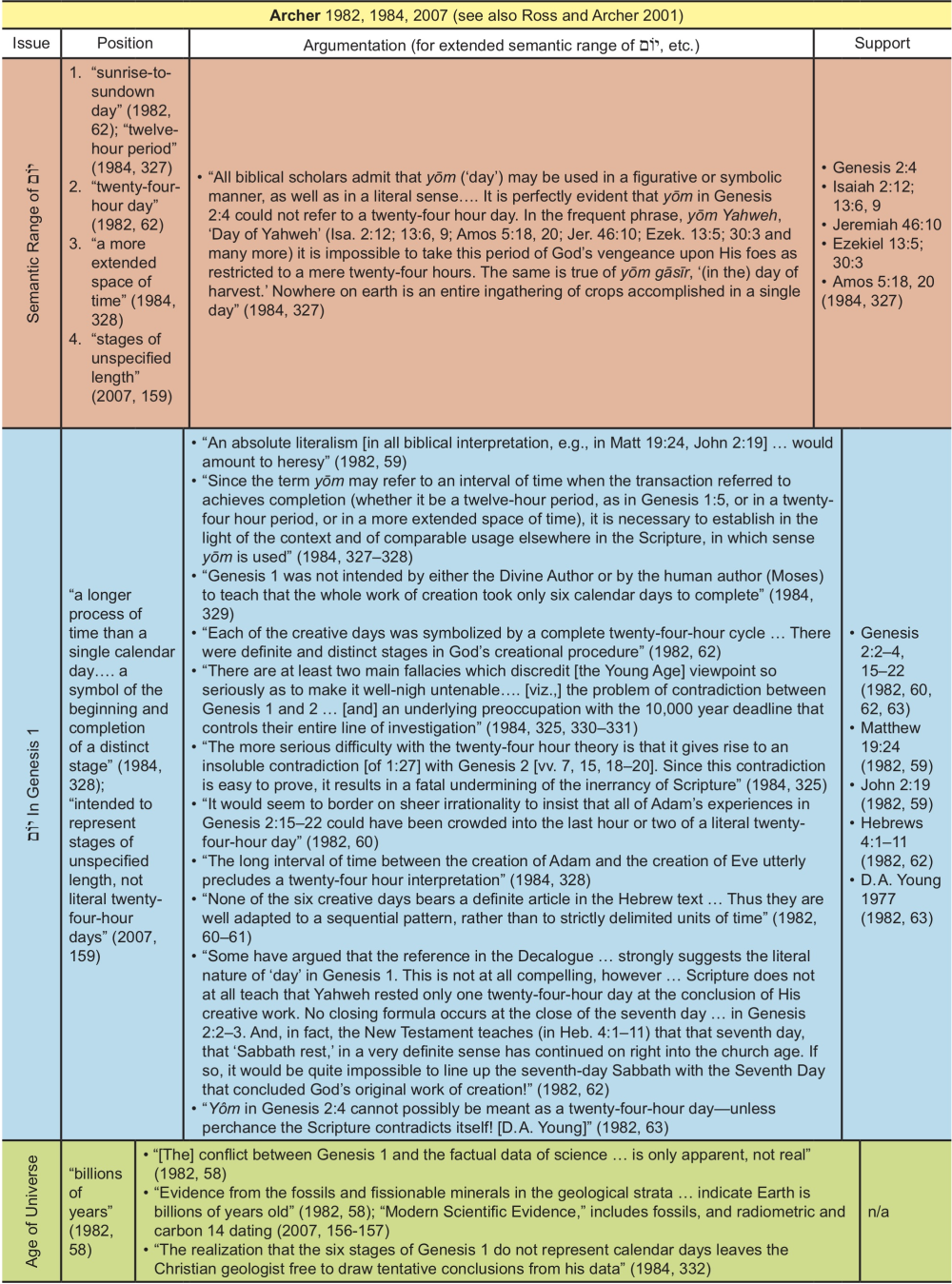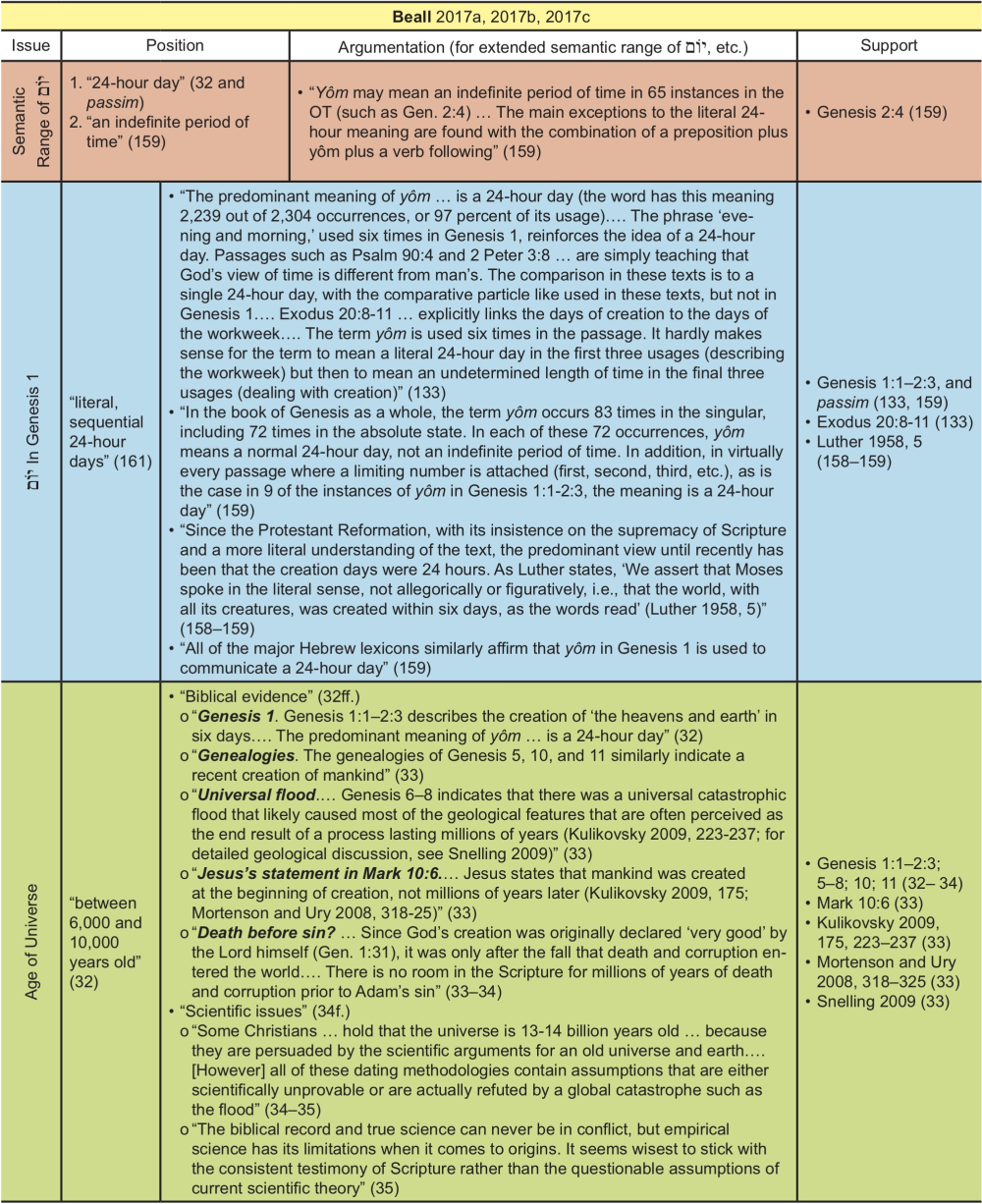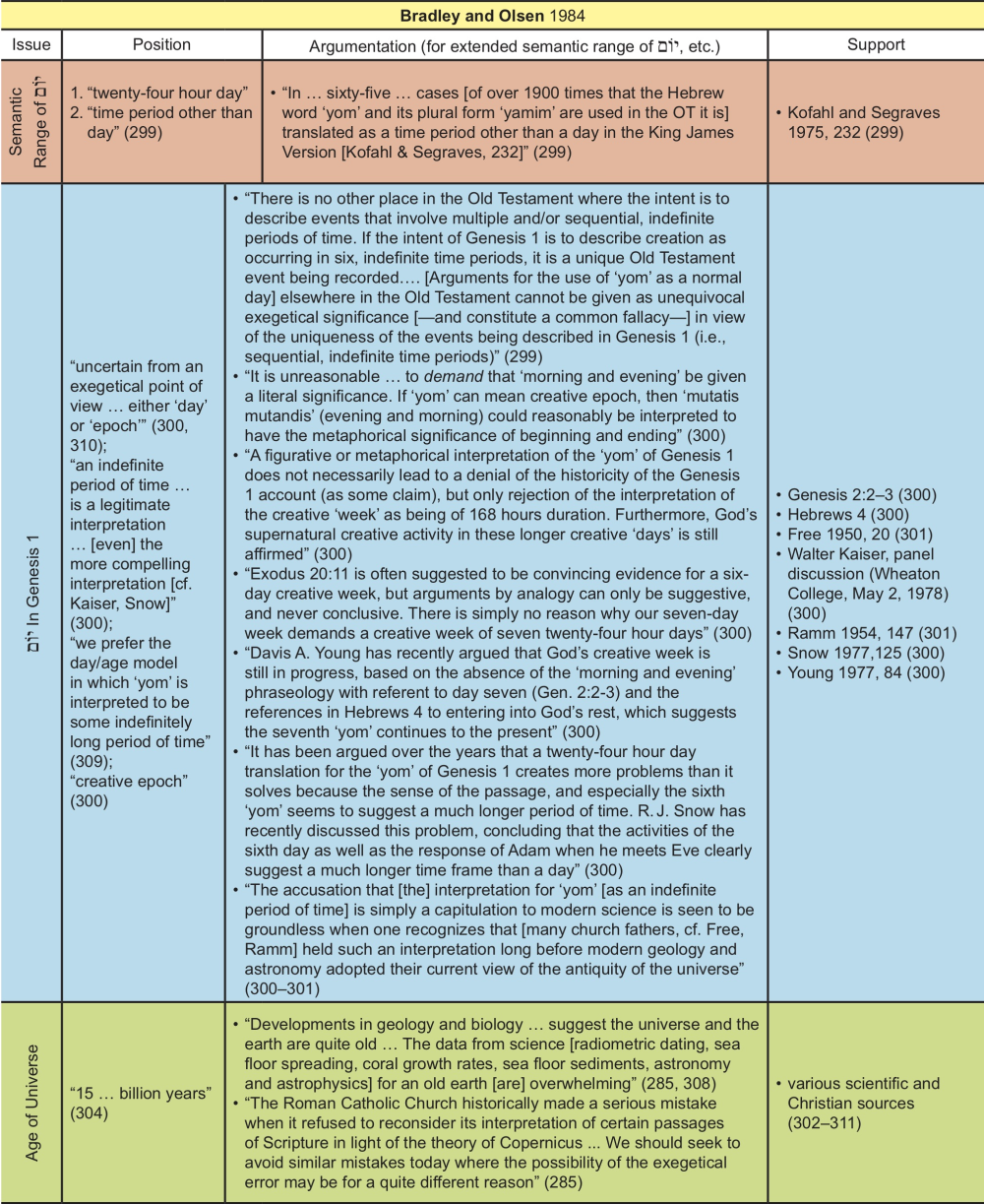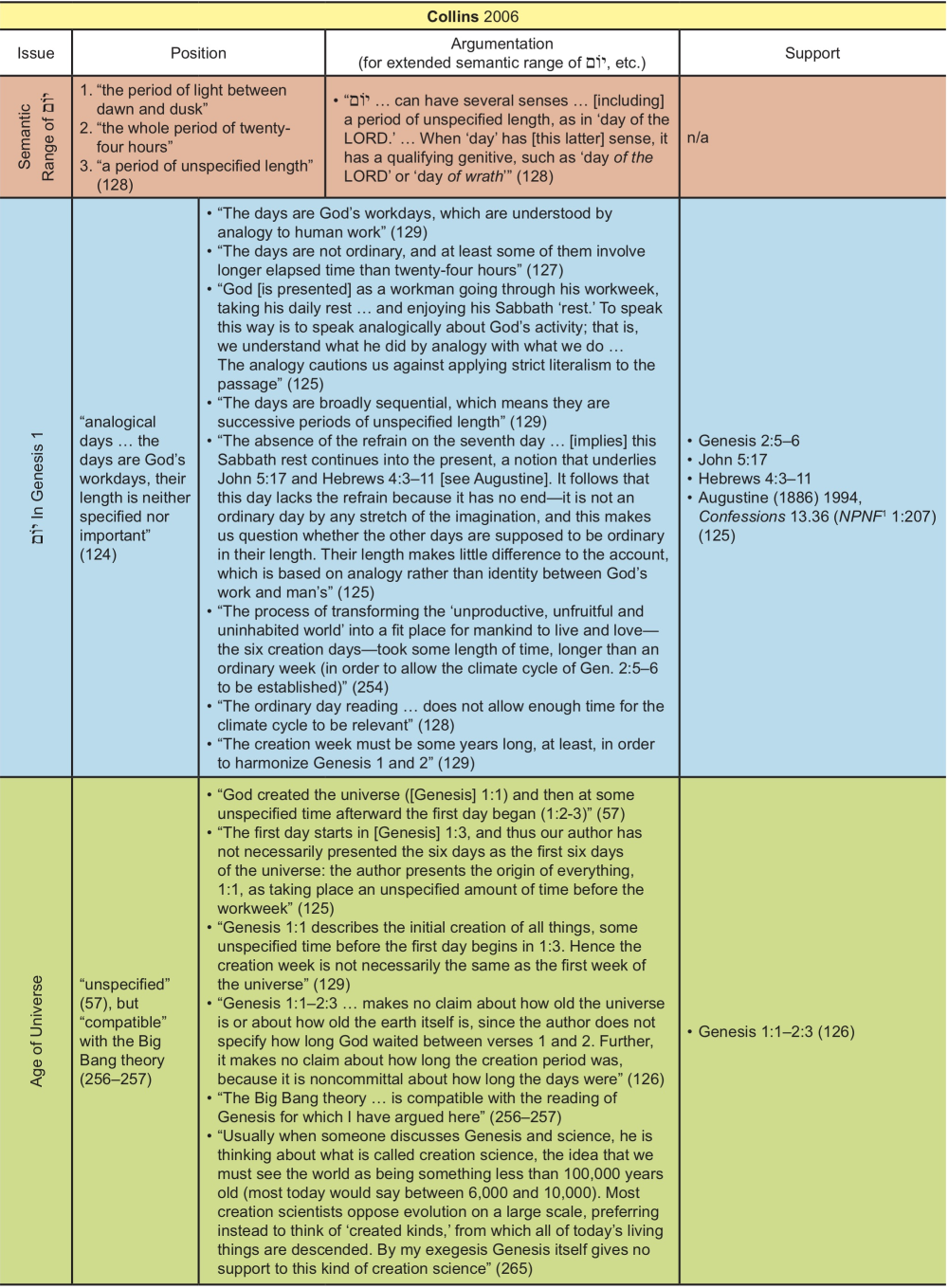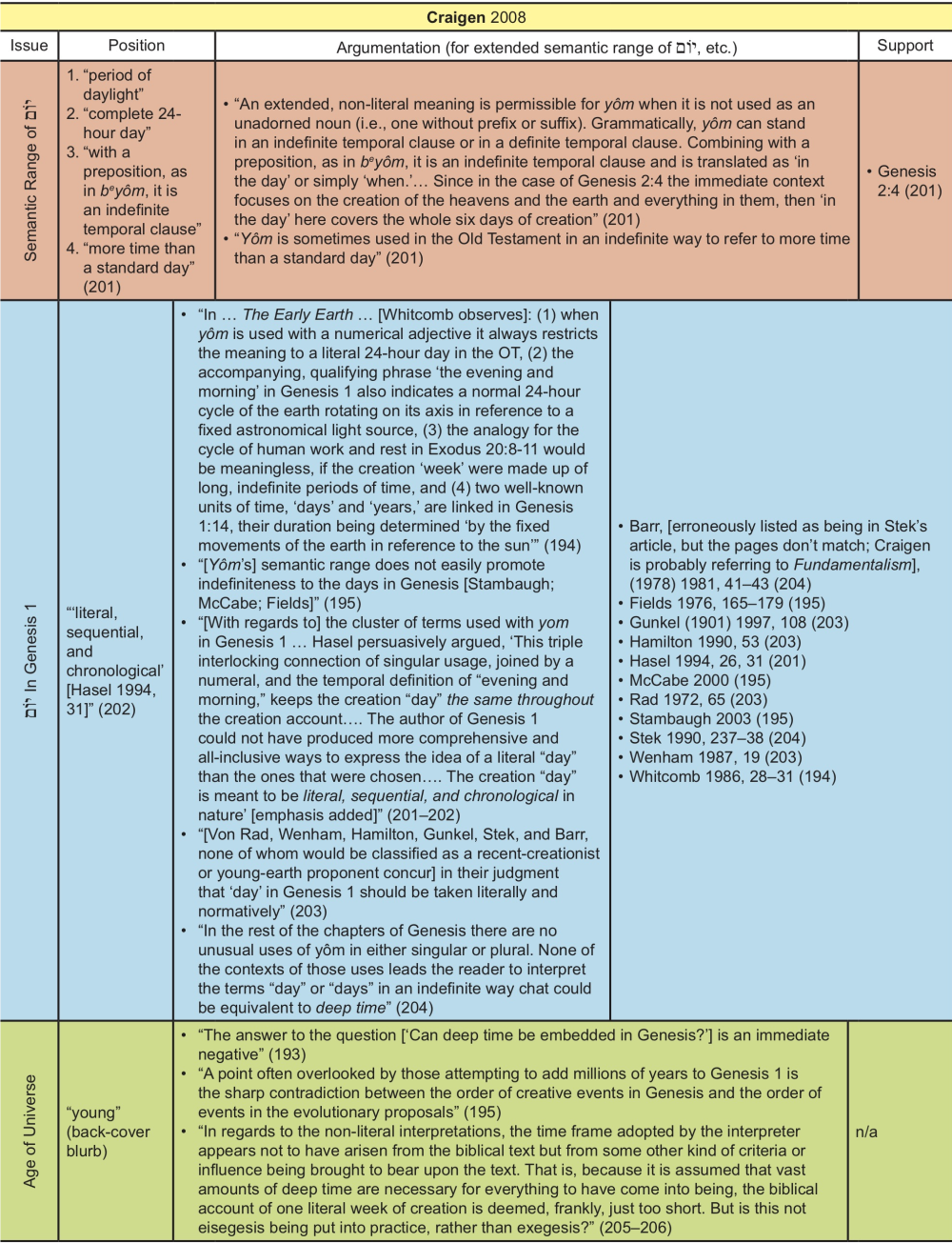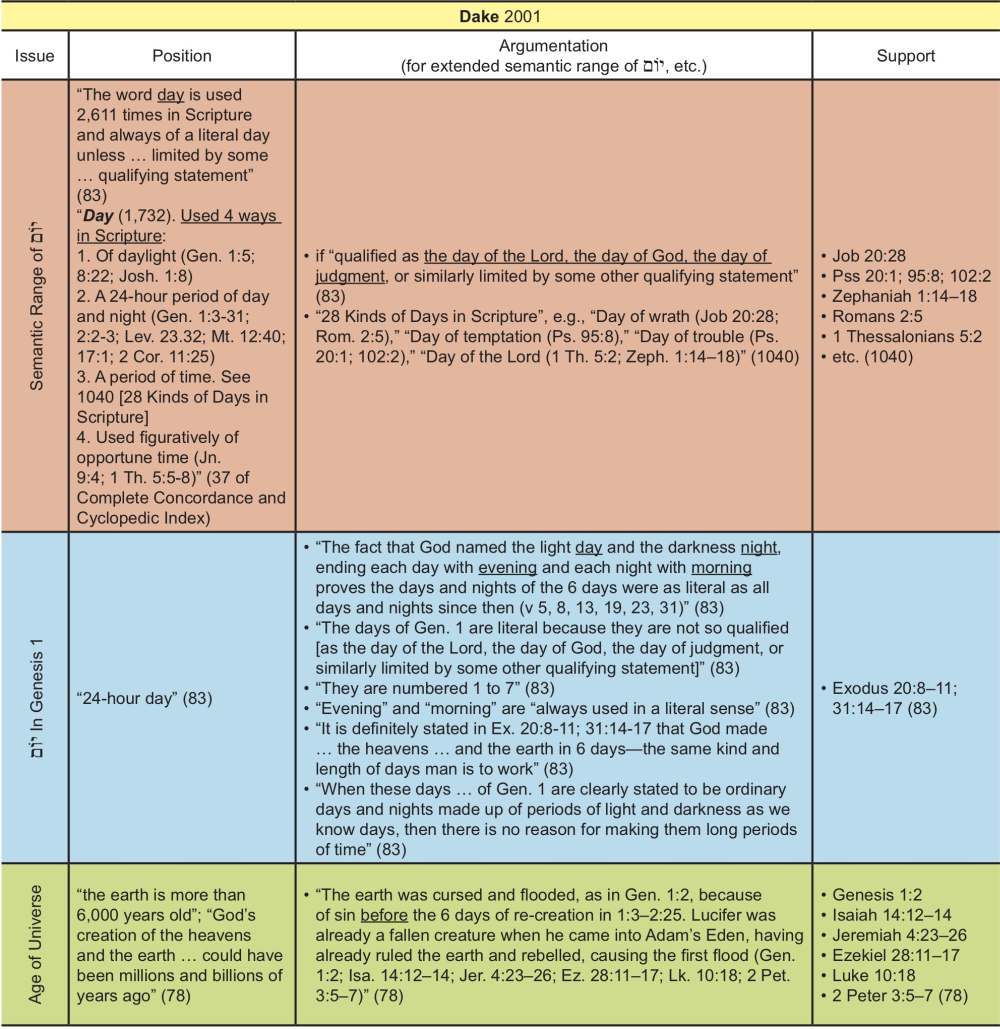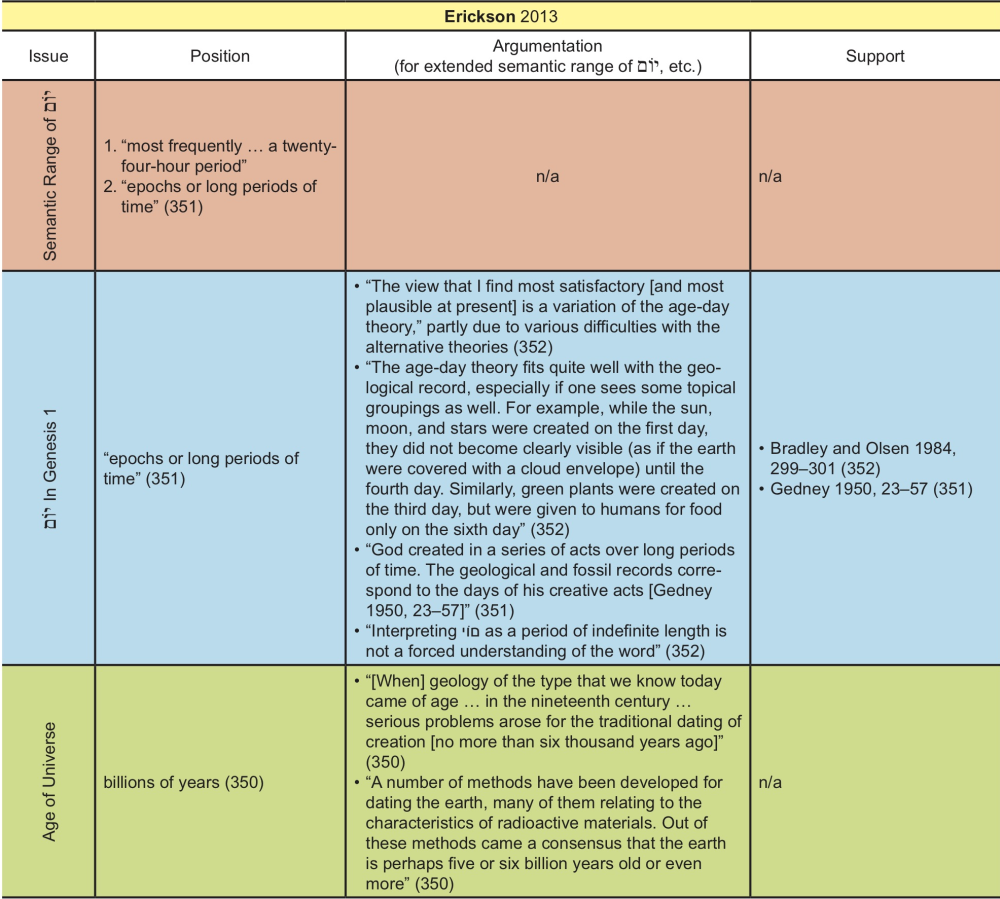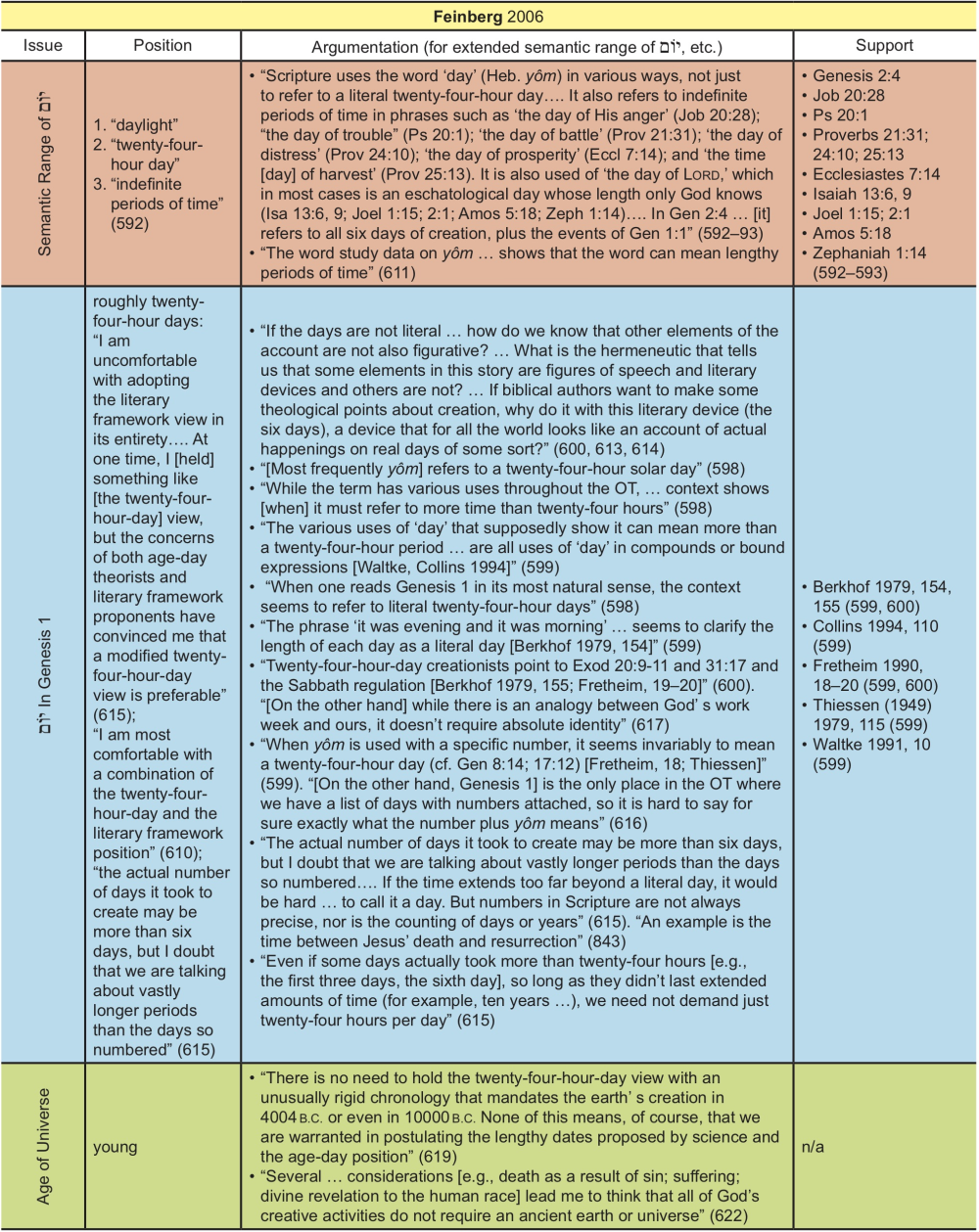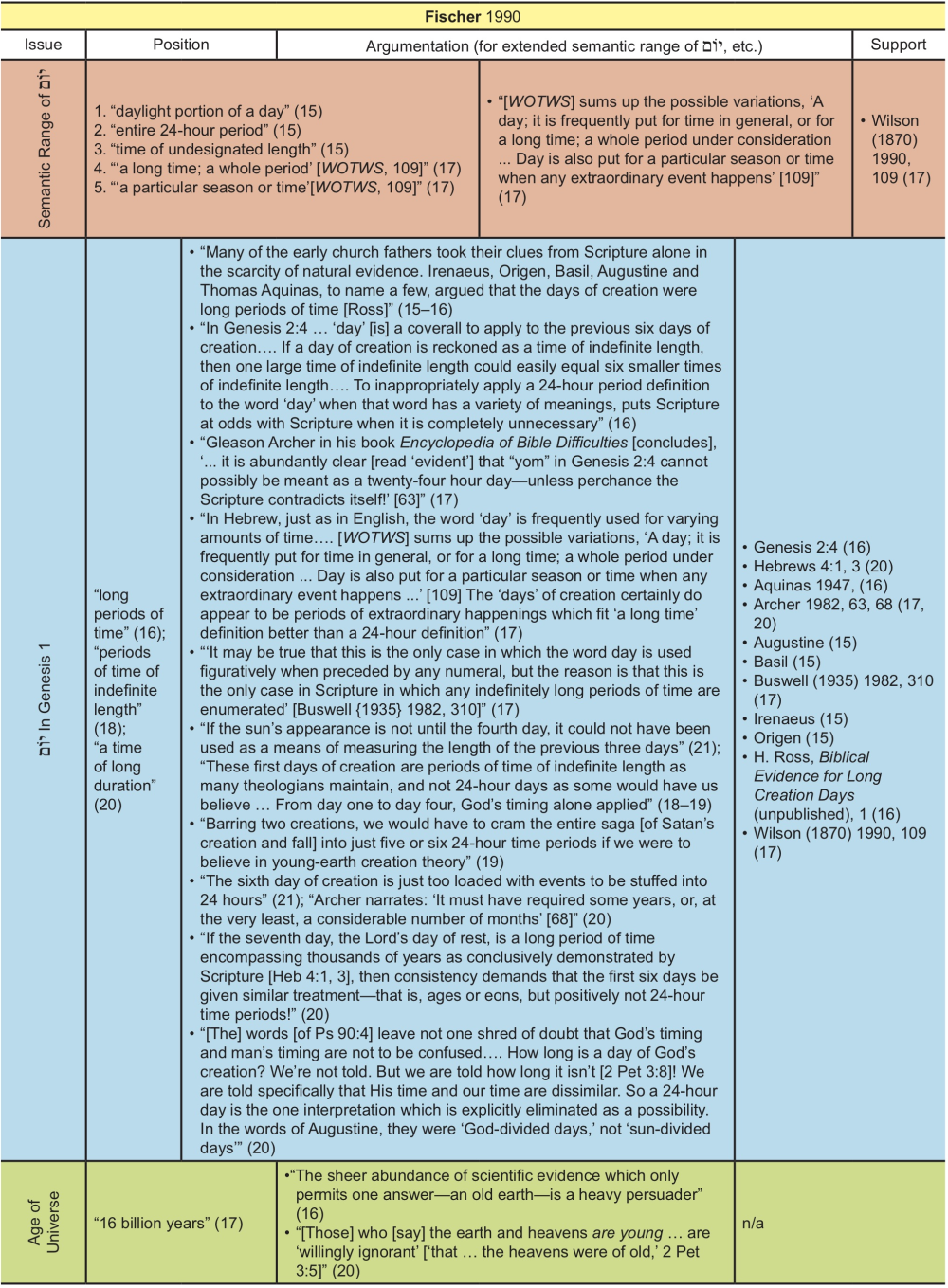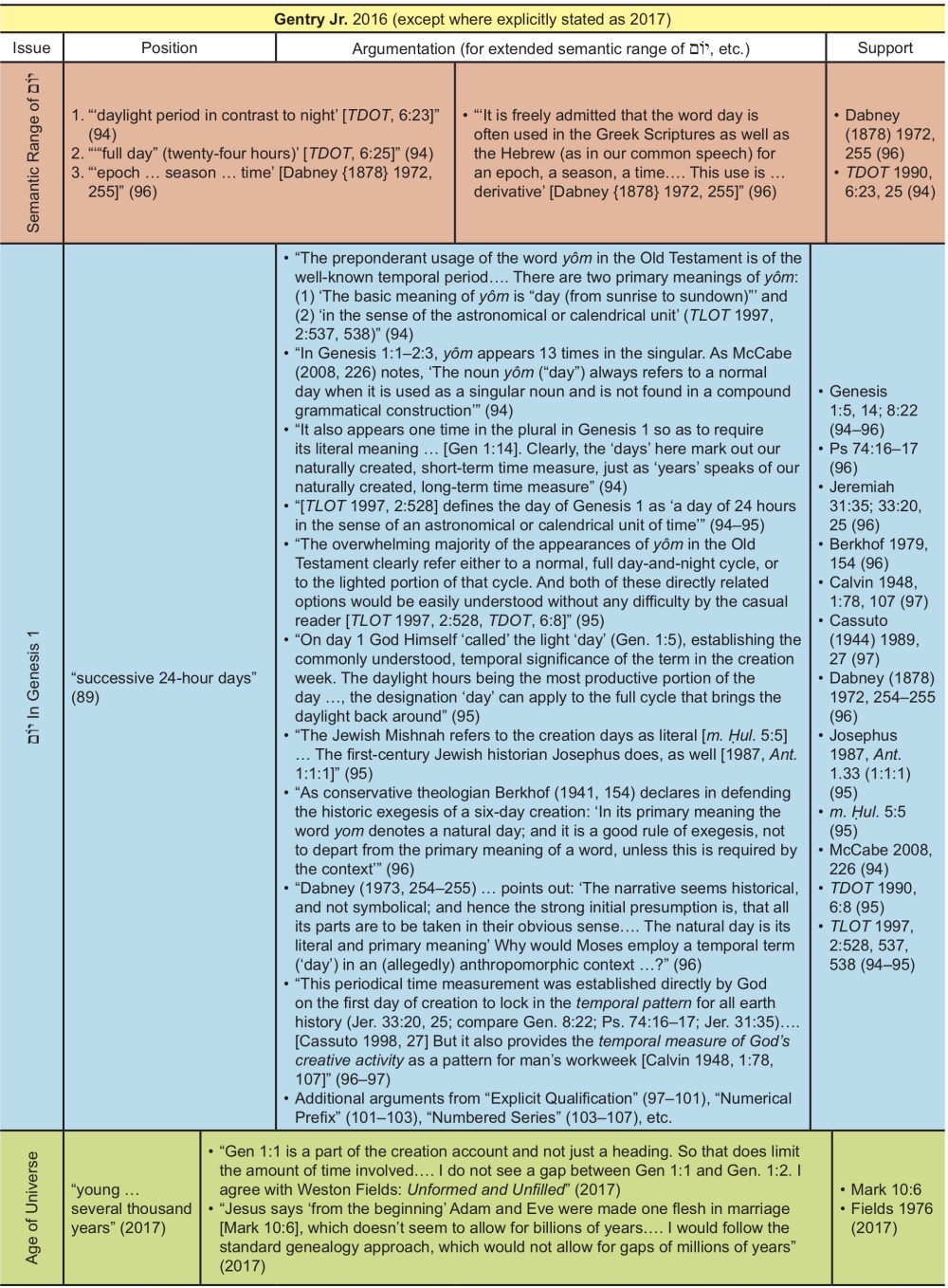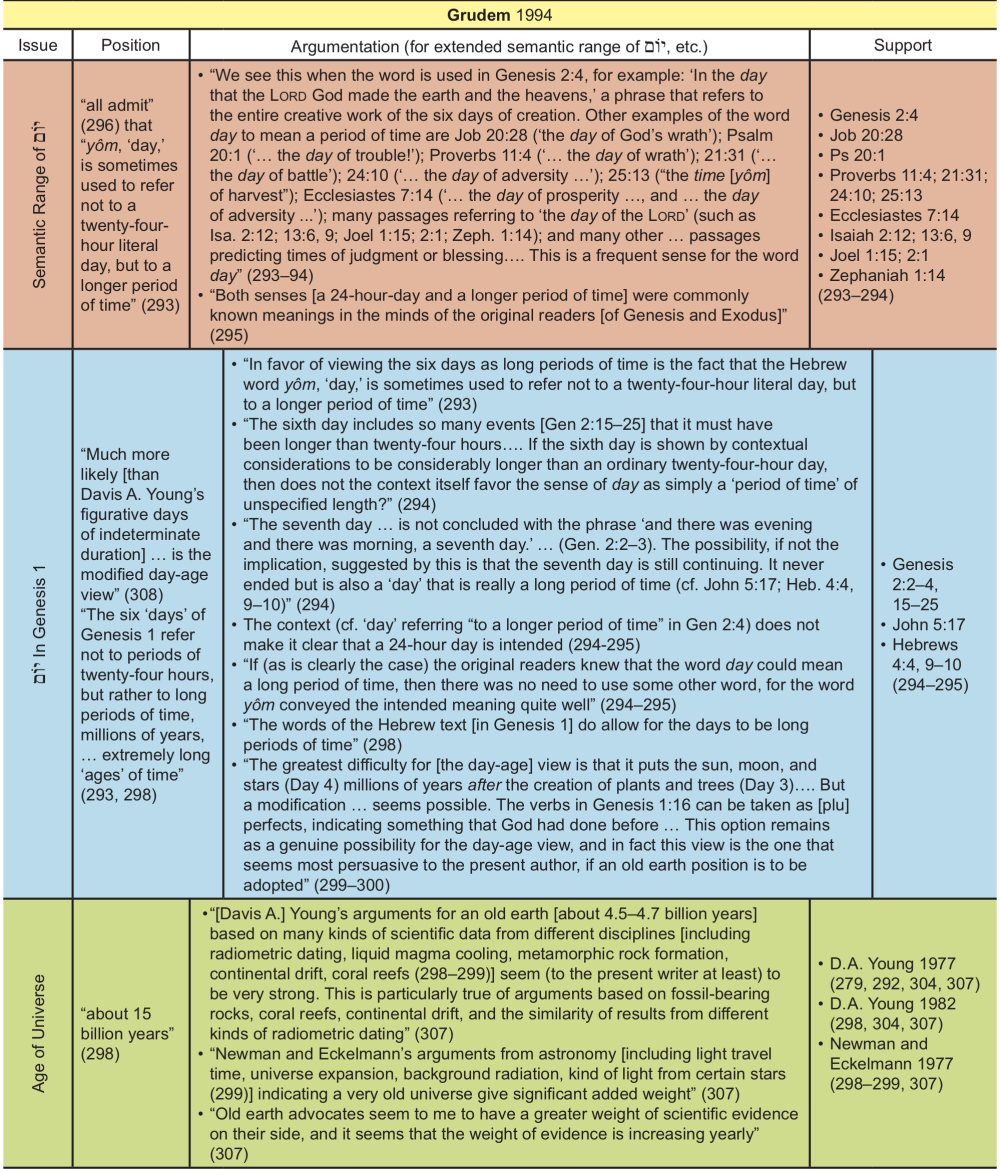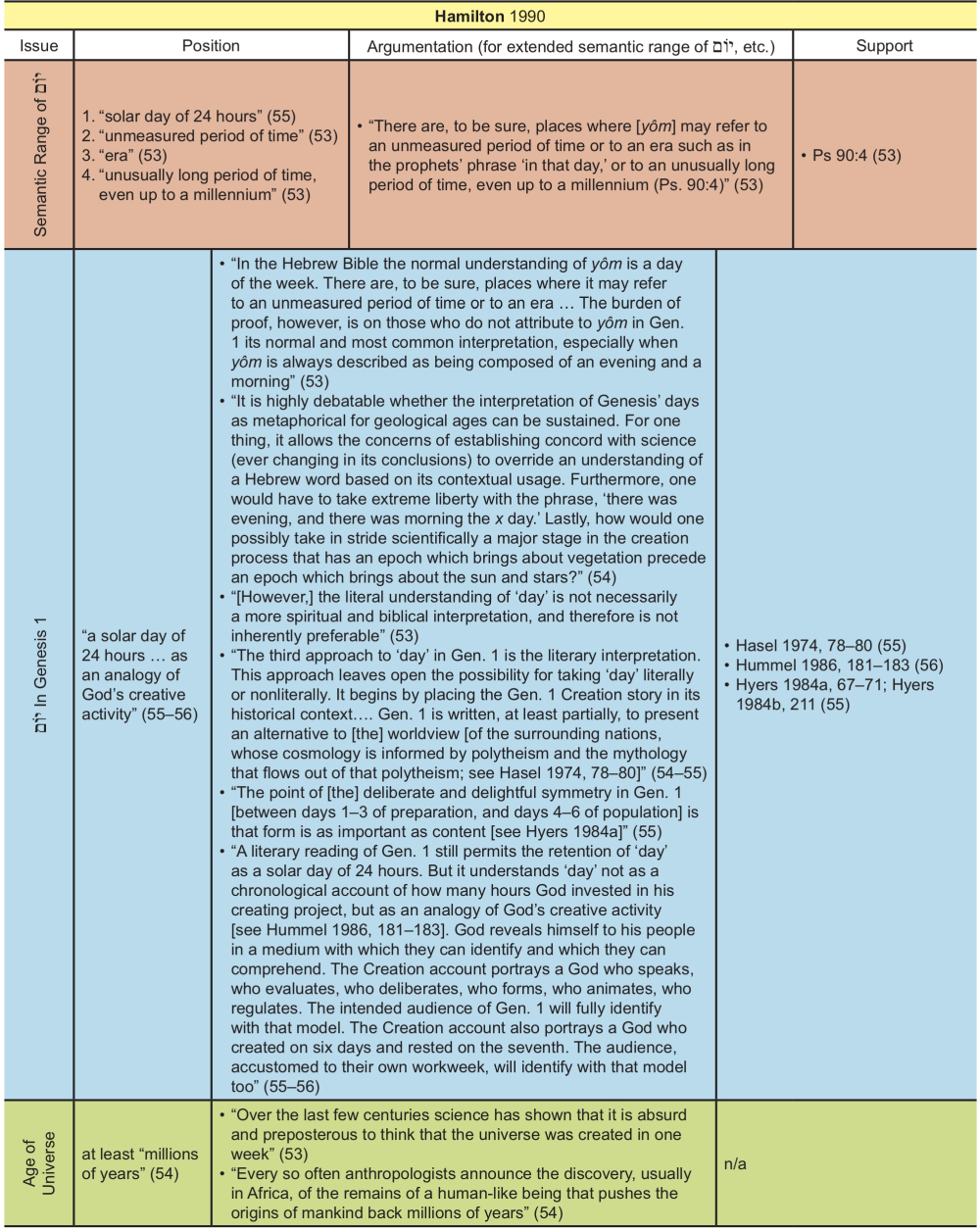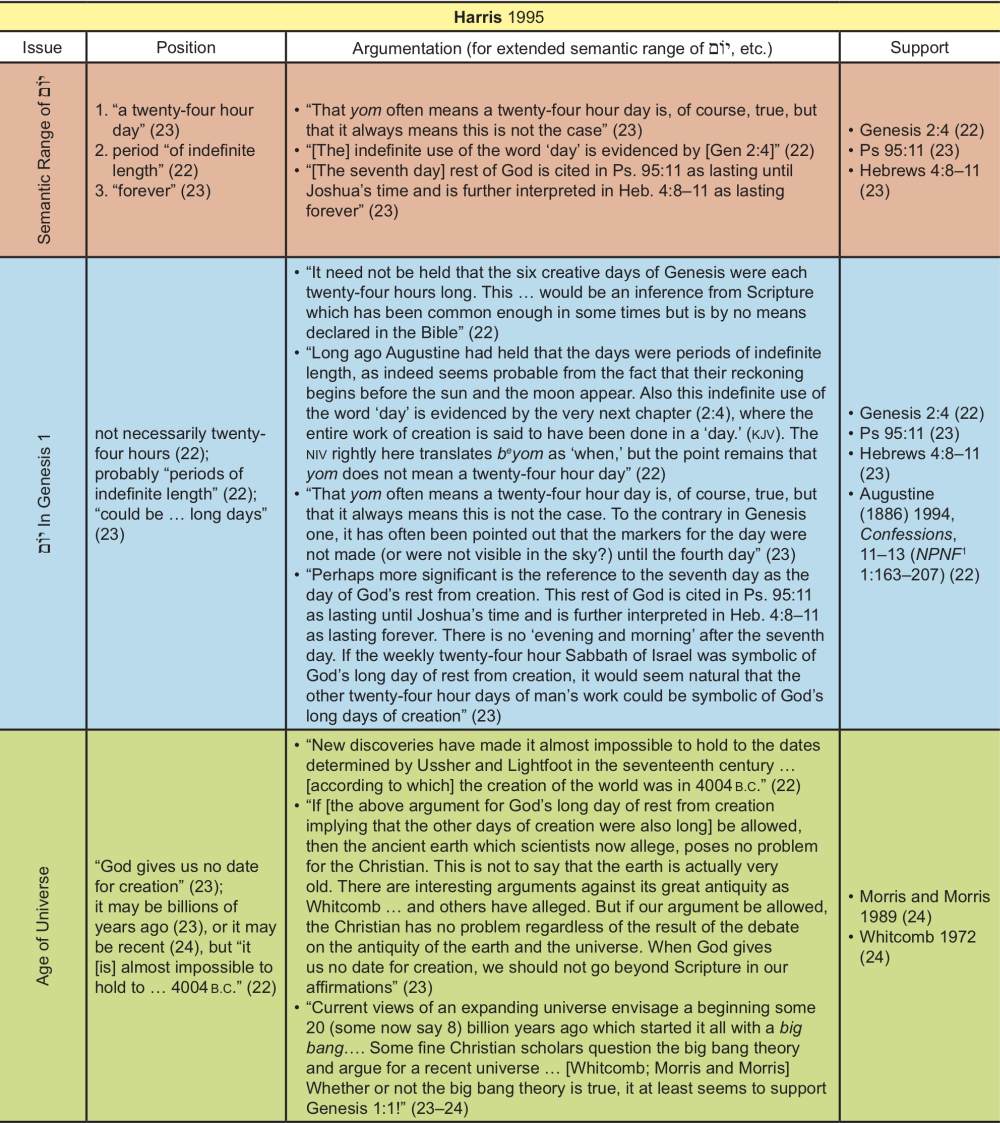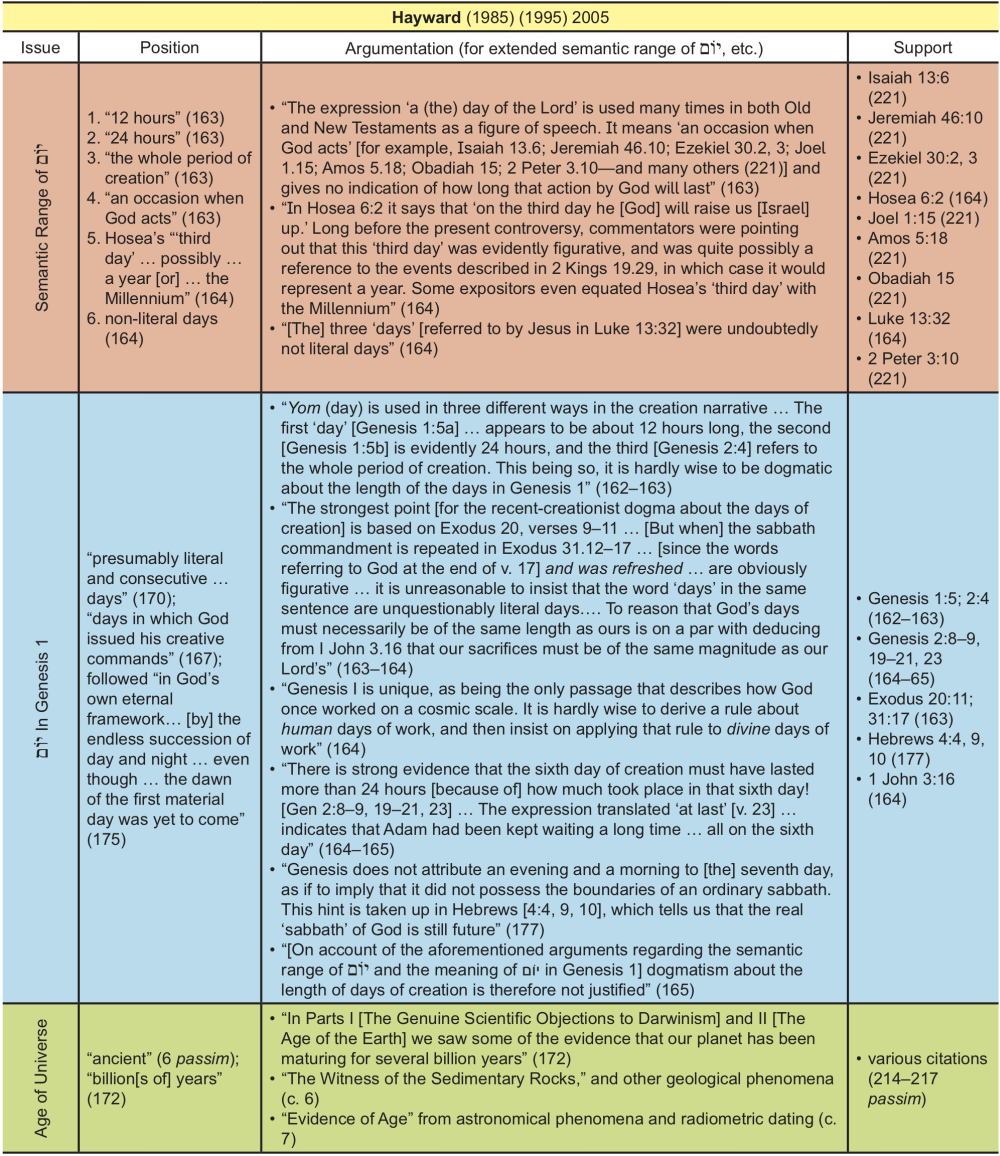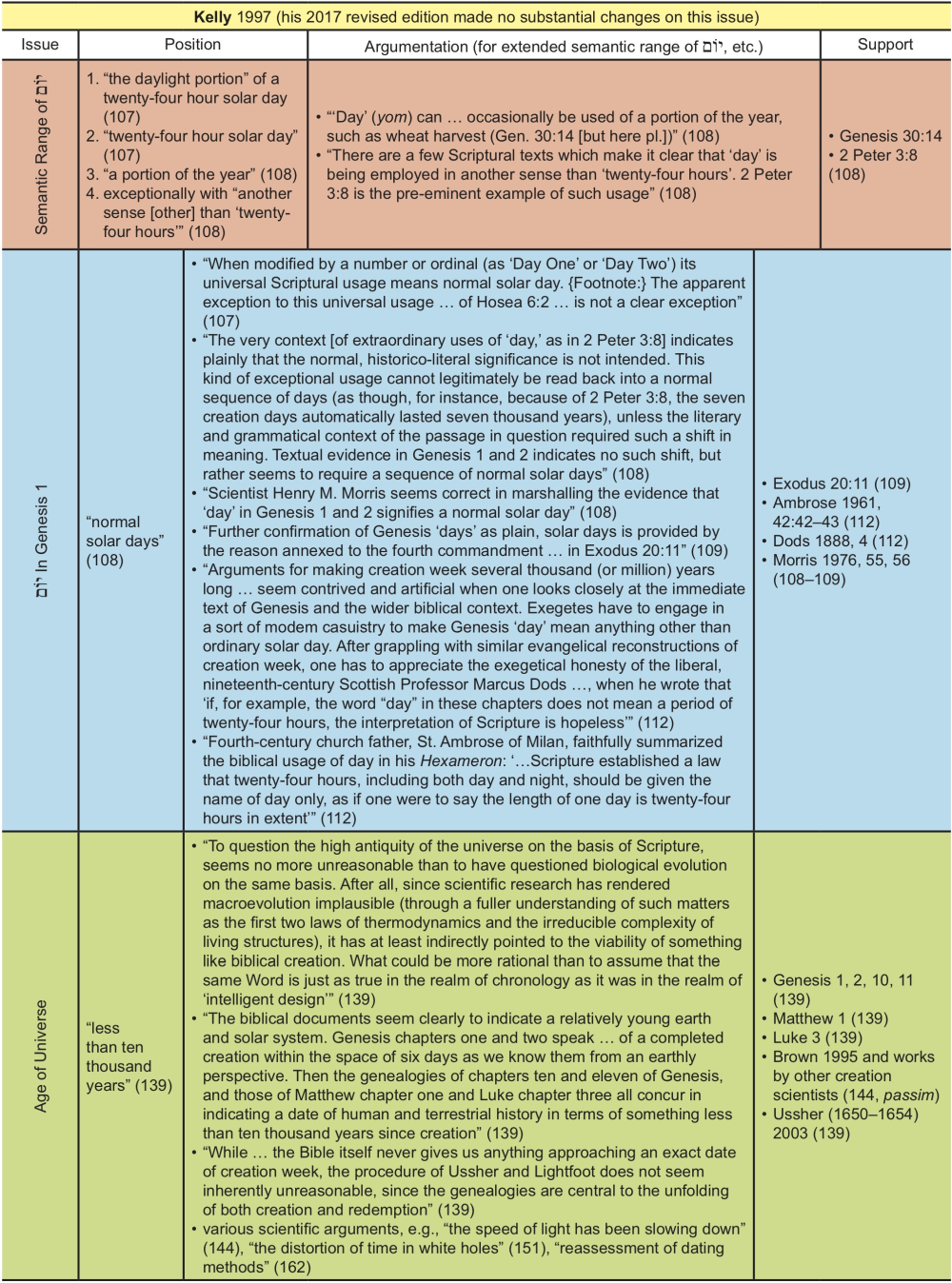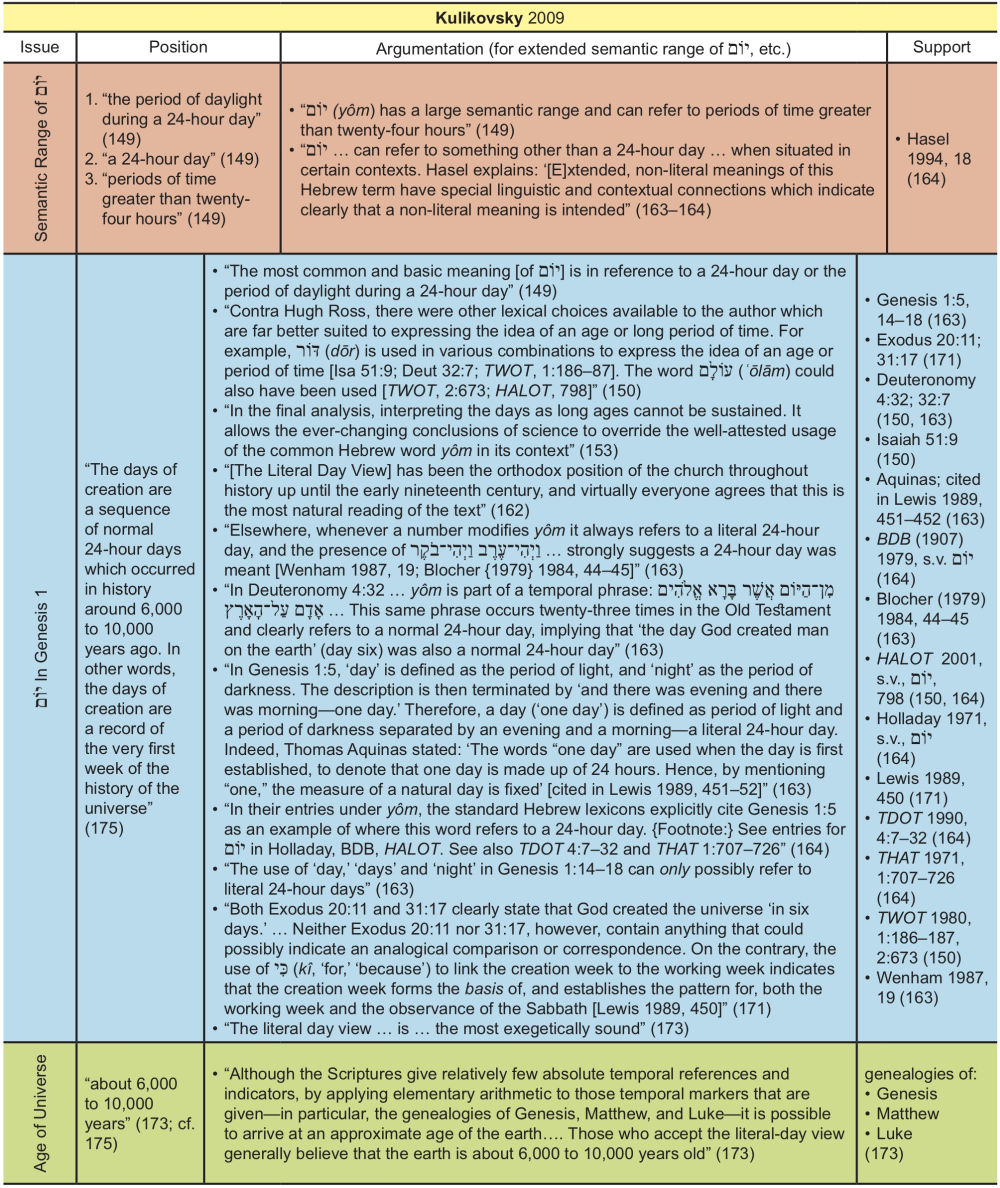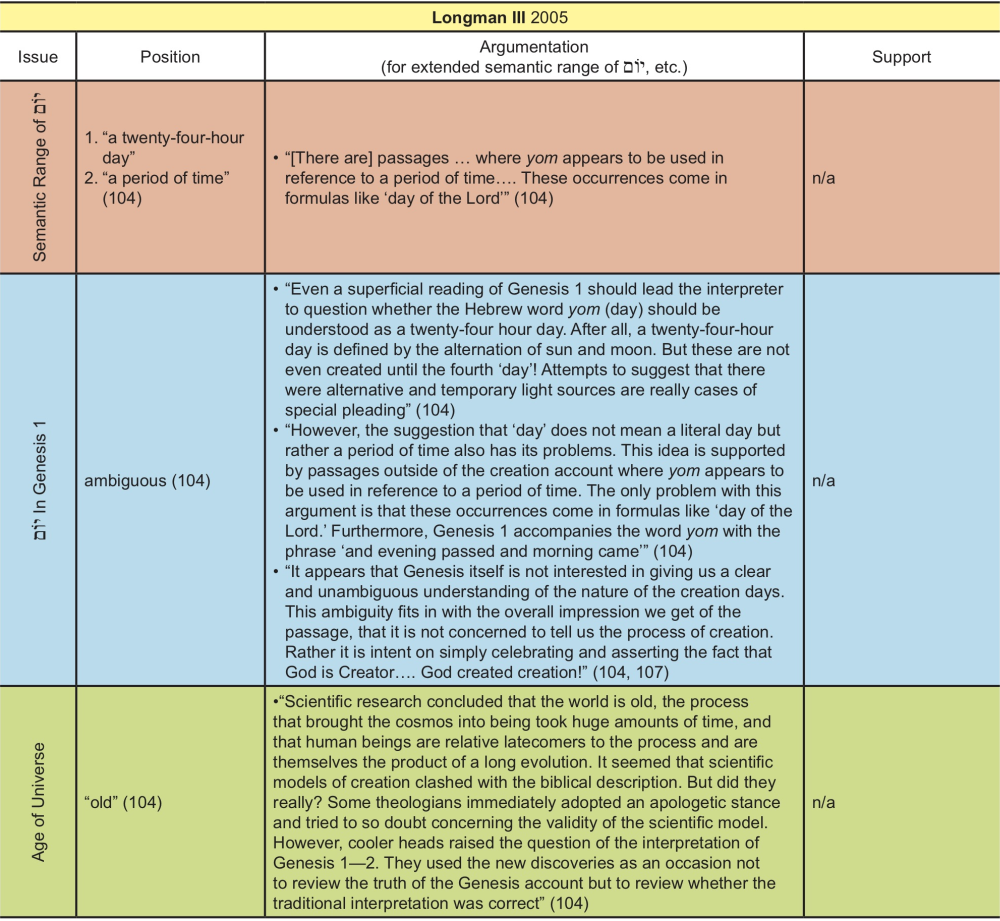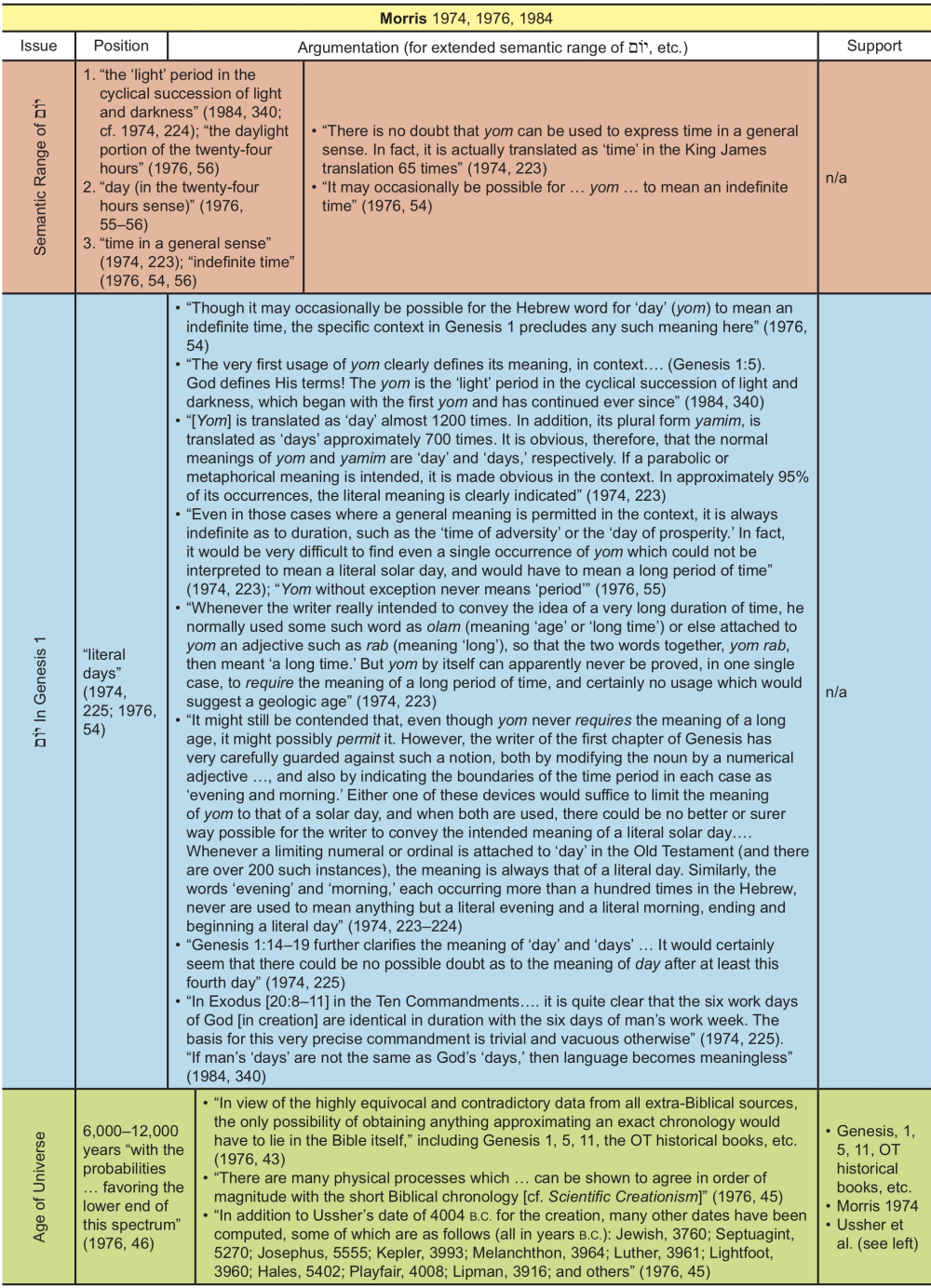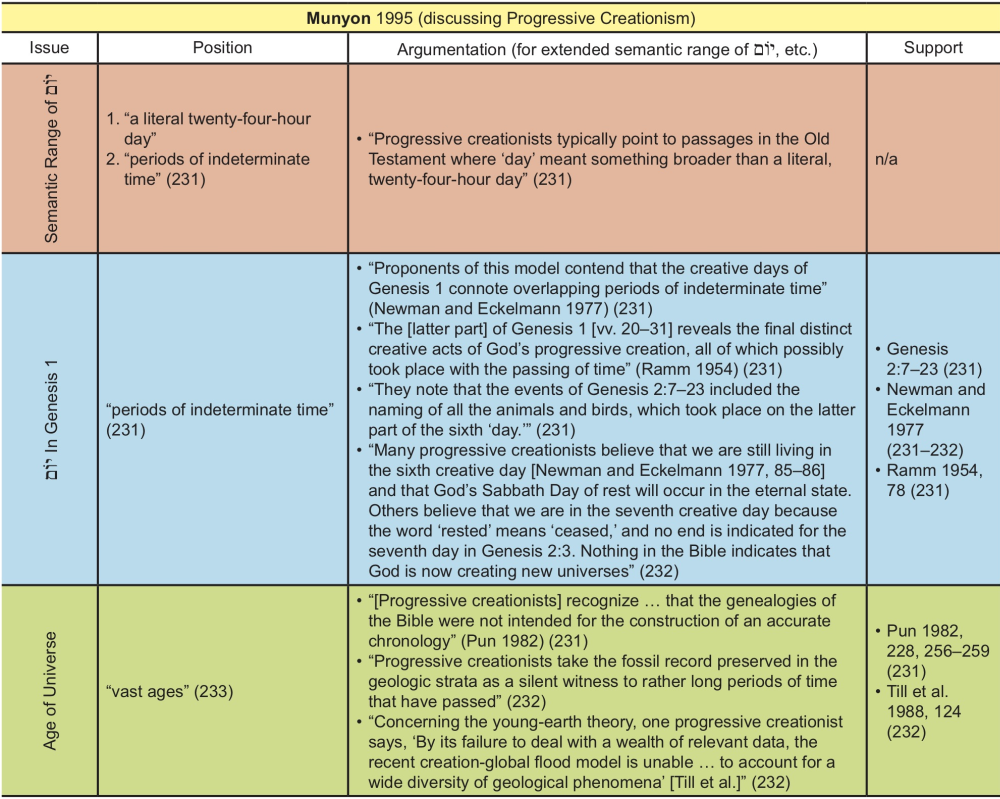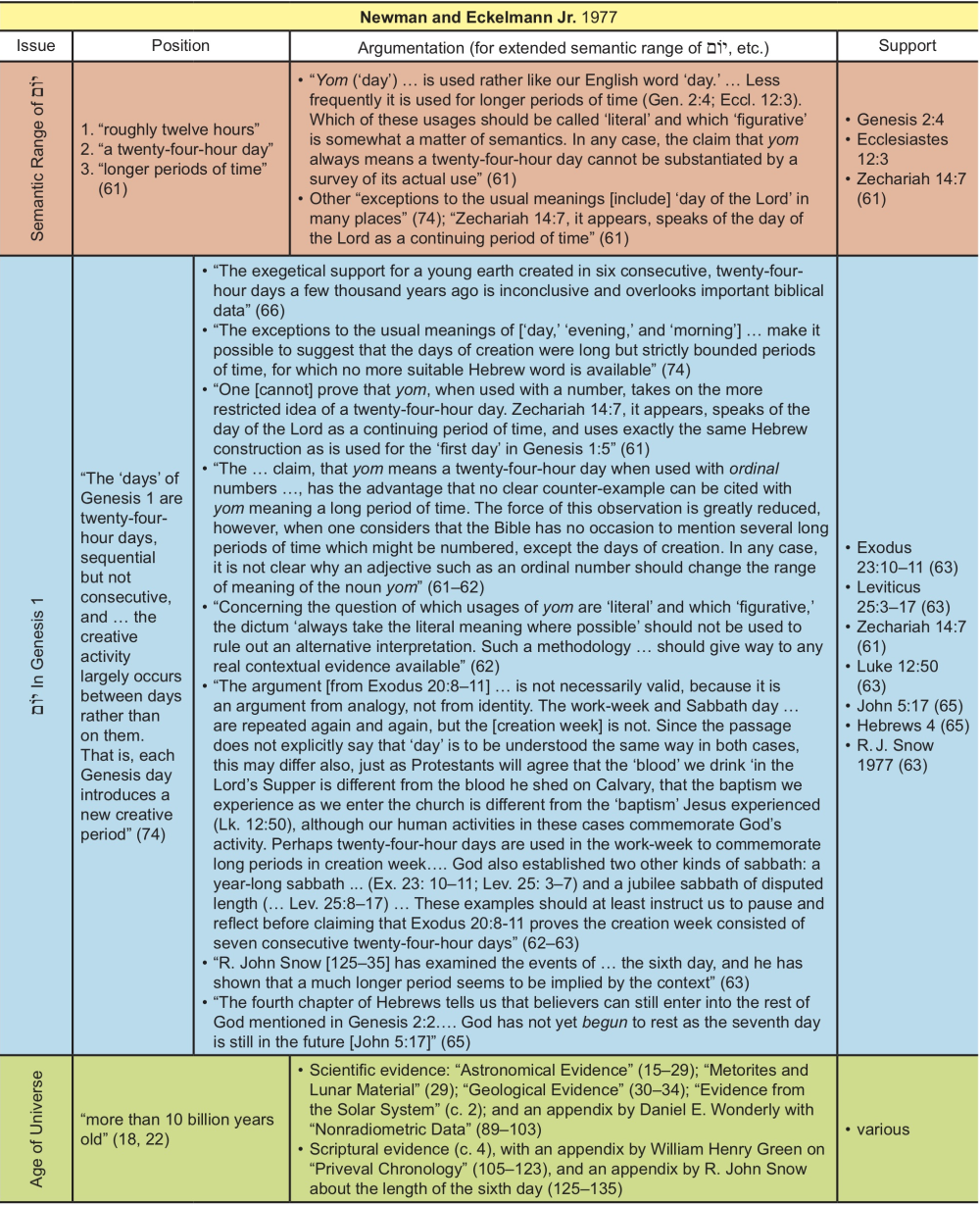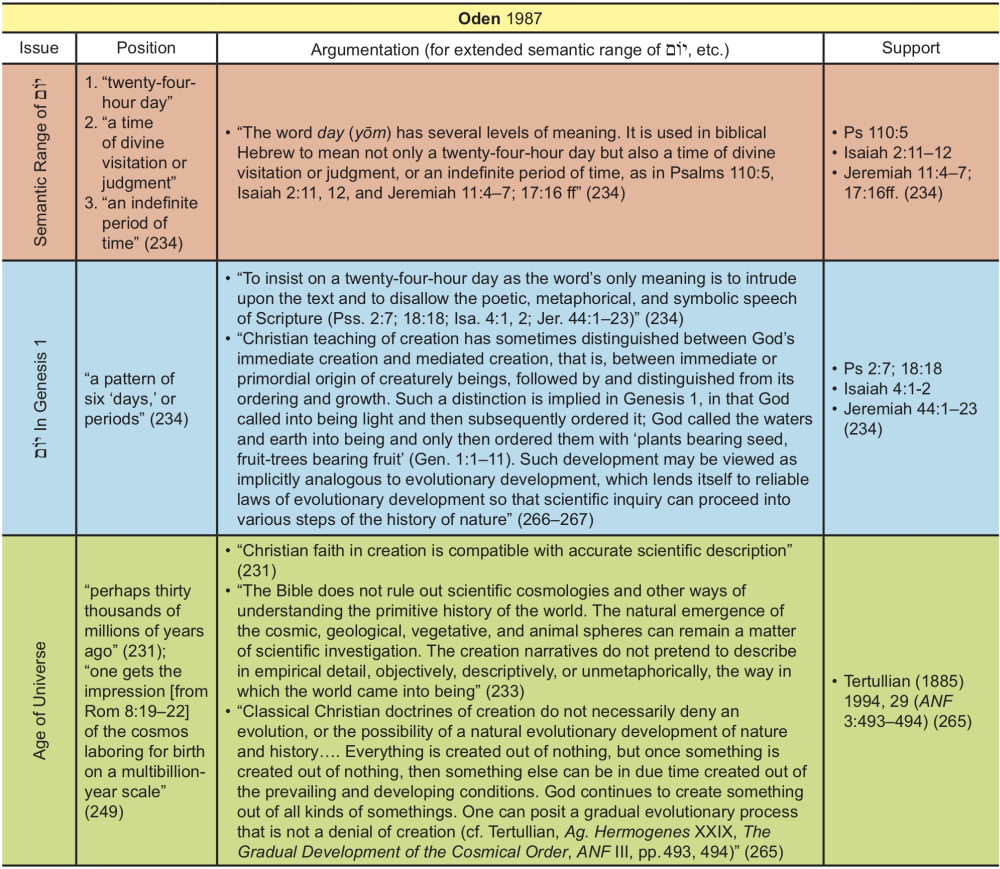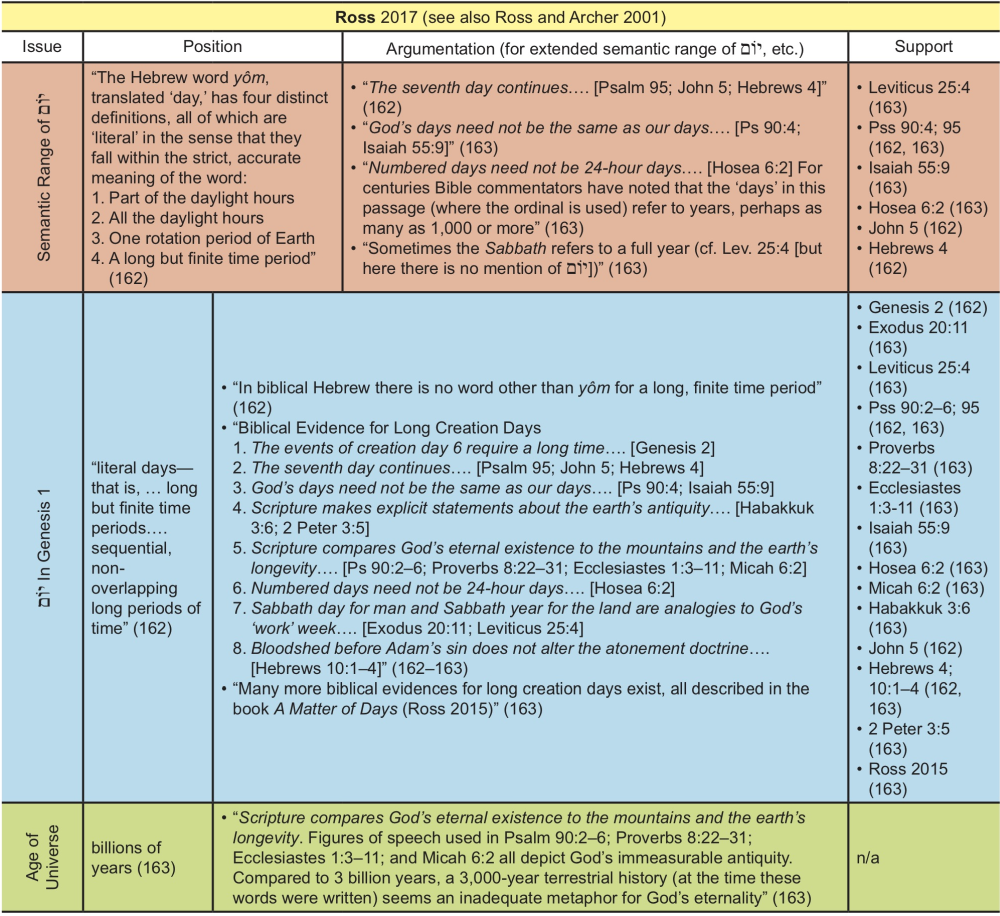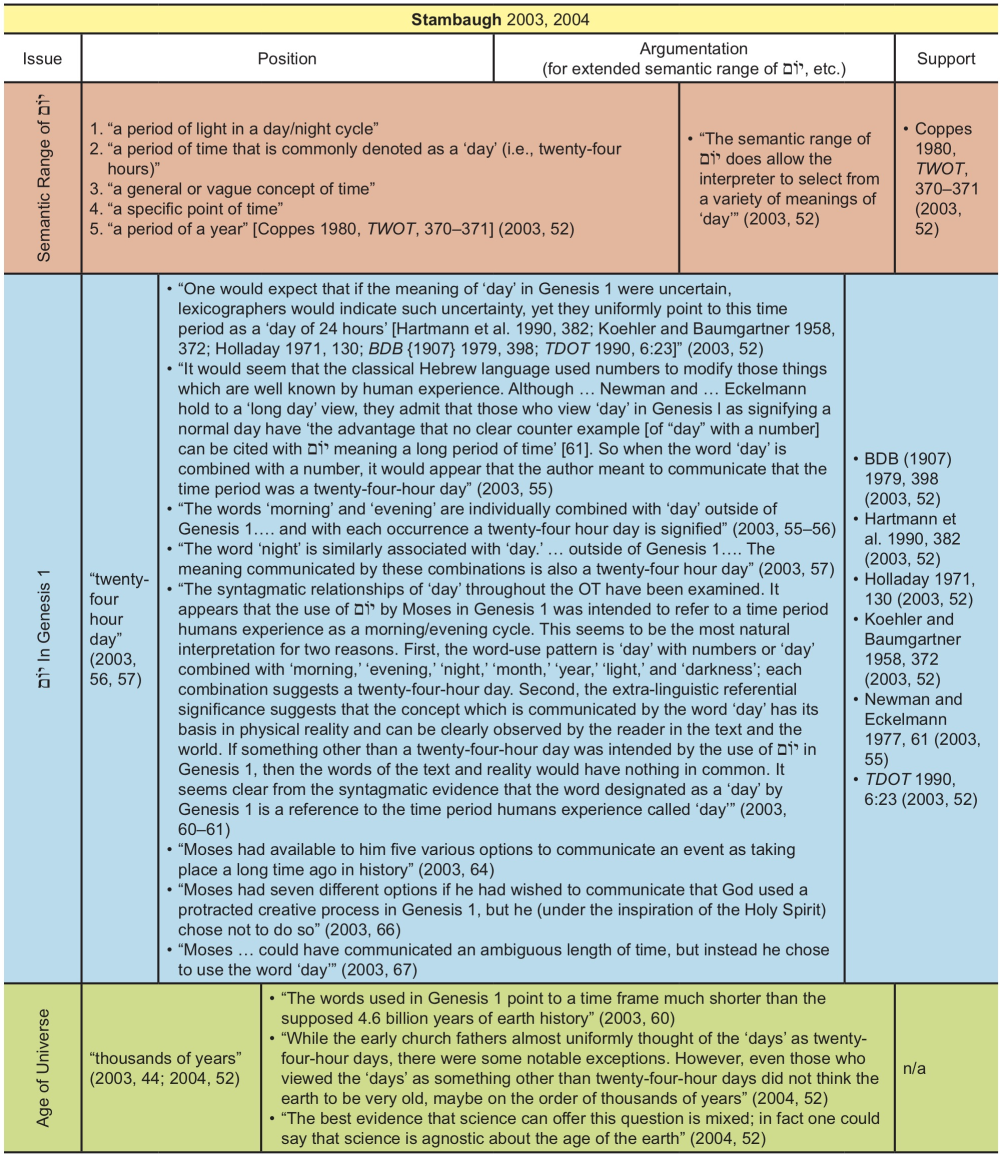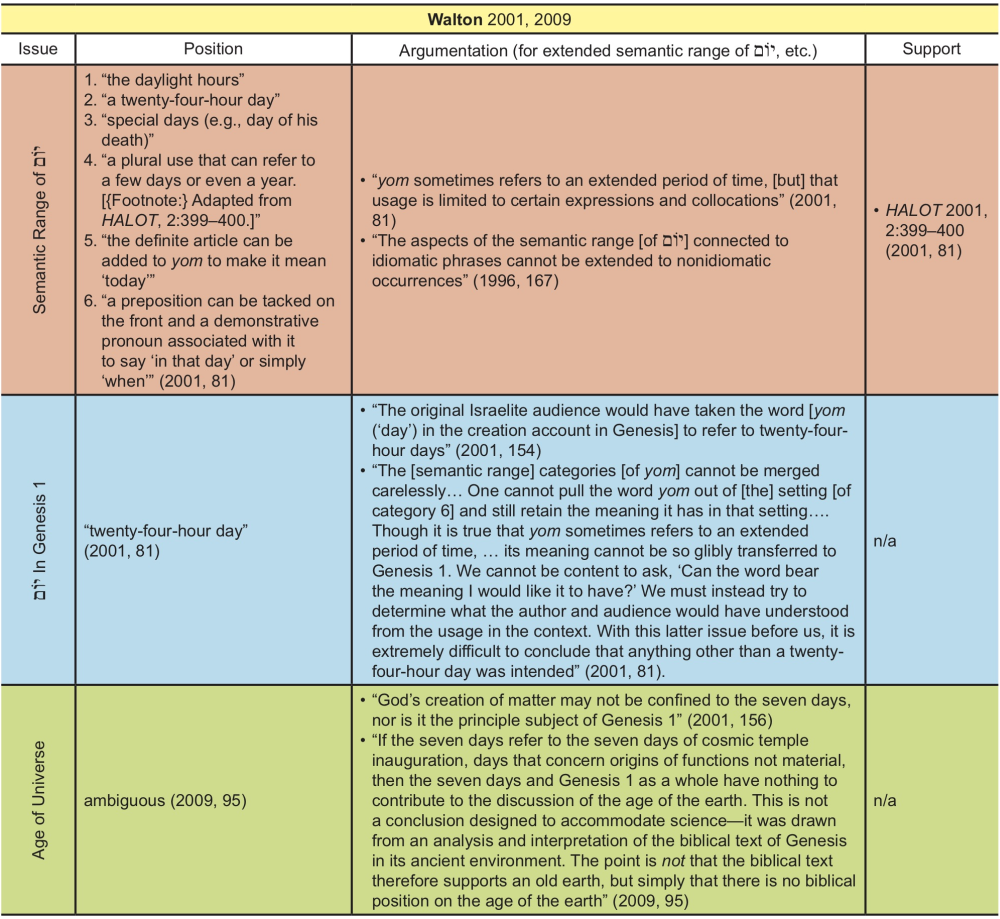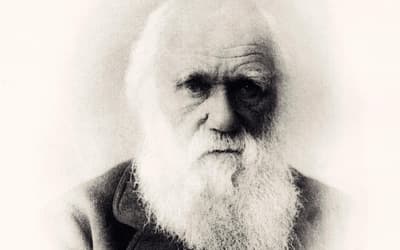The views expressed in this paper are those of the writer(s) and are not necessarily those of the ARJ Editor or Answers in Genesis.
Abstract
Before the Enlightenment, most theologians believed the earth was created in the space of a literal week, a notable exception (among others) being Augustine, who interpreted the days of creation figuratively. Most believed that the universe began sometime between approximately 3600 BC and 7000 BC. However, between the seventeenth and nineteenth centuries—with the growing acceptance of geological uniformitarianism and, later, Darwinian evolution—an increasing number of eminent scholars advocated a multi-billion-year-old universe and questioned the validity of the biblical account. In order to accommodate billions of years into the Genesis account of origins, theologians proposed a range of new interpretations. Some, such as the Gap Theory, sought to retain a literal understanding of יוֹם. Others, particularly the Day-Age Theory, maintained that the term had a broad semantic range that could include a sense of vast periods of time. Over the past two centuries, the issue of the meaning of יוֹם in relation to the age of the universe has been vigorously debated by many scholars, though ignored as irrelevant by others.
Following an introductory survey of the biblical, historical and theological, and linguistic contexts of this issue, the study looks at delineations and definitions of יוֹם in Scripture, and in lexical and other sources. The central analysis examines how the semantic range of יוֹם has been discussed in the context of the creation account and in relation to the age of the universe, both historically, and, more particularly, by 40 scholars (or teams of scholars) over the past 50 years. It is evident that a great variety of opinion exists regarding the semantic range of יוֹם. It is also clear that there is a considerable disconnection between lexicography regarding יוֹם and the formation of creation theology. Most respected lexical sources do not allow for a broad semantic range for יוֹם, yet many theologians believe it to be rather flexible.
Prologue
I am very thankful for having had the opportunity to do this study, which was facilitated through the guidance of Drs. Richard E. Averbeck and Eric J. Tully at Trinity Evangelical Divinity School.
I acknowledge with gratitude the kind granting of permission by Robert I. Bradshaw for inclusion of his data regarding early Jewish and Christian views on the length of the days of creation (see page 105).
Hebrew Bible quotations are taken from the text of the 1997 second edition of Biblia Hebraica Stuttgartensia (based on the Leningrad Codex B19A), as found in Accordance and BibleWorks, “which has been edited over the years to bring it into greater conformity with the Leningrad Codex” (BibleWorks, WTT Version Info). Both the Accordance and BibleWorks versions of BHS include the 2010 WTM Release 4.14.
Unless indicated otherwise, all Scripture translations into English are my own rendering.
Unless stated otherwise, all instances of emphasis within a quotation are those of the cited author. I have indicated wherever I have added my own emphases, except in the case of Scripture quotations. My preferred means of emphasis is italics. If the quotation already contains italics, then I resort to underlining (and specify so). Additionally, even where the quotation does not contain italics, I sometimes still use underlining for the sake of consistency with underlining in other nearby quotations.
Introduction
This work examines how scholars’ perceptions of the semantic range of יוֹם have affected their discussions of the age of the universe. While each of the key elements in this relationship—the semantic range of יוֹם and the age of the universe—have indeed been studied before, I am not aware of any other study that specifically focuses on the interaction between the two, across a range of scholarly works.
The subject of creation and origins is popular and is often vigorously debated. A key element of enquiry and discussion within this topic is the age of the universe. Some scholars feel that the Bible does not speak to the question of the age of the universe. Certainly, the Bible does not make any outright statement like, “The universe was created by God x thousand or million or billion years ago.” However, other scholars believe that the biblical text does indeed give indications concerning the age of the universe. In their interactions with the text, many such scholars make reference to the Hebrew word יוֹם usually translated “day,” which occurs fifteen times in the thirty-five verses of the Genesis creation account (Genesis 1:1–2:4). This work examines (1) how scholars have understood the semantic range of יוֹם —whether as always having a narrow, restricted sense, or as having a broad range of meanings across different contexts, or as somewhere in between these two extremes—and (2) how these perceptions have affected their discussions of the age of the universe. Must the word יוֹם always indicate a normal day, or can it refer to a longer period of time? Does its flexibility or inflexibility of meaning have anything relevant to say regarding the age of the universe according to the Genesis account of creation?
There are several reasons why this subject might be viewed as important. Within the Christian church there has been much discussion, sometimes heated and confused, on the issues of creation and, in particular, the age of the universe. It is often asked what the word יוֹם could potentially mean in Genesis. It would be helpful to gain a degree of clarity on the breadth of views regarding the semantic range of יוֹם —including those of lexicographers, theologians, and other scholars—and the kind of reasoning employed in their discussions of יוֹם with respect to the age of the universe. All of this could potentially aid people in making better-informed decisions about how they see the place of יוֹם within the creation debate, and in better understanding those with different opinions from their own.
Outside the Christian Church, many people view the Bible as irrelevant or unreliable, especially when it comes to science. Even some biblical scholars believe that the Genesis account of creation has little, if anything, that is pertinent or authoritative to say regarding modern science. The biblical word יוֹם in the creation account can be seen as irreconcilable with the prevailing view of origins. This work may help people understand the various ways that some biblical scholars, by engaging with the semantic range of the word יוֹם, have explained the Genesis account of creation as being relevant to the issue of the age of the universe.
This third part of the larger work presents the core of the study, the analysis of the works of forty scholars (or teams of scholars) published in (or translated into) English over the past fifty years, which mention the semantic range of יוֹם with reference to the age of the universe. The sources include monographs, creation theologies, Genesis commentaries, contributions to creation debates, and other scholarly works. Key data extracted from these works are tabulated in Appendix 1. Preceding the central analysis is a brief historical survey of interpretation, to show how the semantic range of יוֹם has been understood since biblical times, particularly in relation to the age of the universe. Then, reflection is made upon the findings of the central analysis, highlighting some of the main links, patterns, and trends in the relationships between scholars’ perceptions of the semantic range of יוֹם, and their discussions of the age of the universe. Finally, I draw salient conclusions from throughout the study.
יוֹם in Discussions of the Age of the Universe
The temporal focus of this study is 1967–2017. But before analyzing how יוֹם has been handled in discussions pertaining to the age of the universe over the past fifty years, we will briefly survey the history of interpretation of the days in the creation account prior to 1967.
Brief Historical Survey of Interpretation Prior to 1967
Old Testament Period
According to mainline conservative tradition, Genesis was written by Moses in the latter half of the fifteenth century BC (or a couple of centuries later, according to advocates of a late date for the exodus).1 Elsewhere in the Pentateuch (Exodus 20:11, 31:17), references to the time frame of creation use the same kind of terminology, viz., שֵֽׁשֶׁת־יָמִים֩ (“six days”) followed by a day of rest. While a number of scholars see the Exodus references as strong evidence that the days of creation are literal days, others are not convinced. Nevertheless, however we may understand the term, we can at least assert that Moses was consistent in using the word יוֹם in relation to the time frame of creation.
Throughout the rest of the Old Testament no further reference is made explicitly to the six days of creation, but neither is any alternative timescale mentioned. Thus, for approximately 1,500 years (or 1,300 years if following a late date for the Exodus) from the composition of Genesis up to the time of Jesus, there is no explicit biblical evidence that Israelites regarded the time frame of creation as being anything other than an ordinary week. If, as proponents of an old universe argue, Jewish tradition understood the term יוֹם to mean something other than an ordinary day, or understood there to be vast eons between or following the days of creation, such a tradition is lacking explicit evidence in the rest of the biblical canon.
New Testament Period
While there has been much debate about the form and completeness of genealogies in both Old and New Testaments, a straightforward reading of Luke 3:23– 38 links Jesus all the way back to “Adam, the son of God” (v. 38). Taken together with Jesus’ declaration about marriage partners, “But from the beginning of creation, ‘God made them male and female’” (Mark 10:6), this certainly gives the impression that Jesus and Luke regarded the creation of everything, including humans, as having taken place about eighty generations earlier. If there is another explanation, it is not immediately obvious. Moreover, while nothing explicit is mentioned by Jesus or the New Testament writers concerning their interpretation of יוֹם in Genesis 1, neither do they give any indication that they interpreted the days of creation in anything other than their ordinary sense. Terry Mortenson (2008, 342) concludes, “There is nothing in [Jesus’] teachings that would support an old-earth view (that Adam was created long ages after the beginning of creation).”
Regarding the common reckoning of a day in the New Testament period, D. A. Carson (1991, 156–157, underlining added) comments,
Counting the hours from midnight to noon and noon until midnight … is alleged to be the ‘Roman’ system, unlike the Jewish system which counts from sunrise to sunset (roughly 6:00 a.m. to 6:00 p.m.). But the evidence in support of a Roman system for counting hours turns out to be unconvincing. The primary support is from Pliny the Elder; but all he says is that Roman priests and authorities, like the Egyptians, counted the official day, the civil day, from midnight to midnight—useful information in leases and other documents that expire at day’s end. Nowhere does he suggest that any of his contemporaries count the hours of a day from midnight; indeed, he says that ‘the common people everywhere’ think of the day running from dawn to dark. Jews, Romans and others divided the daylight ‘day’ into twelve hours.
2 Peter 3:8b (and Psalm 90:4)
Advocates of a broad semantic range for “day” very often point to Peter’s allusion (in 2 Peter 3:8b) to Psalm 90:4. Because of the ubiquity of this line of reasoning, and because of its relevance to this thesis, I will discuss it below in some detail.
In the Greek Bible, the phrase χίλια ἔτη (“a thousand years”) is found together with ὡς (“as”) only in LXX Ps 89:4 (equivalent to HB 90:4), and in 2 Peter 3:8b. In Psalm 90:4 (LXX 89:4) Moses writes, “For a thousand years in Your eyes are as yesterday when it passes, or a watch in the night,” and the apostle comments, “With the Lord one day is as a thousand years, and a thousand years as one day” (ESV).
James L. Kugel (2007, 50) explains—with reference to the problem of both the six-day time frame in Genesis 1, and God’s promise in Genesis 2:17 that Adam would die on the day that he ate of the forbidden fruit—that, for some,
The answer suggested by Ps. 90:4 was that the days mentioned in the creation of the world were days of God, a thousand-year unit of time known to Him and quite independent of the sun. The world was thus really created over a period of six thousand years. This idea is alluded to in a number of ancient texts: apparently, it simply became common knowledge that a ‘day of God’ lasts a thousand years.
In support of this notion, in addition to 2 Peter 3:8b, Kugel (2007, 50) cites the following:
- “For with Him a ‘day’ signifies a thousand years,” Letter of Barnabas 15:4
- “Adam died … and he lacked seventy years of one thousand years [that is, he died at the age of 930]. One thousand years are as a single day in the testimony of heaven; therefore it was written concerning the tree of knowledge, ‘On the day that you eat of it, you will die,’” Jubilees 4:29–30
- “It was said to Adam that on the day in which he ate of the tree, on that day he would die. And indeed, we know that he did not quite fill up a thousand years. We thus understand the expression ‘a day of the Lord is a thousand years’ as [clarifying] this,” Justin Martyr, Dialogue with Trypho, 81:3.
While the phraseology and context of the latter three clearly demonstrate that the authors interpretively equated “day” with “a thousand years,” the same cannot so readily be said of 2 Peter 3:8b, particularly when read in light of Psalm 90:4.
The precise phraseology in Psalm 90:4, בְּעֵינֶיךָ כְּ, leaves little doubt that the language being employed is figurative. The formula, היה) בְּעֵינַיִם כְּ)—lit., “to be in [someone’s] eyes as/like [something/someone],” i.e., “to seem as/like [something/someone to someone]”—occurs six times in the Old Testament to provide an analogy for how somebody experienced or felt something (see Table 1).
Table 1. Occurrences of the formula היה) בְּעֵינַיִם כְּ), “to seem as/like [something/someone to someone].”

For example, in describing the depth of Jacob’s love for Rachel, Genesis records, “Jacob served for Rachel seven years, but they seemed like several days to him because of his love for her” (Genesis 29:20). Upon returning from their scouting trip into Canaan, the fearful spies reported to the people of Israel, “And there we saw the Nephilim—the sons of Anak, who come from the Nephilim—and we seemed like grasshoppers to ourselves, and so we seemed to them” (Numbers 13:33). Of course no one would suggest that the Israelites were really grasshoppers or that seven years equates to a few days. The phrase היה) בְּעֵינַיִם כְּ) is not an equation (contrary, for example, to the wording of the Codex Sinaiticus and Codex Hierosolymitanus versions of the Letter of Barnabas 15:4, “For with Him a ‘day’ signifies [σημαίνει] a thousand years”). Rather, it is a linguistic tool for conveying how something is valued, or feared, or regarded, by comparing it with something else. So, for instance, Jacob’s love for Rachel was so intense that working for Laban for seven years was a small price to pay in return for marrying her; in his estimation it felt like it was as easy as just a few days of work. And the trepidatious Israelites were so fearful of the giants they had seen in Canaan that they felt powerless and incapable of confronting them; from their perspective—and indeed also from the perspective of the giants themselves—they were as insubstantial as grasshoppers.
So returning to Psalm 90:4 it seems that Moses is not attributing the word יוֹם with the value of “one thousand years,” as Barnabas does in his letter. The context of Psalm 90 is the fragile nature of mortal man compared to the powerful, eternal nature of God: “Before the mountains were brought forth, or ever You had formed the earth and the world, from everlasting to everlasting You are God. You return man to dust and say, ‘Return, O children of man!’” (Psalm 90:2–3, ESV*). We may live for seventy or eighty years, Moses says, yet the fleeting lives we value so much are filled with toil and trouble (v. 10). But for an eternal God, a millennium seems but a brief span of time.
To this thought Peter adds another, that “with the Lord one day is as a thousand years.” For an omnipotent God, unimaginable feats can be accomplished in what we would regard as an impossibly short time frame. Furthermore, God pays great attention to all of the intricate happenings of His creation, second by second. He cares about the details. Indeed, Peter adds, “The Lord is not slow to fulfill His promise as some count slowness, but is patient toward you, not wishing that any should perish, but that all should reach repentance” (v. 9).
Psalm 90:4 and Peter’s second clause in 2 Peter 3:8b are like a telescopic perspective on God’s majestic power and mind-boggling, eternal nature. Peter’s first clause is like a microscopic view, focusing right down to the smallest details that matter to God.
Neither verse seems to impinge upon the semantic range of “day” or “year.” Henri Blocher ([1979] 1984, 45) explains, “In Psalm 90:4 … ‘day’ has its most commonplace meaning, but it is used in a comparison and that is what brings out the relativity of human time for God (as also in 2 Peter 3:8).” יוֹם is no more equal to a millennium than Jacob’s seven years were equal to a few days, or than the Israelites were to grasshoppers.
Others scholars have drawn attention to the misapplication of these verses for the purpose of positing a broad semantic range for יוֹם. For instance, Whitcomb (1973, 68) writes,
Note carefully that the verse does not say that God’s days last thousands of years, but that “one day is with the Lord as a thousand years.” In other words, God is completely above the limitations of time in the sense that he can accomplish in one literal day what nature or man could not accomplish in thousands of years, if ever. Note that one day is “as a thousand years,” not “is a thousand years,” with God. If “one day” in this verse means a long period of time, then we would end up with the following absurdity: “a long period of time is with the Lord as a thousand years.” Instead of this, the verse reveals how much God can accomplish in a 24-hour day, and thus sheds much light upon the events of Creation Week.
Morris (1974, 226–227) argues,
The familiar verse in II Peter 3:8 … has been badly misapplied when used to teach the day-age theory. In the context, it teaches exactly the opposite, and one should remember that “a text without a context is a pretext.” Peter is dealing with the conflict between uniformitarianism and creationism prophesied in the last days. Thus, he is saying that, despite man’s naturalistic scoffings, God can do in one day what, on uniformitarian premises, might seem to require a thousand years. God does not require aeons of time to accomplish His work of creating and redeeming all things.
Kulikovsky (2009, 149) explains, “Rather than defining the meaning of ‘day,’ these verses [Psalm 90:4 and 2 Peter 3:8] are similes which indicate that God is eternal, is not constrained by time, and does not experience the passage of time as humans do.”
From the Early Church Period until the Twentieth Century
Much has already been written on the history of interpretation of the days of creation in Genesis since the time of the church fathers. Here we will briefly make some general observations, before surveying a range of modern perspectives from prominent and respected scholars leading up to 1967.
In his introduction to The Days of Creation: A History of Christian Interpretation of Genesis 1:1–2:3, the culmination of “nine and a half long years of study” (Brown 2014, ix), Andrew J. Brown (2014, 3) suggests,
The opening part of Genesis has been not only (probably) the most commented-on written text in human history, but also one of the greatest influences on Western thought over the last two millennia, and if we want to avoid a gaping ignorance about the course of Western history, thought and culture, not to mention Christian theology and the formation of the sciences concerned with origins, we simply cannot afford to ignore this particular interpretive story.
Brown’s book “examines the history of Christian interpretation of the seven-day framework of Genesis 1:1–2:3 in the Hebrew Bible/Old Testament from the post-apostolic era to the debates surrounding Essays and Reviews (1860)” (back-cover blurb). He describes this history as “a story of difference,” and he laments the oversimplification of “the interpretive ‘playing fields’ of the past” by some scholars, in an “attempt to line up past thinkers behind a modern … viewpoint” (284). Brown (284) cites two opposing sets of debaters in The Genesis Debate: Three Views on the Days of Creation,2 as making what he describes as “sweeping” or “blanket generalization[s]” about historic interpretation in order to support their respective positions.3 The “‘difference’ in hermeneutical landscapes,” Brown (285) argues, “makes it incumbent upon us to study the history and thinking of the different eras concerned, in aid of a better-informed appreciation of their approaches to this and other biblical texts.”
Others have expressed a similar desire for greater judiciousness in approaching the history of interpretation of Genesis 1. For example, John Millam (2011) bemoans, “Most attempts to use the church fathers by both old-earth and young-earth creationists are seriously flawed, just in different ways.” Although Millam defends an old-earth position, he acknowledges that he appreciated the “lucid and well-documented” introduction by the young-earth advocate Robert I. Bradshaw (1999) in his work Creationism and the Early Church. Millam (2011) explains, “What I found so refreshing and educational about Bradshaw’s work was that rather than simply cataloging the church fathers according to their interpretations, he analyzed the complex history and undercurrents behind their views.” Indeed, under the heading, “The Use and Abuse of Church History,” Bradshaw (1999) begins the first chapter of his book by stating, “A great deal of effort has been expended in recent years by all sides in the debate over the biblical view of origins setting about what the early church believed to be the correct interpretation of Genesis 1–11…. The result has been that a number of often contradictory positions have all been presented as ‘the early church’s view.’”
Notwithstanding Brown’s important point about ‘difference,’ and the need to avoid generalizations, neither would it be helpful, or true, to imply that all modern viewpoints were represented equally in earlier times. Thus, Brown’s (285, emphasis added) statement, “Non-literal interpretations of the days of Genesis formed a sustained minority strand throughout the period in view in this study,” is roughly compatible with Feinberg’s (2006, 597, emphasis added) assessment, “Though at various times in church history some questioned whether the days of creation were literal solar days, the predominant view at least until the 1700s was that the days of creation were six twenty-four-hour days. Both Luther and Calvin held this position.”
Early Writings
In his chapter on “The Early Church and the Age of the Earth,” Bradshaw (1999) tabulates “how the writers of the early church [and other early writers] viewed the days of creation” (see Table 2). In nearly half of those he lists, their view of the length of the days of creation is not explicitly stated. Of the rest, nine out of thirteen (69%) advocate literal days, with four (31%) preferring a figurative interpretation. While Bradshaw admits, “We cannot be sure of the views of most writers for a variety of reasons,” he opines, “My own view based upon the style of exegesis of other passages of Scripture would lead me to think that the vast majority of those listed as having an unclear view would opt for 24 hours had they discussed the subject.”
Notwithstanding these important statistical observations, theological discussions are ideally to be evaluated objectively on the merits of each position, not merely by the quantity of adherents of a particular perspective. Indeed, history (including church history) has repeatedly demonstrated that a majority may, at times, be wrong. Thus, scholars pay attention not only to how many advocates a particular position has, but also specifically who the advocates are, and whether or not they are deemed reliable.
| Writer | Date | 24 hours | Figurative | Unclear | Reference |
|---|---|---|---|---|---|
| Philo | ca. 20 BC–ca. AD 50 | ✓ | Creation, 13 | ||
| Josephus | AD 37/38–ca. 100 | ✓ | Antiquities, 1.1.1 (1.27–33) | ||
| Justin Martyr | ca. 100–ca. 165 | ✓ | |||
| Tatian | 110–180 | ✓ | |||
| Theophilus of Antioch | ca. 180 | ✓ | Autolycus, 2.11–12 | ||
| Irenaeus of Lyons | ca. 115–202 | ✓ | |||
| Clement of Alexandria | ca. 150–ca. 215 | ✓ | Miscellanies, 6.16 | ||
| Tertullian | ca. 160–ca. 225 | ✓ | |||
| Julius Africanus | ca. 160–240 | ✓ | |||
| Hippolytus of Rome | 170–236 | ✓ | Genesis, 1.5 | ||
| Origen | 185–253 | ✓ | Celsus, 6.50, 60 | ||
| Methodius | died 311 | ✓ | Chastity, 5.7 | ||
| Lactantius | 240–320 | ✓ | Institutes, 7.14 | ||
| Victorinus of Pettau | died ca. 304 | ✓ | Creation | ||
| Eusebius of Caesarea | 263–339 | ✓ | |||
| Ephrem the Syrian | 306–373 | ✓ | Commentary on Genesis, 1.1 | ||
| Epiphanius of Salamis | 315–403 | ✓ | Panarion, 1.1.1 | ||
| Basil of Caesarea | 329–379 | ✓ | Hexameron, 2.8 | ||
| Gregory of Nyssa | 330–394 | ✓ | |||
| Gregory of Nazianxus | 330–390 | ✓ | |||
| Cyril of Jerusalem | died 387 | ✓ | Catechetical Lectures, 12.5 | ||
| Ambrose of Milan | 339–397 | ✓ | Hexameron, 1.10.3–7 | ||
| John Chrysostom | 374–407 | ✓ | |||
| Jerome | 347–419/420 | ✓ | |||
| Augustine of Hippo | 354–430 | ✓ | Literal, 4.22.39 |
For instance, for those who believe in a figurative interpretation of יוֹם in the creation account, the relative scarcity of support for their position among the early church fathers is counterbalanced by the theological giant, Augustine. Significantly, in this regard, Frank Robbins (1912, 64; quoted in Brown 2014, 59) notes, “Augustine was ‘the chief authority of the medieval Latin writers on creation,’ and his treatment of the sequence of creation days was the most influential one to emerge from the patristic era.” R. J. Bauckham (1999, 300) makes reference (albeit in a different context) to “that extraordinary weight of influence that only Augustine has had on Western theology.” Jaroslav Pelikan (1971, 1:292– 293) asserts even more forcefully,
There is probably no Christian theologian—Eastern or Western, ancient or medieval or modern, heretical or orthodox—whose historical influence can match his…. In a manner and to a degree unique for any Christian thinker outside the New Testament, Augustine has determined the form and the content of church doctrine for most of Western Christian history.
Not surprisingly, therefore, many proponents of a non-literal interpretation of יוֹם in the creation account have enlisted Augustine in support of their theses. For example,
- Henri Blocher ([1979] 1984, 49): “Augustine … constructed a brilliant and startling interpretation of the days in De Genesi ad litteram. In his view, their temporal character is not physical but ideal”;
- Dick Fischer (1990, 15–16): “Many of the early church fathers took their clues from Scripture alone in the scarcity of natural evidence. Irenaeus, Origen, Basil, Augustine and Thomas Aquinas, to name a few, argued that the days of creation were long periods of time”;
- R. Laird Harris (1995, 22): “Long ago Augustine had held that the days were periods of indefinite length”;
- N. H. Ridderbos (1957, 11): “[The] view [that the arrangement of seven days is intended as a literary form] was already current in the early Church (Philo of Alexandria, Origen, Augustine)”;
- Davis A. Young (1982, 58): “It was argued in the line of Augustine that at least the first three days cannot be treated as ordinary days inasmuch as the sun, in relation to which Earth’s rotation is utilized as a chronometer, was not even yet in existence.”
Augustine, as others, had a multi-layered approach to the interpretation of Scripture, including the literal (by which he meant historical) sense, and also the allegorical meaning (cf. Ortlund 2017). He believed that God’s creation was instantaneous, and that the word “day” was employed pedagogically, in order to aid our understanding. As such, he was “taking the days as a kind of framework or literary device” (Ortlund 2017). Augustine reasoned:
- Being omnipotent, God would not need longer than an instant to create everything, and certainly would not require as long as six days. In the Latin version that Augustine read of the Wisdom of Sirach (or Book of Ecclesiasticus), which he regarded as canonical, it states, “He Who lives for eternity created all things at once [simul]” (18:1).
- The creation account does not seem to present ordinary days, since (a) the sun was not created until the fourth day, (b) the word “day” is used differently in Gen 2:4, and (c) Gen 2:5a appears to preclude a straightforward chronological reading.
The Middle Ages and the Reformers
In his “Treatise on the Work of the Six Days,” Thomas Aquinas (ca. 1225–74) asserts regarding יוֹם אֶחָד in Genesis 1:5b, “The words ‘one day’ are used when day is first instituted, to denote that one day is made up of twenty-four hours. Hence, by mentioning ‘one,’ the measure of a natural day is fixed” (Aquinas 1947). In summing up the Middle Ages, Brown (2014, 102) observes,
Frank Robbins characterized medieval exegesis of the Hexaemeron as a gradual defection from Augustine’s abstractness …
Thomas Aquinas’ decision not to endorse Augustine’s viewpoint perhaps constituted a turning point. The literal sense was clearly coming into favour in the later centuries, and was destined to prevail in the era of the Reformation, and not only among Reformers.4
With regards, specifically, to Martin Luther, Brown (2014, 111) notes, “Augustine’s Literal Meaning seems to Luther a fundamentally allegorical or figurative understanding. The Reformation emphases on the clarity of Scripture and the priesthood of all believers implied that God did not intend the Genesis accounts to be comprehensive only to an intellectual elite. Augustine is implicitly reproved for his presumption.” In his Lectures on Genesis, Luther (1958, 1:5; quoted in Brown 2014, 111–112) argues,
If, then, we do not understand the nature of the days or have no insight into why God wanted to make use of these intervals of time, let us confess our lack of understanding rather than distort the words … We assert that Moses spoke in the literal sense, not allegorically or figuratively, i.e., that the world, with all its creatures, was created within six days, as the words read. If we do not comprehend the reason for this, let us remain pupils and leave the job of teacher to the Holy Spirit.
Some modern scholars are nervous of accepting Luther’s literal approach to creation because of reservations about some of his other beliefs. Against Luther’s reliability in such matters—where a literal reading of the Bible seemingly clashes with scientific observation—Lennox (2011, 17) notes, “It is alleged that … Martin Luther … rejected the heliocentric point of view in rather strong terms in his Table Talk (1539).” However, Lennox (2011, 18) admits, “There is considerable debate about the authenticity of this quote.” Furthermore, as neither theologians nor scientists are right all of the time, evidence and testimony regarding each interpretive dilemma ought to be weighed separately in any attempt to arrive at the truth.
Like Aquinas several centuries earlier, Calvin (n.d., s.v. “Gen 1:5”) uses the occasion of commenting on Gen 1:5b to affirm the literal sense of יוֹם:
Here the error of those is manifestly refuted, who maintain that the world was made in a moment. For it is too violent a cavil to contend that Moses distributes the work which God perfected at once into six days, for the mere purpose of conveying instruction. Let us rather conclude that God himself took the space of six days, for the purpose of accommodating his works to the capacity of men.
Moving into the seventeenth century, but prior to the “nascent scepticism” that would soon take hold with the flourishing of biblical criticism, Brown (2014, 132–133) notes,
The literal interpretation of the creation week reached a peak in British Protestant interpretation of the early seventeenth century ... This dominant literalism was the offspring of the overwhelmingly literal example of continental Protestants. It was normal for Protestant Genesis commentaries from around this time, both British and continental, to emphasize the six-day span of creation. In time this usage was adopted, probably thanks to Calvin’s influence, into creedal documents such as the Irish Articles of Religion (1615), compiled by James Ussher, and subsequently in the Westminster Confession, finalized in 1648.
Hitherto, the vast majority of historians and theologians held that the age of the universe was to be measured in thousands of years. In his monumental four-volume work, A New Analysis of Chronology and Geography, History and Prophecy, William Hales listed over one hundred and twenty different opinions regarding the date of creation, ranging from 6,984 BC to 3,616 BC (see Table 3). Given that the modern consensus accepts an age in terms of billions of years, it is ironic that Hales regarded the comparatively tiny discrepancy of over three millennia as a “disgraceful discordance” (1830, 1:214).
| Originator (date, where specified) | Source | Date of Creation |
|---|---|---|
| Alphonsus (AD 1252) | Muller | 6984 BC |
| Strauchius | 6484 BC | |
| Indian Chronology | Gentil. | 6204 BC |
| Arab. records | 6174 BC | |
| Babylonian Chronology | Bailly | 6158 BC |
| Chinese Chronology | Bailly | 6157 BC |
| Egyptian Chronology | Baillyg | 6157 BC |
| Persian Chronology | Bailly | 5507 BC |
| Eutychius (AD 937) | Univ. Hist. | 5500 BC |
| Eusebius (AD 315) | Uni. Hist. | 5200 BC |
| Bede (AD 673) | Strachius | 5199 BC |
| Justin Martyr (AD 140) | Playfair | 5000 BC |
| Origen (AD 230) | 4830 BC | |
| Usher, Lloyd, Simpson, Spanheim, Calmet, Le Chais, Balir, etc. | 4004 BC | |
| Kepler | Playfair | 3993 BC |
| Bullinger | 3969 BC | |
| Melanchton | Playfair | 3964 BC |
| Luther | 3961 BC | |
| Lightfoot | 3960 BC | |
| Strauchius | 3949 BC | |
| Jerom (AD 392) | Uni. Hist. | 3941 BC |
| Rabbi Lipman | Uni. Hist. | 3616 BC |
Modern Interpreters Prior to 1967
As discussed earlier, the Enlightenment occasioned a significant challenge to traditionally held beliefs. In the seventeenth and eighteenth centuries, increasingly bold voices raised major doubts and objections concerning the Bible. Alternative readings of Genesis 1, such as the Gap Theory and the Day-Age Theory, were put forward. It is in this climate of interpretive pluralism, and fundamentalist backlash, that we begin our survey of modern perspectives on the days of creation.
In 1871, Charles Hodge (1797–1878), “the great Princeton theologian, … as solidly Scriptural as anyone” (Young 1977, 82–83),5 made the following significant contribution:
Admitting the facts to be as geologists would have us to believe, two methods of reconciling the Mosaic account with those facts have been adopted. First, some understand the first verse to refer to the original creation of the matter of the universe in the indefinite past, and what follows to refer to the last reorganizing change in the state of our earth to fit it for the habitation of man. Second, the word day as used throughout the chapter is understood of geological periods of indefinite duration.
In favour of this latter view it is urged that the word day is used in Scripture in many different senses … sometimes for an indefinite period …
It is of course admitted that, taking this account by itself, it would be most natural to understand the word in its ordinary sense; but if that sense brings the Mosaic account into conflict with facts, and another sense avoids such conflict, then it is obligatory on us to adopt that other. Now it is urged that if the word “day” be taken in the sense of “an indefinite period of time,” a sense which it undoubtedly has in other parts of Scripture, there is not only no discrepancy between the Mosaic account of the creation and the assumed facts of geology, but there is a most marvellous coincidence between them. (Hodge 1871, 1:570–571)
But then, in 1878, Robert L. Dabney (1820–98) objected to what he described as the “most fashionable … theory of six symbolic days,” in which each day “is symbolical of a vast period” (Dabney [1878] 1972, 254). In the fifth of his six objections, Dabney (255) reasons,
It is freely admitted that the word day is often used in the Greek Scriptures as well as the Hebrew (as in our common speech) for an epoch, a season, a time. But yet, this use is confessedly derivative. The natural day is its literal and primary meaning. Now, it is apprehended that in construing any document, while we are ready to adopt, at the demand of the context, the derived or tropical meaning, we revert to the primary one, when no such demand exists in the context.
In 1881, the conservative German Lutheran Old Testament commentator, C. F. Keil (1807–88) wrote,
The account of the creation, its commencement, progress, and completion, bears the marks, both in form and substance, of a historical document in which it is intended that we should accept as actual truth, not only the assertion that God created the heavens, and the earth, and all that lives and moves in the world, but also the description of the creation itself in all its several stages. (Keil [1881] 2006, 1:23)
Regarding, specifically, the days of creation, Keil ([1881] 2006, 1:32, 43) reckoned, “if the days of creation are regulated by the recurring interchange of light and darkness, they must be regarded not as periods of time of incalculable duration, of years or thousands of years, but as simple earthly days…. The six creation-days, according to the words of the text, were earthly days of ordinary duration.”
In 1903, the respected conservative theologian Benjamin B. Warfield (1851–1921) wrote, “The conflict as to the age of man on earth is not between Theology and Science … It is between two sets of scientific speculators, the one ... [using] physics … and the other … biology. Theology as such has no concern in this conflict and may stand calmly by and enjoy the fuss and fury of the battle” (Warfield 1903, 241–252; quoted in Warfield 2000, 227). Similarly, in 1911, he stated, “The question of the antiquity of man is … a purely scientific one, in which the theologian as such has no concern” (Warfield 1911, 11). According to Mark A. Noll and David N. Livingstone (2000, 14), “One of the best-kept secrets in American intellectual history [is that] B. B. Warfield, the ablest modern defender of the theologically conservative doctrine of the inerrancy of the Bible, was also an evolutionist.” However, Fred G. Zaspel (2017, 971) counters, “The claim that Warfield held to theistic evolution goes beyond the evidence,” explaining, “Warfield did not endorse theistic evolution as it is understood and advocated today” (953). He notes, “Warfield asserted in 1916 that he had left theistic evolution behind him years earlier” (972).6 Zaspel (2010, 211) concludes, “The prevailing understanding of Warfield as an evolutionist must be rejected.”
In commenting on “Calvin’s Doctrine of the Creation” in 1915, Warfield (1915, 190–255, 196) observed, “The six days he, naturally, understands as six literal days; and, accepting the prima facie chronology of the Biblical narrative, he dates the creation of the world something less than six thousand years in the past.” But Warfield suggests that Calvin believed Moses “accommodated himself to [the] grade of intellectual preparation [of men at large], and confines himself to what meets their eyes” (196). He further posits,
Calvin doubtless had no theory whatever of evolution; but he teaches a doctrine of evolution…. [But] his doctrine of evolution is entirely unfruitful. The whole process takes places [sic] in the limits of six natural days. That the doctrine should be of use as an explanation of the mode of production of the ordered world, it was requisite that these six days should be lengthened out into six periods,—six ages of the growth of the world. Had that been done Calvin would have been a precursor of the modern evolutionary theorists. (209)
It would seem from this that Warfield viewed the semantic range of יוֹם as flexible enough to stretch to a period longer than a day, even an age.
Augustus H. Strong (1836–1921) wrote, “The Scriptures recognize a peculiar difficulty in putting spiritual truths into earthly language … Words have to be taken from a common, and to be put to a larger and more sacred, use, so that they ‘stagger under their weight of meaning’—e.g., the word ‘day,’ in Genesis 1” (Strong [1886] 1907, 35). Strong (393–394) outlines his position as follows:
We adopt neither (a) the allegorical, or mythical, (b) the hyperliteral, nor (c) the hyperscientific interpretation of the Mosaic narrative; but rather (d) the pictorial-summary interpretation,—which holds that the account is a rough sketch of the history of creation, true to all its essential features, but presented in a graphic form suited to the common mind and to earlier as well as to later ages…. This general correspondence of the narrative with the teachings of science, and its power to adapt itself to every advance in human knowledge, differences it from every other cosmogony current among men.
He reacts to a literal interpretation of יוֹם in this way:
The hyperliteral interpretation would withdraw the narrative from all comparison with the conclusions of science, by putting the ages of geological history between the first and second verses of Gen. 1 … To this view we object that there is no indication, in the Mosaic narrative, of so vast an interval between the first and the second verses; that there is no indication, in the geological history, of any such break between the ages of preparation and the present time (see Hugh Miller, Testimony of the Rocks, 141–178); and that there are indications in the Mosaic record itself that the word “day” is not used in its literal sense; while the other Scriptures unquestionably employ it to designate a period of indefinite duration. (Strong [1886] 1907, 394; underlining added)
In 1909, C. I. Scofield (1843–1921) first published his famous reference Bible. A few of his remarks concerning the creation account were to prove immensely influential over the course of the ensuing decades, including advancing the Gap Theory, which was “enormously popularized” by a mere footnote (Fields 1976, ix). Concerning the semantic range of יוֹם, Scofield ([1909] 1917, 4) asserted,
The word “day” is used in Scripture in three ways: (1) that part of the solar day of twenty-four hours which is light (Gen. 1. 5, 14; John 9. 4; 11. 9); (2) such a day, set apart for some distinctive purpose, as, “day of atonement” (Lev. 23. 27); “day of judgment” (Mt. 10. 15); (3) a period of time, long or short, during which certain revealed purposes of God are to be accomplished, as “day of the Lord.”
This definition was modified slightly in the 1967 edition of the Oxford NIV Scofield Study Bible, edited by E. Schuyler English:
The word “day” is used in Scripture in four ways: (1) that part of the solar day of twenty-four hours which is light (Gen. 1:5,14; Jn 11:9); (2) a period of twenty-four hours (Mt. 17:1; Lk. 24:21); (3) a time set apart for some distinctive purpose, as “Day of Atonement” (Lev. 23:27); and (4) a longer period of time, during which certain revealed purposes of God are to be accomplished (cp. 2 Pet. 3:10). (Scofield and English 1967, 1)
In his 1930 Genesis commentary, John Skinner (1851–1925) opposed the idea of יוֹם standing for a long age. Instead, he advocated a plain sense reading: “The interpretation of יום as æon, a favourite resource of harmonists of science and revelation, is opposed to the plain sense of the passage, and has no warrant in Heb. usage (not even Ps. 904)…. If the writer had had æons in his mind, he would hardly have missed the opportunity of stating how many millenniums each embraced” (Skinner 1930, 21).
In 1942, Leupold (1942, 57) cites Skinner when arguing for a literal reading of יוֹם in the creation account in his commentary on Genesis:
There ought to be no need of refuting the idea that yôm means period. Reputable dictionaries like Buhl, B D B or K. W. know nothing of this notion. Hebrew dictionaries are our primary source of reliable information concerning Hebrew words. Commentators with critical leanings utter statements that are very decided in this instance [e.g., Skinner, Dillmann]…. There is one other meaning of the word “day” which some misapprehend by failing to think through its exact bearing: yôm may mean “time” in a very general way, as in 2:4 beyôm, or Isa. 11:16; cf. B D B, p. 399, No. 6, for numerous illustrations. But that use cannot substantiate so utterly different an idea as “period.” These two concepts lie far apart.
Nevertheless, Wilbur M. Smith (1894–1976) proceeded to assert quite the opposite in his 1945 apologetics book:
First of all, we must dismiss from our mind any conception of a definite period of time, either for creation itself, or for the length of the so-called six creative days. The Bible does not tell us when the world was created. The first chapter of Genesis could take us back to periods millions of years antedating the appearance of man….
In the second place, we must disabuse ourselves of the idea that these six periods of creation corresponded to our “day” of twenty-four hours. Some still hold this view, but it certainly is not necessary, and the fact that the word day in the Old Testament, even in the first three chapters of Genesis carries many meanings other than that of a period of twenty-four hours, give us perfect freedom in considering it here as an unlimited, though definite period. (Smith 1945, 312)
The same year, Karl Barth (1886–1968) published Volume III, Part 1, of Die Kirchliche Dogmatik, on the subject of The Doctrine of Creation: The Work of Creation. His writings were later to be commandeered by Dutch theologian N. H. Ridderbos (1909–2007) in defense of the Framework Hypothesis (Ridderbos 1957, 12–16). Ridderbos argued, “Regarding the ‘days,’ according to Barth one must think of days of twenty-four hours; but this does not mean that Barth believes the world to have been in fact created in six such days” (15).
According to Louis Berkhof (1873–1957), by the late 1940s his Systematic Theology was “used as a textbook in many Theological Seminaries and Bible Schools” in the USA (Berkhof [1941/1949] 1979, 5). It is significant, therefore, at least with regards to this study, that, while he favors a “literal interpretation of the term ‘day’ in Gen. 1,” (154) in his discussion he admits,
The Hebrew word yom does not always denote a period of twenty-four hours in Scripture, and it is not always used in the same sense even in the narrative of creation. It may mean daylight in distinction from darkness, Gen. 1:5, 16, 18; daylight and darkness together, Gen, 1:5, 8, 13 etc.; the six days taken together, Gen. 2:4; and an indefinite period marked in its entire length by some characteristic feature, as trouble, Ps. 20:1, wrath, Job 20:28, prosperity, Eccl. 7:14, or salvation II Cor. 6:2. (152–153)
In 1948 Lewis Sperry Chafer (1871–1952) was more equivocal:
Genesis clearly declares that there were six successive days in which God created the heavens and the earth of today. The best of scholars have disagreed on whether these are literal twenty-four-hour periods or vast periods of time…. A literal twenty-four-hour period seems to be implied when each is measured by words like, ‘And the evening and the morning were the first day,’ etc. On the other hand, it is reflected in nature that much time has passed since the forming of material things, and the Bible does use the word day symbolically when referring to a period of time. (Chafer 1948, 108–109; underlining added)
The Day-Age advocate Edwin K. Gedney (1950, 51), a science professor with master’s degrees in geology, wrote in 1950,
The students of the last century put much study upon the uses of the word [“yom”], for it was the basis for the chief difficulty in the controversy between the Biblical and scientific accounts. They quickly discovered that the word may be interpreted in a number of ways….
With this orientation we may proceed to suggest a harmony of Genesis with geological facts and with recent geological speculation.
Indeed, in his article on “Genesis” in The New Bible Commentary, E. F. Kevan (1953, 77) noted in 1953,
A … view … held by many at the present time … is that each ‘day’ represents, not a period of twenty-four hours, but a geological age. It is pointed out that the sun, the measurer of planetary time, did not exist during the first three days; further, that the term ‘day’ is used in [Gen] ii. 4 for the whole sixfold period of creation; and that in other parts of Scripture the word ‘day’ is employed figuratively of a time of undefined length, as in Ps. xc. 4.
According to John W. Haas Jr. (1979, 177), Ramm’s 1954 book, The Christian View of Science and Scripture, was “a pivotal event for evangelicals concerned with the relation between science and Christian faith.” Regarding יוֹם Ramm (1954, 222) wrote,
The problem of the meaning of yom is not fully decided as to whether it can mean period or not. The word is one which has many uses as we have already indicated. We are not presently persuaded that it can be stretched so as to mean period or epoch or age, as such terms are used in geology. Though not closing the door on the age-day interpretation of the word yom, we do not feel that lexicography of the Hebrew language will as yet permit it.
However, he concludes, “We believe that the six days are pictorial-revelatory days, not literal days” (Ramm 1954, 222).
Though Ramm was “a progressive creationist,” and “not a theistic evolutionist” (293), he nevertheless suggests, “Evolution may be entertained as a possible secondary cause or mediate cause in biological science” (280). His book evidently provoked a strong reaction from literal creationists, but was received positively by many.7 For instance, writing in A Bernard Ramm Festschrift in 1979, Richard T. Wright (1979, 195) testified that Ramm’s book affirmed his belief in evolution, adding, “I think it is safe to say that today the majority of Christian biologists have accepted the evolutionary hypothesis as God’s creative method, and have successfully integrated it into their theistic world view. Much of the credit for this can certainly be traced to Ramm’s book.”
However, in 1961, John C. Whitcomb and Henry M. Morris published their seminal work, The Genesis Flood: The Biblical Record and Its Scientific Implications. Here they deal very briefly with the days of creation, asserting, “Since God’s revealed Word describes … Creation as taking place in six ‘days’ and since there apparently is no contextual basis for understanding these days in any sort of symbolic sense, it is an act of both faith and reason to accept them, literally, as days” (Whitcomb and Morris 1961, 228). The authors point to an earlier article by Morris “for a brief summation of Biblical evidence that these ‘days’ are intended to be understood literally,” and among several additional corroborating sources they include Berkhof’s Systematic Theology.
While finding “strong reasons for taking the word [yôm] literally in [the] particular context” of Genesis 1, D. F. Payne (1964, 8) nevertheless conceded in a 1962 lecture in Cambridge, United Kingdom, “Those who make the ‘days’ aeons can reasonably claim that the word yôm is often used figuratively in the Old Testament.” The same year, Buswell II Jr. (1962, 1:141) reasoned,
Since the material which is narrated in stages of six “days” in chapter one is all summarized as having taken place “in the day that Jahweh God made the earth and the heavens” in 2:4, it would seem quite obvious and clear that the author uses the word “day” in a figurative sense, just as we often do in modern English, and as the Hebrew prophets did in such expressions as “the day of the Lord,” etc….
When we say that the word “day” is used figuratively, we mean that it represents a period of time of undesignated length and unspecified boundaries, merging into other “days” or periods.
How יוֹם Has Been Handled in Discussions Pertaining to the Age of the Universe over the Past Fifty Years
Appendix 1 is a compilation of the key points made by over forty scholars in their discussions of the days in the creation account, and of the age of the universe. The data are arranged such that the viewpoints of each scholar, or team of scholars, are contained on a single page in three rows. Each row presents, across three columns,
- the position advocated,
- the argumentation employed in favor of that position,
- references to any supporting evidence, whether Scriptural or scholarly.
The three rows cover the subjects of
- the semantic range of יוֹם,
- the meaning of יוֹם in Genesis 1,
- the age of the universe.
Brown (2014, 285) speaks for many scholars when he observes that, from the time of the early church fathers right up to the publication of Darwin’s On the Origin of Species, “Non-literal interpretations of the days of Genesis formed a … minority strand.” Even in the modern era, with the growth of interest in alternative interpretations, such as the Day-Age Theory, there has been a consistent voice, from both conservatives and liberals, in support of the traditional literal reading. Furthermore, the literal sense of a term is, by definition, its usual or most basic sense. For these reasons, since the burden of proof lies with advocates of non-literal interpretations, the following analysis of data will focus primarily on argumentation given in support of such a stance.
Extended Definitions of יוֹם, and Lines of Argument in Support of an Extended Semantic Range of יוֹם
Archer (1984, 327) observes, “All biblical scholars admit that yōm (‘day’) may be used in a figurative or symbolic manner, as well as in a literal sense.” Beyond the basic meaning of יוֹם as the daylight period in the daytime-nighttime cycle, and its secondary application (by implication) in covering a full 24-hour cycle, a range of extended definitions has been suggested.
An attempt has been made below to list the proposed extended definitions of יוֹם roughly in order, from less specific time frames to more specific time frames, and with increasing length of time frame. Phrases having equivalent meaning are grouped together. Scholars describe יוֹם in the following terms:
- “used ‘figuratively’” (Fields 1976, 175), “not literal days” (Hayward [1985] [1995] 2005, 164);
- “used figuratively of opportune time … [if] limited by some … qualifying statement” (Dake 2001);8
- “time period other than day” (Bradley and Olsen 1984, 299), “another sense [other] than ‘twenty-four hours’” (Kelly 1997, 108);
- “a point of time” (Lewis and Demarest 1990, 44), “a specific point of time” (Stambaugh 2003, 52);
- “more time than a standard day” (Craigen 2008, 201), “periods of time greater than twenty-four hours” (Kulikovsky 2009, 149), “figuratively … to denote a period of time longer than twenty-four hours” (D. A. Young 1977, 83);
- “time in a general sense” (Morris 1974, 223), “a general or vague concept of time” (Stambaugh 2003, 52);
- “a period of time” (Longman III 2005, 104), “some period” (Mathews 1996, 149);
- “a period of time … [if] limited by some … qualifying statement” (Dake 2001);9
- “with a preposition, as in beyôm, it is an indefinite temporal clause” (Craigen 2008, 201), and many other scholars state or imply the same;
- “the whole period of creation” (Hayward [1985] [1995] 2005, 163), “all the days [of creation] together” (Williams 1988, 108), and many other scholars state or imply the same;
- “an occasion when God acts” (Hayward [1985] [1995] 2005, 163), “a time of divine visitation or judgment” (Oden 1987, 234);
- “days of God [having] no human analogies” (Kidner 1967, 56);
- “a longer period of time, during which certain revealed purposes of God are to be accomplished” (Scofield and English 1967, 1);
- “a portion of the year” (Kelly 1997, 108);
- “a particular season or time” (Fischer 1990, 17; citing WOTWS [1870] 1990, 109);
- “a year” (Lewis and Demarest 1990, 44), “a period of a year” (Stambaugh 2003, 52);
- “an indefinite period of time” (Beall 2017, 159; Oden 1987, 234), “a period of unspecified length” (Collins 2006, 128), “indefinite periods of time” (Feinberg 2006, 592), “time of undesignated length” (Fischer 1990, 15), “unmeasured period of time” (Hamilton 1990, 53; Sarfati 2015, 119, citing Hamilton 1990, 53), “periods of indefinite length” (Harris 1995, 22), “a period of time … of undefined length” (Lennox 2011, 51), “indefinite time” (Morris 1976, 54, 56), “periods of indeterminate time” (Munyon 1995, 231);
- “stages of unspecified length” (Archer 2007, 159);
- “a more extended space of time” (Archer 1984, 328), “a longer period of time” (Grudem 1994, 293; Strauss 2017b, 169, citing Scofield 1967, 1), “a long ‘time’” (Lewis and Demarest 1990, 44), “longer periods of time” (Newman and Eckelmann Jr. 1977, 61), “a long but finite time period” (Ross 2017, 162; Ross and Archer 2001, 125);
- “indefinite or considerable length of time” (Blocher [1979] 1984, 44), “a period of time, however short or long … even ages” (Williams 1988, 108);
- “epoch … season … time” (Gentry Jr. 2016, 96; citing Dabney [1878] 1972, 255);
- “epochs or long periods of time” (Erickson 2013, 351), “a long time; a whole period” (Fischer 1990, 17; citing WOTWS [1870] 1990, 109), “a long period of time” (Geisler 2003, 642), “era” (Hamilton 1990, 53; Sarfati 2015, 119, citing Hamilton 1990, 53), “age” (Irons and Kline 2001, 250), “ages … ‘epoch’” (Kidner 1967, 56), “generations—eons, long historical ages” (Schwab 2017a, 137);
- “unusually long period of time, even up to a millennium” (Hamilton 1990, 53; Sarfati 2015, 119, citing Hamilton 1990, 53);
- “[Hosea’s] ‘third day’ … possibly … a year [or] … the Millennium” (Hayward [1985] [1995] 2005, 164);
- “the coming messianic age” (Blocher [1979] 1984, 44);
- “God’s ‘day’ … as a thousand years” (Mathews 1996, 149);
- “an epoch that extends [from the seventh day] onward into eternity” (Lennox 2011, 50), “forever” (Harris 1995, 23; Schwab 2017a, 137).
What is immediately striking is the wide range of expression given to a whole spectrum of meanings, from “a specific point of time” (Stambaugh 2003, 52) right up to “forever” (Harris 1995, 23; Schwab 2017a, 137; similarly, Lennox 2011, 50). Such semantic flexibility contrasts markedly with most lexical entries for יוֹם, though it accords with the definitions found in TWOT (1980) and WOTWS ([1870] 1990).
Table 4 summarizes and merges all the types of non-literal ‘day’ advocated by scholars whose writings were examined in this study (see Appendix 1).10 Most are of indefinite duration. However, there are three firm proposals for non-literal days of limited duration:
- a ‘day’ of creating/making lasting a week (or longer);
- a ‘day’ of God’s speaking with Moses on Mount Sinai lasting forty days and forty nights;
- a ‘day’ in YHWH’s eyes lasting a millennium.
We will briefly discuss each of these three proposals in turn, before looking at days of indefinite duration.
| Referent | Proposed Vlaue | Reference(s) | Advocates |
|---|---|---|---|
| Definite Limited Duration (in sequence of increasing length) | |||
| ‘day’ of making/creating | 6 days (whether literal days or longer days) | Genesis 2:4 (Schwab includes 5:1 and suggests that in both instances “day” is “a synonym for ‘generations’—eons, long historical ages”) | Archer, Beall, Craigen, Feinberg, Fischer, Geisler, Grudem, Harris, Irons & Kline (?), Lennox, Lewis & Demarest, Newman & Eckelmann, Schwab, Strauss, Williams |
| ‘day’ of God’s speaking with Moses on Mount Sinai | 40 days and nights | Numbers 3:1 | Williams |
| ‘day’ in YHWH’s eyes | millennium | Psalm 90:4; 2 Peter 3:8 | Blocher, Geisler, Hamilton, Irons & Kline, Kelly, Kidner, Lewis & Demarest, Mathews, Ross, Sarfati, Williams |
| Indefinite Limited Duration (in alphabetical order) | |||
| ‘day’ of adversity | period | Proverbs 24:10; Ecclesiastes 7:14 | Dake, Grudem |
| ‘day’ of affliction | period | Jeremiah 16:19 | Dake |
| ‘day’ of battle | (indefinite) period | Proverbs 21:31 | Feinberg, Grudem |
| ‘day’ of calamity | period | Jeremiah 18:17 | Dake |
| ‘day’ of Christ | period | Philippians 2:16 | Dake |
| ‘day’ of darkness | period | Joel 2:2 | Dake |
| ‘day’ of death | period | Ecclesiastes 8:8 | Dake |
| ‘day’ of distress | (indefinite) period | Proverbs 24:10; Obadiah 14 | Dake, Feinberg |
| ‘day’ of evil/disaster | (indefinite) period | Jeremiah 17:17–18 | Dake, Oden |
| ‘day’ of exodus from Egypt | indefinite period | Jeremiah 11:4–7 | Oden |
| ‘day’ of gladness | period | Song of Solomon 3:11 | Dake |
| ‘day’ of God | period | 2 Peter 3:12 | Dake |
| ‘day’ of God Almighty | period | Revelation 16:14 | Dake |
| ‘day’ of grief | period | Isaiah 17:11 | Dake |
| ‘day’ of harvest | (indefinite) period | Proverbs 25:13 | Archer, Feinberg, Grudem |
| ‘day’ of His anger/wrath | (indefinite) period | Job 20:28; Psalm 110:5; Proverbs 11:4; Romans 2:5; Revelation 6:17 | Dake, Feinberg, Grudem, Lewis and Demarest, Oden, Ross and Archer |
| ‘day’ of His coming | period | Malachi 3:2 | Dake |
| ‘day’ of His fierce anger | period | Isaiah 13:13 | Dake |
| ‘day’ of His indignation | period | Ezekiel 22:24 | Dake |
| ‘day’ of judgment | period | 2 Peter 2:9 | Dake |
| ‘day’ of power | period | Psalm 110:3 | Dake |
| ‘day’ of prosperity | (indefinite) period | Ecclesiastes 7:14 | Dake, Feinberg, Grudem |
| ‘day’ of redemption | period | Ephesians 4:30 | Dake |
| ‘day’ of salvation | period | 2 Corinthians 6:2 | Dake |
| ‘day’ of sickness | indefinite period | Jeremiah 17:16 | Oden |
| ‘day’ of temptation | period | Psalm 95:8 | Dake |
| ‘day’ of the Son’s revelation | period | Luke 17:30 | Dake |
| ‘day’ of trouble | (indefinite) period | Psalm 20:1; 102:2 | Dake, Feinberg, Grudem |
| ‘day’ of vengeance | period | Isaiah 61:2 | Dake |
| ‘day’ of visitation | period | 1 Peter 2:12 | Dake |
| ‘day’ of/for YHWH/the Lord | (long, indefinite) period, known only to God | Isaiah 2:12, 21; 13:6, 9; Jeremiah 46:10; Ezekiel 13:5; 30:2, 3; Joel 1:15; 2:1, 31; Amos 5:18, 20; Obadiah 15; Zephaniah 1:14–18; Zechariah 14:7; 1 Thessalonians 5:2; 2 Peter 3:10 | Archer, Collins, Dake, Feinberg, Geisler, Grudem, Hayward, Lennox, Lewis & Demarest, Longman III, Newman & Eckelmann, Oden |
| “(in) that ‘day’” | messianic age | Isaiah 2:11; 4:2; Amos 9:11; Zechariah 12:3; 2 Thessalonians 2:3 | Blocher, Kidner, Lewis & Demarest, Oden |
| Hosea’s third ‘day’ | perhaps a year or a millennium | Hosea 6:2 (cf. 2 Kings 19:29) | Hayward, Irons & Kline, Ross, Ross & Archer |
| Jesus’ three ‘days’ | figurative | Luke 13:32 | Hayward |
| the last ‘day’ | indefinite period | Lennox | |
| Indefinite Unlimited Duration | |||
| ‘day’ of God’s Sabbath rest | indefinite, forever | Psalm 95:11; John 5; Hebrews 4:1–11 | Harris, Lennox, Mathews, Ross, Schwab |
A Day Equating to a Week
Archer (1984, 327) speaks for many when he asserts, “It is perfectly evident that yōm in Genesis 2:4 could not refer to a twenty-four hour day.” Together with Ross he affirms, “Here the word day refers to all six creation days … Obviously, then it refers to a period longer than 24 hours” (Ross and Archer 2001, 147). Mathews (1996, 149) agrees, “Yôm … is used as a temporal expression for the entire creative period of six days in the tôlĕdôt section …, ‘in the day they were created.’” Fischer (1990, 16) states, “In Genesis 2:4 … ‘day’ [is] a coverall to apply to the previous six days of creation.” Craigen (2008, 201), while advocating a literal reading of the creation days in Genesis 1, admits, “Since in the case of Genesis 2:4 the immediate context focuses on the creation of the heavens and the earth and everything in them, then ‘in the day’ here covers the whole six days of creation.” Geisler (2003, 643) comments, “‘The day’ [in Gen 2:4] means six ‘days,’ which indicates a broad meaning of the word day in the Bible, just as we have in English.” Similarly, Feinberg (2006, 593) writes, “Since ‘day’ in this verse refers to all six days of creation, plus the events of Gen 1:1 (creation ex nihilo), it cannot in 2:4 mean one twenty-four-hour solar day. The different uses of yôm show that the days of Gen 1 could be literal twenty-four-hour days, but they could just as easily be much longer.” Other scholars advocating this week-long ‘day’ include Grudem (1994, 293), Strauss (2017b, 169), Williams (1988, 108), and Young (1982, 58).
A Day Equating to Forty Days
With regards to the second suggestion, J. Rodman Williams (1988, 108) alone asserts that, in Numbers 3:1, “‘the day that the Lord spake with Moses’ … lasted forty calendar days and nights!” However, Moses’s extended time on Mount Sinai was recorded in Exodus 34:28, whereas more recently, Numbers 1:1 opens with the immediate and very specific temporal context, “YHWH spoke to Moses in the wilderness of Sinai, in the tent of meeting, on the first day of the second month, in the second year after they had come out of the land of Egypt, saying” (Numbers 1:1, ESV*). So יוֹם in Numbers 3:1 would appear to refer to the precise date mentioned in Numbers 1:1.
A Day Equating to a Millennium
Many scholars advocating a relatively broad semantic range for יוֹם—including Blocher, Geisler, Hamilton, Irons and Kline, Kelly, Kidner, Lewis & Demarest, Mathews, Ross, Sarfati, and Williams—point to Psalm 90:4 or 2 Peter 3:8 as evidence that “day” can equate to a long period of time, such as a millennium see discussion on pages 106–107). A few refer to Hosea 6:2, including Hayward ([1985] [1995] 2005, 164), who observes,
In Hosea 6:2 it says that ‘on the third day he [God] will raise us [Israel] up.’ Long before the present controversy, commentators were pointing out that this ‘third day’ was evidently figurative, and was quite possibly a reference to the events described in 2 Kings 19.29, in which case it would represent a year. Some expositors even equated Hosea’s ‘third day’ with the Millennium.
Similarly, Ross and Archer (2001, 148) note, “For centuries Bible commentators have noted that the term days in [Hosea 6:2] … refers to a year, years, a thousand years, or maybe more.”11 However, McComiskey (2009, 88), in his commentary on Hosea, though not specifying precisely what “days” in 6:2 equates to, intimates that it represents a relatively brief period:
The period of three days represents a short while…. Hosea assures the people that God will respond to their repentance in a short time. He designates this brief period “after two days” and says that the nation will arise on the “third day.” … The point is that when the people respond in sincerity to God, his response to them will be quick; they will have to wait only a short time for relief.
Days of Indefinite Limited Duration
Regarding the instances in which יוֹם is said to indicate a period of indefinite limited duration, Finis Jennings Dake (2001)12 lists “28 Kinds of Days in Scripture” that he believes equate to “a period of time.” His list is by far the longest of its kind among the works studied in this thesis. Several entries, e.g., “day of darkness” (Joel 2:2), relate to the special Day of YHWH, which many scholars—including those who read יוֹם literally in the creation account—believe to be figurative. For example, Feinberg (2006, 592) states, “‘The day of LORD,’ … in most cases is an eschatological day whose length only God knows (Isa 13:6, 9; Joel 1:15; 2:1; Amos 5:18; Zeph 1:14).” Williams (1988, 108) speaks for many when he writes, “Many apocalyptic passages in the Bible … speak of a coming ‘day of the Lord’ in which a great number of events will occur. There is little or no suggestion that everything will occur in twenty-four hours.” Hayward ([1985] [1995] 2005, 163) asserts, “The expression ‘a (the) day of the Lord’ is used many times in both Old and New Testaments as a figure of speech. It means ‘an occasion when God acts’ and gives no indication of how long that action by God will last.” Similarly, Newman and Eckelmann Jr. (1977, 74) regard “day of the Lord” in many places as an example of an exception to the usual meaning of יוֹם. They reason, one cannot “prove that yom, when used with a number, takes on the more restricted idea of a twenty-four-hour day. Zechariah 14:7, it appears, speaks of the day of the Lord as a continuing period of time, and uses exactly the same Hebrew construction as is used for the ‘first day’ in Genesis 1:5” (61). Ross and Archer (2001, 125) state, “The Hebrew terms yôm (singular) and yamim (plural) often refer to an extended time frame. Perhaps the most familiar passages are those referring to God’s ‘day of wrath.’”
While many scholars would agree with Dake about the figurative nature of יוֹם יהוה (and related phrases), some of the entries in his list find less support, including “day of prosperity” and “day of adversity” in Ecclesiastes 7:14. Together with Feinberg, and Grudem, Dake (2001, 1040) sees “day of prosperity” here as referring to a period of time.13 In the same verse, Grudem (1994, 293) also regards “day of adversity” as a period. Some modern EVV also evidently prefer this reading. For instance, the NIV has “when times are good” and “when times are bad,” respectively. Most other EVV render both phrases with the definite article, viz., “the day of prosperity,” and “the day of adversity” (including, ESV, NRSV, NKJV, KJV, NASB, HCSB, JPS). The use of the definite article in such a context, implies a generic sense that is somewhat akin to the idea of “a period.” However, the Hebrew phrases lack the definite article, viz., יוֹם טוֹבָה (“a day of good/prosperity”), and יוֹם רָעָה (“a day of evil/distress/calamity”).
Days of Indefinite Unlimited Duration
A few scholars maintain that “day” in the Bible can even refer to an indefinite unlimited timeframe, viz., “forever.” For example, Harris (1995, 23; underlining added) argues that the seventh day “rest of God is cited in Ps. 95:11 as lasting until Joshua’s time and is further interpreted in Heb. 4:8–11 as lasting forever.” Schwab (2017a, 137; underlining added) asserts, “The Hebrew word for ‘day’ can mean any number of things. Genesis 2:4 reads, ‘In the day that God created the heavens and the earth.’ There and in 5:1, ‘day’ seems to be a synonym for ‘generations’—eons, long historical ages. Day Seven does not have an evening and a morning and seems to go on forever.” Lennox, like many scholars, sees the seventh day of the creation account as distinct from the previous six days, especially given the absence of the evening-and-morning formula. He reasons,
The omission is striking and calls for an explanation. If, for instance, we ask how long God rested from his work of creation, as distinct from his work of upholding the universe, then Augustine’s suggestion, that God sanctified the seventh day by making it an epoch that extends onward into eternity, makes good sense; and this is followed by many commentators. (Lennox 2011, 50; underlining added)
Lines of Argument in Support of a Non-Literal Interpretation of יוֹם in Genesis 1
A variety of argumentation is used in support of a non-literal interpretation of יוֹם in Genesis 1. In addition to the numerous points presented in Appendix 1, see, for instance, the key headings listed in Geisler (2003, 642–644), Ross (2017, 162–163), and Ross and Archer (2001, 144–153). Table 5 presents the most frequently used arguments encountered in this study, in approximately descending order of use.
| 1 |
The seventh day cannot be an ordinary day since it does not conclude with the formula, “and there was evening, and there was morning,” and Hebrews 4 indicates that it is an ongoing ‘day’ e.g., “The seventh day, the day of God’s rest, is still going on and is therefore a long period of time. The fact that it does not say of the seventh day, as it does of the other six, that ‘there was evening and there was morning—the seventh day,’ was viewed as one clear indication that the seventh day was never terminated. Further, New Testament passages such as Hebrews 4 gave further credence to the continuing existence of God’s Sabbath. If the seventh day was a long period of time then it is also clear … that the preceding six days might also legitimately be treated as long periods of time of indeterminate length” (Young 1982, 59) |
| 2 |
The sixth day is too long to be a normal-length day e.g., “The sixth day includes so many events [Gen 2:15-25] that it must have been longer than twenty-four hours…. If the sixth day is shown by contextual considerations to be considerably longer than an ordinary twenty-four-hour day, then does not the context itself favor the sense of day as simply a ‘period of time’ of unspecified length?” (Grudem 1994, 294) |
| 3 |
The sun was not created until the fourth day, so ‘day’ cannot be literal prior to this e.g., “Even a superficial reading of Genesis 1 should lead the interpreter to question whether the Hebrew word yom (day) should be understood as a twenty-four hour day. After all, a twenty-four-hour day is defined by the alternation of sun and moon. But these are not even created until the fourth ‘day’!” (Longman III 2005, 104) |
| 4 |
יוֹם is used elsewhere in the HB with a non-literal meaning, including to refer to an indefinitely long period e.g., “There are many indications within the text of Scripture to support the belief that the creation ‘days’ were longer than twenty-four hours… [the first being that] the word day (yom) often means a long period of time [Ps 90:4; Joel 2:31; 2 Pet 3:10]” (Geisler 2003, 642) |
| 5 |
יוֹם has two or three different meanings in the creation account, viz., twelve hours (Gen 1:5a) and/or twenty-four hours (Gen 1:5b), and six days (Gen 2:4) e.g., “The … understanding of the days … [as] 24-hour periods … is … rather unlikely [because] the word ‘day’ … is used in several different ways in the Genesis 1:1–2:4 passage. First, it refers to the light that was separated from darkness … (1:5). Second, it refers to light and darkness together … (also 1:5). Third, it refers to all the days together … (2:4 …)” (Williams 1988, 108) |
| 6 |
Key church fathers, like Augustine, interpreted the days figuratively e.g., “Augustine held a nonliteral interpretation of the days, and he was followed by Anselm, Peter Lombard, and others…. No one can deny that nonliteral approaches to the creation days have a venerable place in the history of Christian interpretation” (Irons and Kline 2001, 219) |
| 7 |
The creation account is unique, and therefore it is illegitimate to interpret יוֹם in Genesis 1 in light of its use elsewhere in Scripture e.g., “There is no other place in the Old Testament where the intent is to describe events that involve multiple and/or sequential, indefinite periods of time. If the intent of Genesis 1 is to describe creation as occurring in six, indefinite time periods, it is a unique Old Testament event being recorded…. [Arguments for the use of ‘yom’ as a normal day] elsewhere in the Old Testament cannot be given as unequivocal exegetical significance [—and constitute a common fallacy—] in view of the uniqueness of the events being described in Genesis 1 (i.e., sequential, indefinite time periods)” (Bradley and Olsen 1984, 299) |
| 8 |
The literary style, especially the arrangement of the days, favors a figurative interpretation e.g., “The whole of Genesis 1 [has] a surreal quality … Perhaps Moses dreamed the chapter or saw it in a prophetic vision. Hence it is symbolic. Or maybe God took a week to reveal it. Thus Moses lived through the six days, and they are not a timescale for creation at all. The best explanation is that the seven days are a literary device” (Schwab 2017b, 166) |
| 9 |
Scientific evidence, especially geology, contradicts a literal interpretation of days e.g., “Ultimately, responsible geology must determine the length of the Genesis days, even as science centuries earlier settled the issue of the rotation of the earth about the sun” (Lewis and Demarest 1990, 29) |
| 10 |
יוֹם is the only, or most appropriate, Hebrew word that could have been used to designate long periods of time e.g., “Biblical Hebrew has no word other than yôm to denote a long timespan” (Ross and Archer 2001, 125) |
| 11 |
The lack of uniformity in the syntax of the days—viz., “day one,” “a second day,” “a third day,” “a fourth day,” “a fifth day,” “the sixth day”—suggests a non-literal reading of the creation account e.g., “The presence of the article indicates that the final two days are special … This point of grammar may … be a signal to us … There is … [a] possibility … that the writer did not intend us to think of the first six days as days of a single earth week, but rather as a sequence of six creation days … that might well have been separated by long periods of time” (Lennox 2011, 53–54) |
Most Common Lines of Argument
The most common three arguments are exegetical in nature: (1) the perceived indefinite, ongoing duration of the seventh ‘day,’ (2) the apparent impossibility of fitting all the many events of the sixth ‘day’ into a single daytime period, and (3) the fact that the sun was not created until the fourth ‘day.’ Regarding the first, D. A. Young (1982, 59) asserts,
The seventh day, the day of God’s rest, is still going on and is therefore a long period of time. The fact that it does not say of the seventh day, as it does of the other six, that ‘there was evening and there was morning— the seventh day,’ was viewed as one clear indication that the seventh day was never terminated. Further, New Testament passages such as Hebrews 4 gave further credence to the continuing existence of God’s Sabbath. If the seventh day was a long period of time then it is also clear … that the preceding six days might also legitimately be treated as long periods of time of indeterminate length.
Regarding the second most common argument, Grudem (1994, 294) writes, “The sixth day includes so many events [Genesis 2:15–25] that it must have been longer than twenty-four hours…. If the sixth day is shown by contextual considerations to be considerably longer than an ordinary twenty-four-hour day, then does not the context itself favor the sense of day as simply a ‘period of time’ of unspecified length?” Regarding the third most common argument, Longman III (2005, 104) reasons, “Even a superficial reading of Genesis 1 should lead the interpreter to question whether the Hebrew word yom (day) should be understood as a twenty-four-hour day. After all, a twenty-four-hour day is defined by the alternation of sun and moon. But these are not even created until the fourth ‘day’!”
The next two most common arguments relate to the integrity of the semantic range of יוֹם, which, if combined into a single argument, would be top of the list. The first looks for support for a long creation ‘day’ from suggested non-literal occurrences of יוֹם elsewhere in the OT. For example, Geisler (2003, 642) argues, “There are many indications within the text of Scripture to support the belief that the creation ‘days’ were longer than twenty-four hours.… [the first being that] the word day (yom) often means a long period of time [Psalm 90:4; Joel 2:31; 2 Peter 3:10].” The second main argument relating to the semantic range of יוֹם, is the perceived inconsistency of its meaning within the creation account itself. Williams (1988, 108) concludes,
The … understanding of the days … [as] 24-hour periods … is … rather unlikely [because] the word ‘day’ … is used in several different ways in the Genesis 1:1–2:4 passage. First, it refers to the light that was separated from darkness … (1:5). Second, it refers to light and darkness together … (also 1:5). Third, it refers to all the days together … (2:4 …).
Arguments and Counter-Arguments Regarding the Relevance of Exodus 20:8–11
We now turn to an issue that is not included in Table 5, because it is not an argument in support of a non-literal interpretation of יוֹם in the creation account. Rather it originates with young-universe advocates of a literal reading of “day.” We discuss it here because it is often the subject of counter-arguments by those who prefer a figurative reading.
Exodus 20:11 forms part of YHWH’s commandments at Sinai, specifically the injunction regarding the weekly day of rest, in which He makes explicit reference to the days of creation. The pertinent verses are reproduced in Table 6 from the ESV* and BHS.
| 8 Remember the Sabbath day, to keep it holy. 9 Six days you shall labor, and do all your work, 10 but the seventh day is a Sabbath to YHWH your God. On it you shall not do any work, you, or your son, or your daughter, your male servant, or your female servant, or your livestock, or the sojourner who is within your gates. 11 For in six days YHWH made heaven and earth, the sea, and all that is in them, and rested on the seventh day. Therefore YHWH blessed the Sabbath day and made it holy. |  |
Exodus 20:11, along with 31:17, is understood by a number of scholars as pertinent to the interpretation of יוֹם in Genesis 1. For example, Noel Weeks (1978, 18) maintains, “Exodus 20:8–11 is significant in that it gives us a clear answer to the debated question about whether the ‘days’ of Genesis are to be taken literally. The commandment loses completely its cogency if they are not taken literally.” Similarly, Allen P. Ross (1985, 28) comments, “the normal understanding of the fourth commandment (Ex. 20:11) would suggest [the] interpretation” that “the days of Creation … are literal 24-hour days of divine activity.” Beall (2013, 98) writes in response to C. John Collins’s analogical reading of creation days,
Exodus 20:8–11 sets up the Sabbath, where man is to work six literal days and rest the seventh, to pattern God’s work of creation in six literal days! The Hebrew word yom is used six times in Exod 20:8–11; are we really to believe that it means a literal day in four usages (20:8, 9, 10, 11b) but an undetermined amount of time in the other two (20:11), all in the same context? No, the seven-day week and the Sabbath were based on the actual creation week, and there is nothing in the text of Gen 1 or Exod 20 (or Exod 31) to indicate that these were God’s ‘workdays’ rather than actual days.
However, others disagree. For example, Archer (1982, 62) writes,
Some have argued that the reference in the Decalogue (commandment four) to God’s resting on the seventh day as a basis for honoring the seventh day of each week strongly suggests the literal nature of ‘day’ in Genesis 1. This is not at all compelling, however, in view of the fact that if there was to be any day of the week especially set aside from labor to center on the worship and service of the Lord, then it would have to be a twenty-four-hour day (Saturday) in any event. As a matter of fact, Scripture does not at all teach that Yahweh rested only one twenty-four-hour day at the conclusion of His creative work. No closing formula occurs at the close of the seventh day, referred to in Genesis 2:2–3. And, in fact, the New Testament teaches (in Heb. 4:1–11) that that seventh day, that “Sabbath rest,” in a very definite sense has continued on right into the church age. If so, it would be quite impossible to line up the seventh-day Sabbath with the Seventh Day that concluded God’s original work of creation!
Collins (1994, 117, 118), believing the six days of creation to be “anthropomorphisms: that is, they are ‘God’s days,’” reasons,
This picture [of anthropomorphism] continues in the institution of the Sabbath and the Biblical reflections on it (passages which young earth theorists hold as proving 24-hour days): in Exod 23:12 the seventh-day rest is so that the ox and donkey may rest, and the handmaid’s son and the resident alien may be refreshed after six days of hard work. In Exod 31:17 the perpetuity of the Sabbath finds its reason in God’s example: “for in six days the Lord made the heavens and the earth, and on the seventh he abstained from work and was refreshed.” The Hebrew word rendered “be refreshed” suggests recovery from exhaustion {Footnote:} hinnāpēš: Exod 23:12; 31:17; 2 Sam 16:14; we dare not literally predicate that of God (Isa 40:28)! It is, of course, an anthropomorphism.
More recently, Lennox (2011, 57) maintains, “It is not possible to draw straight lines from Genesis to our working week. God’s week is a pattern for ours, but it is not identical. Thus Exodus 20:8–11 does not demand that the days of Genesis 1 be the days of a single week, although it could of course be interpreted that way.”
Potential Old-Universe Readings of יוֹם in Genesis 1
We are now in a position to list the various ways in which יוֹם has been interpreted such that the billions of years posited by geological uniformitarianism and Darwinian evolution can be accommodated.14 I acknowledge that not all advocates of these interpretations necessarily believe that the creation account indicates an old universe; a number of such proponents are indifferent concerning the length of the creation days and the age of the universe. But what all these positions have in common is that they at least allow the possibility of compatibility between Genesis 1 and mainstream scientific perspectives regarding a multi-billion-year-old universe. I am, therefore, calling these “potential” old-universe readings.
Before briefly exploring each of these theories in turn, we may first categorize potential old-universe approaches as follows:
- adhering to a theory that simultaneously accepts the time frames (dual perspectives) of days and millions of years;
- fitting long ages, or “any length of time between the first and second verses of the Bible” (the Gap Theory) (Pember [1876] 1975, 32), or between the creation days (the Multiple Gap or Intermittent-Day Theory);
- viewing the days literally, but not as relating to
the timeframe of creation, rather,
- as “days in which God issued his creative commands” (the Fiat Theory) (Hayward [1985] [1995] 2005, 167);
- as “days of dramatic vision, the story being presented to Moses in a series of revelations” (the Revelatory Day Theory) (Kevan 1953, 77);
- as days of preparation of a land for Adam and Eve, “the same land later promised to Abraham and his descendants” (Historical Creationism) (Sailhamer 1996, 44);
- as comprising a week-long “cosmic temple inauguration” (Walton 2009, 87);
- adopting a figurative (i.e., non-literal)
interpretation of יוֹם, in which,
- the days symbolically represent much longer time-frames (the Day-Age or Age-Day Theory, also known as the Geologic-Day or Divine-Day Theory, or Concordism);
- the days are not concerned with chronology, and have a purely literary or poetic function (e.g., the Framework Interpretation, also known as the Literary Framework or Pictorial Day or Historico-Artistic Theory; and the “analogical days” or “God’s workdays” position).15
Only the fourth category of interpretation, the figurative view, intrinsically departs from a literal reading of “day,”16 thereby implicitly acknowledging a broader semantic range for יוֹם. The first three categories of interpretation allow for a literal understanding of יוֹם, while simultaneously accommodating the billions of years that are necessary according to mainstream scientific opinion. However, for Barr ([1978] 1981, 40), all such interpretations are departures from “a literal interpretation of the creation story in Genesis” as a whole, which “would hold that the world was created in six days, these days being the first of the series which we still experience as days and nights.”
The following descriptions of each potential old-universe reading are deliberately brief and selective. The aim is not to present an exhaustive account of each viewpoint. Rather, for each interpretation, the goal is to sketch the main idea, to provide any pertinent historical context, to list the names of one or more of the key advocates, and to note some sources for further reading. In addition, at some points, the specific issue of literality is addressed in light of the earlier discussion of the relationship between literal and figurative meanings (Smith 2019a, 82–85).
Dual Perspective Theory
Gerald L. Schroeder (2013), a Jewish physicist and theologian, believes that the “the universe is billions of years old but from the biblical perspective those billions of years compress into five and a half, 24 hour days.” According to his theory, which differs from the Day-Age Theory (where each day represents a long age), both time frames are correct, but represent differing perspectives: “The universe is 14 billion years old as measured from the time-space coordinates of the earth; that is, as measured from our view, our location, within [the] universe. But there is an aspect of the universe that changes the perception of the timing of events when those events are viewed, not ‘on location,’ but from afar, across a great galactic distance.”
Gap Theories
Weston W. Fields (1976, ix) observes, “It was in 1814 that Dr. Thomas Chalmers of Edinburgh University first proposed what has since become known as the Gap Theory of Genesis 1:2.” The Gap Theory was popularized in the late nineteenth century by Pember ([1876] 1975), and in the twentieth century by Arthur C. Custance (1970). It was also given widespread credence through The Scofield Reference Bible of 1917 (which, commenting on Gen 1:2, states, “The earth had undergone a cataclysmic change as the result of divine judgment … a previous testing and fall of angels”) (Scofield [1909] 1917), and The New Scofield Reference Bible of 1967 (which notes at Genesis 1:1, “Scripture gives no data for determining how long ago the universe was created”); and through Dake’s Annotated Reference Bible (Dake 2001). The latter, while providing “7 Proofs 6 Days Were 24-Hour Days” (83; compact edition) at the same time asserts,
When men finally agree on the age of the earth, then place the many years (over the historical 6,000) between Gen. 1:1 and 1:2, there will be no conflict between the book of Genesis and science….
We cannot say how old the earth is because we do not know WHEN the beginning was. God’s creation of the heavens and the earth in the beginning could have been millions and billions of years ago. If geologists can prove the age of the earth to be what they claim, we have no scriptural authority to disagree…. The Bible … does not reveal any time element in connection with the earth’s original creation. This much is certain according to Scripture: the earth is more than 6,000 years old, and was inhabited before the days of Adam. (76, 78; emphasis in original)
Donald England (1972, 103) states, “From the many scientific dating methods one gets the very strong general impression that the earth is quite ancient,” and he sees “no reason” for stretching his “imagination in order to suppose that a few catastrophic events over a relatively short period of a few thousand years could have given the earth its general overall appearance of great antiquity” (105–106). He suggests a resolution for accommodating the biblical account of origins with an old earth: “The days of Genesis 1 could easily have been twenty-four-hour days and the earth still date to great antiquity, provided that indefinite periods of time separated the six creation days” (110), though he admits that there is “no Scriptural basis for assuming indefinite periods between 24-hour days” (117). England refers to this concept of origins as “Multiple Gap” (116), whereas Robert C. Newman (1999, 106) calls it the “intermittent-day view,” explaining, “each successive day opens a new creative period” (107).17 More recently Lennox (2011, 54) wrote, “There is … [a] possibility … that the writer did not intend us to think of the first six days as days of a single earth week, … but days that might well have been separated by long periods of time.”
Fiat Theory
Christadelphian Alan Hayward (1923–2008) viewed the occurrences of יוֹם in Genesis 1 as “days in which God issued his creative commands” (Hayward [1985] [1995] 2005, 167). He explained,
According to the Fiat Theory, the rest of the chapter [vv. 3–31 of Genesis 1] is basically an account of the great creative fiats, which were uttered upon the six (presumably literal and consecutive) days. Inserted into this primary narrative is a whole series of parentheses, which describe the subsequent fulfilments of the fiats. These out-workings of the fiats, of course, could have taken any amount of time to occur. The fiats of God are uttered swiftly, but his mills grind slowly. (170–171)
Revelatory Day Theory
Bernard Ramm (1954, 218–219) records that, in the mid-nineteenth century, Johann Heinrich Kurtz (1809–90)18 “defends the gap theory … but also defends the pictorial method of revealing the acts of creation.” For himself, Ramm asserts, “We believe … that creation was revealed in six days, not performed in six days. We believe that the six days are pictorial-revelatory days, not literal days nor age-days” (222). P. J. Wiseman (1948, 127–128) concludes,
The first chapter of Genesis … does not say anything about the period taken by God in creating the universe, but it does tell us about the period taken in revealing to man the account of the creation….
The days of Genesis are intended to be literal days, but not of creation, and the time occupied in the events described may well be as long as the ‘geological’ interpretation asserts.
Kevan (1953, 77) lists this as the second of three viewpoints on the days of creation. He describes it as “an intensely interesting suggestion, but [one that] can scarcely be regarded as more than a conjecture.”
Historical Creationism
The Historical Creationism theory, proposed by John Sailhamer (1946–2017) in his 1996 book, Genesis Unbound, “re-presents a medieval Jewish view of the creation account” (Longman III, 1996). The theory has adherents in Matt Chandler (2012, 96–97), Mark Driscoll and Gerry Breshears (2010, 93), and John Piper (2010). While his view has similarities with the Gap Theory, Sailhamer (1996, 44) asserts, “There are no ‘gaps’ in the creation account of Genesis 1, nor is there a ‘re-creation’ or ‘restitution’ of an original creation.” He “understands Genesis 1 and 2 to be a literal and realistic account of God’s creation” (44), which comprises two great acts. In the first act, described in Genesis 1:1, “God created the universe we see around us today” (14). This is where vast ages may be accommodated:
Since the Hebrew word translated “beginning” refers to an indefinite period of time, we cannot say for certain when God created the world or how long He took to create it. This period could have spanned as much as several billion years, or it could have been much less; the text simply does not tell us how long. It tells us only that God did it during the “beginning” of our universe’s history. (44)
What particularly distinguishes Sailhamer’s theory is his proposal that the second act of creation is “God’s preparation of a land for the man and woman He was to create. That ‘land’ was the same land later promised to Abraham and his descendants. It was that land which God gave to Israel after their exodus from Egypt. It was that land to which Joshua led the Israelites after their time of wandering in the wilderness” (44). This second act took place within an ordinary six-day work week. “The ‘days’ of Genesis are … real and literal twenty-four-hour days … That first week was a real and literal week—one like we ourselves experience every seven days” (243–244).
Cosmic Temple Inauguration Theory
John Walton (2009, 92) argues that the seven days of Genesis 1 do not concern material origins. He writes,
We have suggested that the seven days are not given as the period of time over which the material cosmos came into existence, but the period of time devoted to the inauguration of the functions of the cosmic temple, and perhaps also its annual reenactment. It is not the material phase of temple construction that represents the creation of the temple; it is the inauguration of the functions and the entrance of the presence of God to take up his rest that creates the temple. Genesis 1 focuses on the creation of the (cosmic) temple, not the material phase of preparation.
Day-Age Theory
Though not an advocate himself, Ramm (1954, 211; referencing Gedney 1950) outlined the Day-Age Theory in 1954 in the following terms:
The suggestion put forth and ably defended [from the mid-nineteenth century] by such men as Hugh Miller, James Dana, and J. W. Dawson, was that the days of Genesis were periods of time representing in brief the geological and biological history of the earth…. This theory has been called the age-day theory because it considers the days of Genesis as being periods of time; it has been called geologic-day theory for similar reasons; it has been called the Divine-day theory after Augustine who said they were God-divided days, not sun-divided days. It is called concordism because it seeks a harmony of the geologic record and the days of Genesis interpreted as long periods of time briefly summarizing geological history. The most scientific and thorough defense of it has been made by J. W. Dawson in his various works, and an excellent modern defense is made by Gedney.
More recent advocates of the Day-Age Theory include D. A. Young (1977, 1982), Archer (1982 58–63; 1984; 2007, 156–160),19 and Ross (2017).20 Ross (2017, 162) explains,
Day-age creationists believe God miraculously transformed the earth and created all its life within six literal days—that is, six long but finite time periods. The Hebrew word yôm, translated “day,” has four distinct definitions, all of which are “literal” in the sense that they fall within the strict, accurate meaning of the word:
- Part of the daylight hours
- All the daylight hours
- One rotation period of Earth
- A long but finite time period
In biblical Hebrew there is no word other than yôm for a long, finite time period.
Here Ross uses the term ‘literal’ loosely to include meanings beyond the normal sense of “day” (see the discussion on the meaning of ‘literal’ and ‘figurative’ [Smith 2019a, 82–85]). It is undeniable that many scholars, like Ross, maintain that the sense of “a long but finite time period” falls within the semantic range of יוֹם. But it is not a literal denotation according to the standard definition of ‘literal,’ viz., taking words in their usual or most basic sense.
Framework Interpretation
J. A. Thompson (1962, 271) asserts, “Gn. i has an artificial literary structure and is not concerned to provide a picture of chronological sequence but only to assert the fact that God made everything.” And Meredith G. Kline (1922–2007) argues, “The creation week itself is a poetic figure and … the several pictures of creation history are set … not chronologically but topically” (Kline 1970, 82). Lee Irons and Kline (2001, 250–251) explain the Framework Interpretation more fully as follows:
Framework advocates give yôm its normal sense of an ordinary day. But then, unlike literalists, they take account of the fact that the days are part of an extended chronological metaphor. In all metaphors, words are employed to make a comparison between a literal referent and a metaphorical referent….
The temporal language (“day,” “evening and morning”) of Genesis 1 is being used metaphorically. Terms properly used to denote lower-register units of time have been appropriated to refer to upper-register time…. The Holy Spirit … employed terms with lower-register significance to describe upper-register realities beyond our ordinary experience. Thus, the word yôm in Genesis 1 denotes an ordinary, lower-register, solar day. Yet it is being used metaphorically to describe an upper-register unit of time that is not defined by the earth’s rotation with respect to the Sun. A word with a literal denotation has been employed to describe a nonliteral referent. This metaphorical usage is appropriate due to the analogical relationship between the literal denotation (solar day) and the nonliteral referent (upper-register unit of time).
In light of the earlier discussion of the relationship between literal and figurative meanings (see Smith 2019a, 82–85), it would appear that Irons and Kline are either reading the creation account (1) allegorically (with two sets of referents, one literal and one metaphorical), or (2) simply metaphorically (in which case, their insistence that “Framework advocates give yôm its normal sense of an ordinary day” [250–251] would be invalid). Either way, their interpretation is a figurative one, with יוֹם “being used metaphorically to describe an upper-register unit of time that is not defined by the earth’s rotation with respect to the Sun” (251).
Concerning the history of the Framework position, Irons and Kline record, “Dutch theologian Arie Noordtzij pioneered this approach to the creation week in 1924. The substance of his work has been made available in English by N. H. Ridderbos in his book Is There a Conflict Between Genesis 1 and Natural Science?, published in the United States in 1957” (225).21 John Jefferson Davis (1999, 138), another proponent, notes, “A form of this view is also found in Thomas Aquinas, Summa Theologica, Pt.1, qq. 65–74, ‘Treatise on the Work of the Six Days.’” John S. Feinberg (2006, 603) writes, “This option is … defended by N. H. Ridderbos, Ronald Youngblood, Meredith G. Kline, Willem VanGemeren, and Henri Blocher, to name a few.” Beall (2008, 151–152) lists other advocates of the framework view as including Mark D. Futato, W. Robert Godfrey, Victor P. Hamilton (in NICOT), Mark Throntveit, Bruce K. Waltke, and Gordon Wenham (in WBC).
Regarding nomenclature, Irons and Kline (2001, 254) express, “Though popularly referred to as ‘the framework hypothesis’—a label which might give the impression that we regard the view as a tentative interpretive suggestion—we prefer ‘the framework interpretation’ or ‘the framework view.’” Henri Blocher ([1979] 1984, 49) notes that this interpretation has also been called “historicoartistic,” by Franciscus Ceuppens.22
Analogical Days Position
In his commentary on Genesis 1–4, C. John Collins (2006, 124) states,
The view that I shall advocate can be called the analogical days position: namely, the days are God’s workdays, their length is neither specified nor important, and not everything in the account needs to be taken as historically sequential. This position found advocates in the American Presbyterian William Shedd and the Dutch Reformed Herman Bavinck, although both can point to precursors in the history of exposition.
Collins summarizes his conclusions as follows:
- Genesis 1:1 describes the initial creation of all things, some unspecified time before the first day begins in 1:3. Hence the creation week is not necessarily the same as the first week of the universe.
- The days are God’s workdays, which are understood by analogy to human work; the analogy in its turn serves to structure the workweek of the covenant people.
- The days are broadly sequential, which means they are successive periods of unspecified length; but since this sequence is part of the analogy, it is possible that parts of the days overlap and that events on a particular day may be grouped for logical rather than chronological reasons.
- The creation week must be some years long, at least, in order to harmonize Genesis 1 and 2.
- The creation Sabbath continues into the present. (129)
Lennox evidently respects Collins’ position. He cites Collins a number of times in support of his own reading of the creation account in Seven Days That Divide The World.
Like Irons and Kline, both Collins and Lennox appear to suggest that figurative meanings of יוֹם are at the same time literal. Collins (2003, 95) explains, “The analogical days view takes the word [‘day’] in its ordinary meaning, but applies that meaning analogically. (This is just what we do with other analogical terms like ‘eyes of the Lord’: we don’t need a new entry in the dictionary for ‘eye’; we use the ordinary meaning and apply it by analogy to God.)” Lennox (2011, 51) does something similar when he asserts that all of the several distinct meanings of the word ‘day’ that he has identified in Gen 1:1–2:4 (viz., daytime, a twenty-four-hour day, a period of time of undefined length, and an epoch that extends from the seventh day onward into eternity) “are … natural, primary, ‘literal’ meanings.” But judging by widely accepted definitions (see Smith 2019a, 82–85), only Lennox’s first two senses could be deemed ‘literal’— the other two are ‘extended’ (to use Sæbø’s terminology) or figurative uses of the word. Similarly, Collins’ (2006, 129) reading of the days as “periods of unspecified length” does not accord with the “ordinary meaning” (Collins 2003, 95) of יוֹם as he claims.
Lines of Argument in Support of a Multi-Billion-Year-Old Universe
The great majority of biblical scholars who are proponents of an old universe argue from scientific evidence, with relatively little recourse to biblical data. This is reflected in the extensive scientific argumentation in books such as Davis A. Young’s Creation and the Flood: An Alternative to Flood Geology and Theistic Evolution (1977), and Christianity and the Age of the Earth (1982); or Hayward’s Creation and Evolution: Rethinking the Evidence from Science and the Bible (2005).
Dick Fischer, described in Perspectives on Science and Christian Faith 42, no. 1 (March 1, 1990) as “an outspoken critic of young-earth creationism” (16), asserts, “The sheer abundance of scientific evidence which only permits one answer—an old earth—is a heavy persuader” (16), adding, “[Those] who [say] the earth and heavens are young … are ‘willingly ignorant’ [‘that … the heavens were of old,’ 2 Pet 3:5]” (20). In his NICOT volume on Genesis, Hamilton (1990, 53) concludes, “Over the last few centuries science has shown that it is absurd and preposterous to think that the universe was created in one week.”
Fields of evidence marshaled in support of this position include the following:
- anthropology that “that pushes the origins of mankind back millions of years” (Hamilton 1990, 54);
- archaeology, including Egyptology;
- astronomy and astrophysics, especially the Big Bang Theory and background radiation, but also the speed of light, the distance of stars, the rate of expansion of the universe, meteorites and lunar material;
- biology, with some scholars advocating evolution;
- cosmology (physical);
- geology, including stratigraphy, geochronology, geochemistry, sedimentary rocks, fissionable minerals in the geologic strata, liquid magma cooling, metamorphic rock formation, continental drift, the earth’s magnetic field;
- glaciology;
- oceanography, including sea floor sediments, the rate and amount of salt deposition, sea floor spreading, coral growth rates;
- paleontology;
- radiometric and carbon-14 dating.
In his article, “Age of the Universe and Earth (Billions-of-Years View),” Michael G. Strauss (2017a, 28–32) sets out an array of specific data in support of a fourteen-billion-year-old universe, including,
- “tree ring patterns … over 12,400 years”;
- “lake varves … over 60,000 years”;
- “ice core data … about 800,000 years”;
- cave speleothems “over 200,000 years”;
- “radiometric dating … [up to] 4.6 billion years”;
- “astronomical measurements … about 14 billion years”;
- “nucleocosmochronology23 … 12 to 16 billion years”;
- “cosmic microwave background radiation … about 13.82 billions years”;
- “star cluster and white dwarf dates … between 11 and 15 billion years.”
It is outside the remit of this biblical-theological thesis to discuss such scientific issues. They are listed here to demonstrate the kind and extent of evidence in Appendix 1 cited by scholars in defense of an old universe.
Some Links, Patterns, and Trends
Before drawing salient conclusions from throughout the thesis, we now reflect upon the findings of the central analysis, highlighting some of the main links, patterns, and trends in the relationships between scholars’ perceptions of the semantic range of יוֹם, and their discussions of the age of the universe.
By definition, the Day-Age Theory and the Analogical Days Interpretation rely upon יוֹם having a relatively broad semantic range. In other words, they require that יוֹם can be readily understood figuratively to mean something other than a literal day. Though all the other theories naturally comport with a literal reading of יוֹם, the relationships between scholars’ perspectives of the semantic range of יוֹם and their views on the age of the universe are not predictable (see fig. 1).

Fig. 1. Pictorial representation of relationships between scholarly perspectives of the semantic range of יוֹם, and various theories about the creation account and the age of the universe. Solid lines indicate connections that are intrinsically demanded by certain hypotheses, namely those between a broad semantic range and the Analogical Days Interpretation and the Day-Age Theory. Dashes indicate connections that are theoretically possible, but not essential.
The general pattern is that Young-Universe Creationists tend to advocate a relatively narrow semantic range for יוֹם. In other words, they believe that יוֹם normally means a literal day, and only under certain, exceptional circumstances means anything else. However, the young-universe position does not require belief in a narrow semantic range for יוֹם. Kulikovsky (2009, 149), for example, asserts, “ יוֹם (yôm) has a large semantic range,” and Stambaugh (2003, 52) concedes, “The semantic range of יוֹם does allow the interpreter to select from a variety of meanings of ‘day.’” Both propose an age for the universe in the order of thousands, not billions, of years.
Conversely, many who endorse a very ancient universe believe יוֹם must be handled circumspectly, with due regard to its restricted categories of use in specific contexts. Indeed, the growth of alternative theories in the nineteenth century was largely guided by a determination not to corrupt a literal reading of the days in Genesis 1, while accommodating the perceived overwhelming geological and biological evidence for millions and billions of years. Pember ([1876] 1975, 65), for instance, in promoting the Gap Theory, wrote in 1876, “It is … clear that we must understand the Six Days to be six periods of twenty-four hours each.”
Any sensitive reading of history leads to the inexorable conclusion that a relatively few individuals have had a disproportionately great influence. This may be true in any area of historical research, and it is certainly the case with the subject of this study. For example, the shadow of Augustine’s figurative or analogical reading of the days of creation stretches right down the centuries.
In more recent history, the writings of respected conservatives such as Warfield and Scofield opened many minds to the idea of an older universe than a straightforward reading of Genesis 1 might suggest. Even those upholding a strict adherence to biblical inerrancy have endorsed such an interpretation, including Archer, whose outspoken views have, in turn, influenced a number of scholars, notably Fischer, Strauss, and Williams. As noted earlier, Geisler (1999, 273) observed, “Many orthodox, evangelical scholars hold the universe is millions or billions of years old, including Augustine, B. B. Warfield, John Walvoord, Francis Schaeffer, Gleason Archer, Hugh Ross, and most leaders of the movement that produced the famous ‘Chicago Statement’ on the inerrancy of the Bible (1978).”
While the Day-Age Theory, with its necessary flexible handling of יוֹם, continues to be strongly promoted by Hugh Ross and his popular Reasons to Believe ministry, an alternative strand of influence can be seen in the writings of Walton, another respected figure in the conservative evangelical community. Passionate about careful semantics, Walton (2001, 81) is adamant, “The [semantic range] categories [of yom] cannot be merged carelessly… One cannot pull the word yom out of [a given] setting and still retain the meaning it has in that setting.” His proposal that, in light of an ANE context, the creation account be read as a cosmic temple inauguration conducted over a literal six-day period, seems to be well received. Certainly, it has the potential to gratify those who, like their eighteenth-century counterparts, wish to adhere to a ‘literal’ reading of יוֹם in Genesis 1, while at the same time avoiding a confrontation with secular science regarding the age of the universe.
Like Walton, Hamilton (1990, 53) represents conservatives having regard for the semantic constraints of יוֹם and its “normal and most common interpretation,” while holding to an old-earth position. This he does by means of “a literary reading of Gen. 1 [that] still permits the retention of ‘day’ as a solar day of 24 hours. But it understands ‘day’ not as a chronological account of how many hours God invested in his creating project, but as an analogy of God’s creative activity” (55–56). Indeed, forms of the Framework Interpretation that take יוֹם literally, and other variations of a literary emphasis, have enabled conservative scholars to maintain a form of inerrancy that avoids what is widely perceived as the extremist position advocated by young-universe creationists. Kenneth L. Gentry Jr. (2016, 14) acknowledges, “Contemporary evangelical proponents of the framework hypothesis hold a high view of Scripture, as well as a devout and reverential view of God as the Creator.”
John S. Sailhamer is another conservative scholar who upholds a normal “day” while allowing for an old universe. In his Historical Creationism scheme, the literal week in Genesis 1 describes God preparing the promised land. He writes, “The ‘days’ of Genesis 1 are … real and literal twenty-four-hour days” (Sailhamer 1996, 243), and “to suggest that the biblical writer intended the ‘days’ in Genesis 1 to correspond to thousands, or millions, of years is a conspicuous attempt to harmonize the Bible and science” (111). However, he also reports that scientists have argued “that the age of the universe … is … about eight billion years,” adding, “It is unlikely ... that scientists will ever project that the earth is only ten thousand years old” (111). He suggests,
If my interpretation of [the] term [“beginning” in Gen 1:1] is correct …, then God’s creation of the universe could have occurred over a vast period of time (although it certainly is not required)….
If billions of years really are covered by the simple statement, “In the beginning God created the heavens and the earth,” then much of the processes described by modem scientists fall into the period covered by the Hebrew term “beginning.” Within that “beginning” would fit the countless geological ages, ice ages, and the many climatic changes on our planet.
The many biological eras would also fit within “the beginning” of Genesis 1:1, including the long ages during which the dinosaurs roamed the earth. By the time human beings were created on the sixth day of the week, the dinosaurs already could have flourished and become extinct—all during the “beginning” recorded in Genesis 1:1. (28–29)
As is evidenced in books such as Three Views on Creation and Evolution and Reading Genesis 1–2: An Evangelical Conversation, much can been written on the creation account with little, if any, reference to the meaning of יוֹם, much less its semantic range and its relevance to the age of the universe. Indeed many scholars would prefer to maintain a sharp distinction between secular cosmogony and the biblical account of creation. Representing a Jewish perspective, in Understanding Genesis Nahum M. Sarna (1923– 2005) argued,
It should be obvious that by the nature of things, none of these stories [in biblical literature about the events connected with the creation of the world] can possibly be … in any modern sense of the word scientific accounts of the origin and nature of the physical world….
It is a naive and futile exercise to attempt to reconcile the biblical accounts of creation with the findings of modern science. Any correspondence which can be discovered or ingeniously established between the two must surely be nothing more than mere coincidence…. The literalistic approach serves to direct attention to those aspects of the narrative that reflect the time and place of its composition, while it tends to obscure the elements that are meaningful and enduring, thus distorting the biblical message and destroying its relevancy. (Sarna 1966, 2–3)
Similarly, Walter Brueggemann (1982, 16) writes in his commentary on Genesis,
Comment needs to be made on the matter of creation, world-beginnings and attempts to correlate creation narratives with modern scientific hypotheses. No special attention is given to this issue here because it is judged as not pertinent to our purpose. The expositor must move knowingly between two temptations. On the one hand, there is the temptation to treat this material as historical, as a report of what happened. This will be pursued by those who regard science as a threat and want to protect the peculiar claims of the text. If these materials are regarded as historical, then a collision with scientific theories is predictable. On the other hand, there is the temptation to treat these materials as myth, as statements which announce what has always been and will always be true of the world. This will be pursued by those who want to harmonize the text with scientific perceptions and who seek to make the texts rationally acceptable.
Later, he reinforces,
At the outset, we must see that this text is not a scientific description but a theological affirmation. It makes a faith statement. As much as any part of the Bible, this text has been caught in the unfortunate battle of “modernism,” so that “literalists” and “rationalists” have acted like the two mothers of I Kings 3:16–28, nearly ready to have the text destroyed in order to control it. Our exposition must reject both such views. On the one hand, it has been urged that this is a historically descriptive account of what “happened.” But that kind of scientific, descriptive reporting is alien to the text and to the world of the Bible. In any case, believers have no stake in biblical literalism, but only in hearing the gospel. (Brueggemann 1982, 24–25)
The widely respected Bible expositor, John R. W. Stott (1921–2011), wrote in the 1970s,
Not many Christians today image that the ‘days’ of creation were intended to be understood as precise periods of twenty-four hours each. Indeed, speaking for myself, I cannot see that at least some forms of the theory of evolution contradict or are contradicted by the Genesis revelation. Scripture reveals religious truths about God, that He created all things by His word, that His creation was ‘good’, and that His creative programme culminated in man; science suggests that ‘evolution’ may have been the mode which God employed in creating. (Stott 1976, 63)
More recently, Michael S. Horton (2011, 381) asserted, in his systematic theology,
The point of these narratives [in Genesis 1 and 2] is not to provide a scientific description of natural origins….
I take the days of creation to be analogical. That is, they are not literal twenty-four-hour periods, but God’s accommodation to the ordinary pattern of six days of labor and a seventh day of rest, which he created for humankind.
Similarly, Tremper Longman III (2013, 103; emphasis added) argues,
My view is that [the] main purpose of Gen 1–2 is to proclaim in the midst of contemporary counter-claims that Yahweh the God of Israel was the creator of everything and everyone. However, the biblical text is not at all interested in telling us how God created the cosmos and humanity. Since the Bible does not tell its readers how God created the world and humanity, it is perfectly acceptable and even reasonable to turn to the sciences to explore that question.
Barr ([1978] 1981, 41) was appalled when he encountered a similar view in the “venerated conservative publication, The New Bible Dictionary.” There, J. A. Thompson had suggested in 1962, “If we allow that Gn. I has an artificial literary structure and is not concerned to provide a picture of chronological sequence but only to assert the fact that God made everything, we avoid … speculations [about the days of creation, and attempts to correlate them with current scientific theories]” (1962, 271). To this, Barr ([1978] 1981, 41) responded, “Only that God made everything! How are the mighty fallen! and how ridiculous a mouse has the mountain of fundamentalist interpretation brought forth!”
Faced with the challenge of trying to reconcile the biblical six-day creation account with a suggested age of the universe of billions of years, some have lost their faith in Scripture, some in God altogether, and others have been put off investigating the Bible further. Testimony to this phenomenon is, by its very nature, often located in unpublished autobiographical accounts, such as that of author, lawyer, and former minister, Brennan Hughes (2014), whose crisis of faith led him to suggest that making “Young-Earth Creationism … a central aspect of the Christian message … will repulse people who would otherwise be interested” in Christianity.
This view is evidently shared by Lennox. In the introduction to his book, Seven Days That Divide the World: The Beginning According to Genesis and Science, Lennox (2011, 12) relates an encounter with “a brilliant professor” who told him she had been “taught at school that the Bible starts with a very silly, unscientific story of how the world was made in seven days.” Lennox continues, “This book is written for people … who have been putting off even considering the Christian faith for this kind of reason.”
Similarly, Hugh Ross and Gleason L. Archer (2001, 157) assert, “Because of [a] failure to withstand rigorous testing, young-earth creationism has become a frequent excuse for rejecting the Christian gospel and worldview…. On the Reasons To Believe [RTB] telephone hotline, this is by far the most frequently expressed objection by secularists for accepting the Bible as the inspired word of God.” The RTB ministry reaches out to those with doubts and questions regarding the Bible/science dilemma. Their mission is “to spread the Christian Gospel by demonstrating that sound reason and scientific research—including the very latest discoveries—consistently support, rather than erode, confidence in the truth of the Bible and faith in the personal, transcendent God” (RTB, n.d.b). Specifically regarding the age of the earth, “RTB holds the position that the six days of creation represent long time periods and that the creation accounts reconcile well with the scientific date for Earth’s formation 4.6 billion years ago” (RTB, n.d.a).
In the final sentences of his book, Christianity and the Age of the Earth, Davis A. Young (1982, 164) exhorts, “We Christians need to stop expending our energies in defending a false [literal] creationism … A vigorous Christian science will be of far more service in meaningful evangelism and apologetics than the fantasies of young-Earth creationism.” Dick Fischer (1990, 21) puts it in stronger language:
The tactics currently in use [by young-earth creationists] are deplorable. The Bible is made to appear to be in error while, in fact, it is these young-earth creationists themselves who do error through inaccurate interpretation compounded by their denial of a preponderance of carefully compiled scientific evidence which points in only one direction. When authors who purport to be Bible scholars put forth an erroneous theory which they claim is based on “inerrant” Scripture, it’s biblical credibility that suffers. Biblical error is the conclusion! The lamentable effect is for the baby of Christianity to go right out the window with the bath water of creationism! …
If evangelicals can’t be trusted in a simple matter such as the age of the earth, which can be easily verified, then how can they be believed on the doctrine of vicarious atonement, for example, where the corroborative evidence is far less abundant. Therein lies the tragedy. The unbeliever may remain in unbelief because the Bible is presented in an unbelievable fashion right from the first chapter.
Conclusion
Here, I attempt to draw salient conclusions from throughout the study. First we may note that there are biblical, historical, theological, and linguistic contexts to the debate over the interpretation of יוֹם and the age of the universe (Smith 2019a, 73–89). The biblical issues of contention begin with the very first verse. Most modern interpreters view Genesis 1:1 as an independent clause, rather than a temporal one. Among those favoring the independent clause reading, some see it as only a title for what follows (Smith 2019a, 75–76), whereas others interpret it instead (or additionally) as being part of the first day (the traditional view) (Smith 2019a, 76–77). These differing perspectives have resulted in several alternative paragraph structures among the EVV. In this regard, the six-fold Masoretic paragraph structure of Genesis 1 (Smith 2019a, 77–78), dating back at least two millennia, is notable. While, for some, this may not constitute definitive proof of the traditional view that v. 1 incorporates the first day, the correspondence of the six Masoretic paragraphs to the six days of creation certainly draws attention to the significance of the word יוֹם.
Historically, the theological debate over the meaning of יוֹם and the age of the universe intensified significantly from the eighteenth century onwards (Smith 2019a, 79–80). Previously, most theologians believed the earth was created in the space of a literal week, and that the universe was just a few thousand years old. However, between the seventeenth and nineteenth centuries an increasing number of eminent scholars began to advocate a multi-billion-year-old universe and questioned the validity of the biblical account. In order to accommodate billions of years into the Genesis account of origins, theologians proposed a range of new interpretations (see pages 121–125 of this paper). Some, such as the Gap Theory, sought to retain a literal understanding of יוֹם. Others, particularly the Day-Age Theory, maintained that the term had a broad semantic range that could include a sense of vast periods of time. Over the past two centuries, the issue of the meaning of יוֹם in relation to the age of the universe has been vigorously debated by many scholars, though ignored as irrelevant by others (Smith 2019a, 76).
Linguistically there seems to be some confusion regarding the intrinsic distinction between literal and figurative meanings within the semantic range of any given term, at least according to widely held understandings of the terms ‘literal’ and ‘figurative’ (Smith 2019a, 82–85). In particular, some scholars, advocating figurative interpretations of יוֹם in the creation account, at the same time argue that they are understanding the word literally, including Ross, Irons and Kline, Collins, and Lennox (see pages 124– 125 of this paper). A referent is either literal or figurative, but never both at the same time; Jesus’ parables have two sets of referents, but the ultimate meaning lies in the hidden, figurative sense.
The definitions given to the word יוֹם vary considerably between three general sources (Smith 2019b, 91–101)
- God’s explanation in Genesis 1:5, 4–18 (Smith 2019b, 92–94) in which He designated the period of daytime light as marking a day, roughly equivalent to twelve hours, such that nights are not reckoned in the counting of days;
- lexical entries (Smith 2019b, 94–98) and other scholarly studies (Smith 2019b, 98–99), which describe a limited number of extended temporal senses in certain contexts, such as the Day of YHWH;
- expositions by theologians in systematic theologies, Genesis commentaries, and monographs, many of whom advocate a broad semantic range, such that the word can readily be understood as referring to an extended period of time (see pages 115–125 of this paper).
A major, general shortcoming in some lexicons is that they give little, or misleading, information about the frequency of occurrence and validity of each suggested sub-category of meaning for any given term. This problem can lead to a ‘candystore’ approach to exegesis, where the interpreter picks the lexical sub-category that best suits their presuppositions, with little discernment as to the appropriateness of applying that sense in the given context (Smith 2019b, 98).
In reviewing the interpretation of ‘day’ in reference to the creation account (see pages 105–126 of this paper), it is evident that, throughout the biblical era, there is no explicit Scriptural evidence that Israelites regarded the timeframe of Genesis 1 as being anything other than an ordinary week (see page 105 of this paper). In the NT era, Carson (1991, 157) observes, citing Pliny the Elder, “‘The common people everywhere’ think of the day running from dawn to dark. Jews, Romans and others divided the daylight ‘day’ into twelve hours.” Contrary to popular understanding, the oft-cited texts of Psalm 90:4 and 2 Peter 3:8 do not support the idea of a day equating to a millennium (see pages 106–108 of this paper).
In terms of historical Christian theology regarding creation (see pages 108–111 of this paper), “Though at various times in church history some questioned whether the days of creation were literal solar days, the predominant view at least until the 1700s was that the days of creation were six twenty-four-hour days. Both Luther and Calvin held this position” (Feinberg 2006, 597; emphasis added). A notable exception was Augustine who interpreted the days of creation figuratively, and many proponents of a non-literal reading of יוֹם in the creation account have enlisted Augustine in support of their theses (see pages 109– 110 of this paper). As to the age of the earth, most theologians prior to the Enlightenment believed it was created in the space of a literal week, and that the universe began sometime between approximately 3,600 BC and 7,000 BC (see page 111 of this paper).
Since the rise of geological uniformitarianism and Darwinian evolution, a variety of interpretations of יוֹם have been proposed (see pages 111–115 of this paper). While most theories have sought to retain a literal understanding of יוֹם, the popular Day-Age Theory and the Analogical Days Interpretation rely intrinsically upon a non-literal reading. However, the study of how יוֹם has been handled in discussions pertaining to the age of the universe over the past fifty years (see Appendix 1) clearly demonstrates that, among other theorists also—even young-universe creationists—many scholars advocate a broad semantic range for יוֹם (see pages 115–125 of this paper). Schwab (2017a, 137) asserts, “The Hebrew word for ‘day’ can mean any number of things.”
And here we approach the crux of an answer to the central question of this study: how have scholars’ perceptions of the semantic range of יוֹם affected their discussions of the age of the universe. On the one hand, the question has been answered throughout the entirety of this study and Appendix 1, both of which are replete with specific examples of how scholars have understood the semantic range of יוֹם and how they have explained that understanding in the context of interpreting the creation account and discussing the age of the universe. (See also the observations regarding some of the more obvious links, patterns, and trends discussed earlier on pages 126–130 of this paper.)
On the other hand, the question can be addressed by observing a general historical trend, as follows:
- Whereas “up to the year 1750 a general consensus existed among Protestants that God created the universe ex nihilo in six solar days some six millennia ago” (Lewis and Demarest 1990, 23), the widespread acceptance of a multi-billion-year-old universe exerted enormous pressure on theologians to reinterpret the creation account.
- Although many theologians sought solutions that enabled them to retain a literal reading of יוֹם, such as the Gap Theory, a significant number embraced the Day-Age Theory.
- The overall impact of the above two phenomena seems to have been a general broadening or loosening of perceptions of the semantic range of יוֹם, even among those who do not hold to the Day-Age Theory. In extreme cases there is evidence of a ‘candy-store’ approach, seen particularly in the discussions of Day-Age proponent, Fischer (1990, 17), and even young-universe advocate, Stambaugh (2003, 52), with the latter claiming, “The semantic range of יוֹם does allow the interpreter to select from a variety of meanings of ‘day.’”
- The ultimate effect of this trend is that many scholars’ acceptance of a relatively broad semantic range of יוֹם has caused them to be more accommodating of a range of interpretations of the creation account including the age of the universe.
Thus we could respond to the thesis question concisely as follows: many scholars’ perception of יוֹם as being a relatively flexible term with a broad semantic range has freed them to consider and propose a variety of interpretations of the creation account, which allow for a great spectrum of potential ages of the universe ranging from thousands to billions of years.
Such seems to be the general state of affairs. But, while many argue that the semantic range of the word יוֹם is broad, flexible, or fuzzy, and would have been understood as such by the readers of Genesis 1, others maintain that its meaning is much more clearly defined, and consistently applied. As an example of the former, Grudem (1994, 294–295) asserts, “[It] is clearly the case … [that] the original readers [of Genesis 1] knew that the word day could mean a long period of time,” in addition to a twenty-four-hour day. Walton (2001, 154) argues the opposite, namely, “The original Israelite audience would have taken the word [yom in the creation account in Genesis] to refer to twenty-four-hour days.” He explains, “The [semantic range] categories [of yom] cannot be merged carelessly” (81); “the aspects of the semantic range [of יוֹם ] connected to idiomatic phrases cannot be extended to nonidiomatic occurrences” (Walton 1996, 167).
Among those who interpret יוֹם in Genesis 1 figuratively, the most common supporting arguments are exegetical: (1) the indefinite, ongoing duration of the seventh ‘day,’ (2) the impossibility of fitting all the many events of the sixth ‘day’ into a single daytime period, and (3) the fact that the sun was not created until the fourth ‘day’ (see page 119 of this paper). Regarding the age of the universe, many scholars, including conservative evangelicals, accept a multi-billion-year-old cosmos (see pages 121–125 of this paper). The great majority of such proponents argue from scientific evidence, with relatively little recourse to biblical data (see pages 125–126 of this paper).
It seems that there is a disconnection between lexicography regarding יוֹם and the formation of creation theology (see pages 91–101 of this paper). The idea that יוֹם has a broad semantic range is relatively popular among evangelical scholars (see pages 115–125 of this paper), yet it is not reflected in the most respected lexical sources, the notable exceptions being Coppes in TWOT, and Wilson in WOTWS (see Smith 2019b, Table 2). This evidence suggests that there is a need for greater care in attending to the nuances of lexical semantics. Indeed, Schreiner ([1990] 2011, 126) notes, “Lexical study is one of the most important elements of the exegetical process. Unfortunately, it is also an area that suffers from great abuse.”
In summary, this study has demonstrated that many scholars believe the meaning of יוֹם is flexible, including even a number of young-universe advocates. The perception that יוֹם has a relatively broad semantic range, along with the widespread acceptance of scientific evidence for an ancient universe, has resulted in a variety of interpretations of the creation account, and proposals for an age of the universe ranging from thousands to billions of years.
References
Ambrose. 1961. Hexameron. In The Fathers of the Church: St. Ambrose, Hexameron, Paradise, Cain and Abel, translated by John J. Savage, 3–283. Vol. 42. New York: Fathers of the Church, Inc.
Aquinas, Thomas. 1947. Summa Theologica (also known as Summa Theologiae). Translated by Fathers of the English Dominican Province. Benziger Bros. (Version 2.4 in Accordance).
Archer, Gleason L. Jr. 1974. A Survey of Old Testament Introduction. 2nd ed. Chicago, Illinois: Moody.
Archer, Gleason L., Jr. 1982. New International Encyclopedia of Bible Difficulties. Zondervan’s Understand the Bible Reference Series. Grand Rapids, Michigan: Zondervan.
Archer, Gleason L. Jr. 1984. “A Response to The Trustworthiness of Scripture in Areas Relating to Natural Science.” In Hermeneutics, Inerrancy, and the Bible: Papers from ICBI Summit II, edited by Earl D. Radmacher and Robert D. Preus, 319–334. Grand Rapids, Michigan: Academie Books.
Archer, Gleason L., Jr. 1994. A Survey of Old Testament Introduction: Revised and Expanded. 3rd ed. Chicago, Illinois: Moody.
Archer, Gleason L., Jr. 2007. A Survey of Old Testament Introduction: Revised and Expanded. 4th ed. Chicago, Illinois: Moody.
Augustine of Hippo. 1982. The Literal Meaning of Genesis. 2 vols. Translated and annotated by John Hammond Taylor. Ancient Christian Writers: The Works of the Fathers in Translation 41. Mahwah, New Jersey: Paulist Press.
Augustine of Hippo. (1886) 1994. The Confessions of St. Augustin. In vol. 1 of The Nicene and Post-Nicene Fathers, Series 1, edited by Philip Schaff. 14 vols. Reprint, Peabody, Massachusetts: Hendrickson.
Augustine of Hippo. (1887) 1994. The City of God. In vol. 2 of The Nicene and Post-Nicene Fathers, Series 1, edited by Philip Schaff. 14 vols. Reprint, Peabody, Massachusetts: Hendrickson.
Barr, James. (1978) 1981. Fundamentalism. 2nd ed. London, United Kingdom: S.C.M. Citations refer to the 1981 edition.
Bauckham, R. J. 1999. “Sabbath and Sunday in the Medieval Church in the West.” In From Sabbath to Lord’s Day: A Biblical, Historical, and Theological Investigation, edited by D. A. Carson, 299–309. Eugene, Oregon: Wipf and Stock.
Beall, Todd S. 2008. “Contemporary Hermeneutical Approaches to Genesis 1–11.” In Coming to Grips with Genesis: Biblical Authority and the Age of the Earth, edited by Terry Mortenson and Thane H. Ury, 131–162. Green Forest, Arkansas: Master Books.
Beall, Todd S. 2013. “Todd S. Beall [A Response to C. John Collins, ‘Reading Genesis 1–2 with the Grain: Analogical Days’].” In Reading Genesis 1–2: An Evangelical Conversation, edited by J. Daryl Charles, 95–98. Peabody, Massachusetts: Hendrickson Publishers.
Beall, Todd S. 2017a. “Age of the Universe and Earth (Thousands-of-Years View).” In Dictionary of Christianity and Science, edited by Paul Copan, Tremper Longman III, Christopher L. Reese, and Michael G. Strauss, 32–36. Grand Rapids, Michigan: Zondervan.
Beall, Todd S. 2017b. “Creationism, Old-Earth (Critical View).” In Dictionary of Christianity and Science, edited by Paul Copan, Tremper Longman III, Christopher L. Reese, and Michael G. Strauss, 132–135. Grand Rapids, Michigan: Zondervan.
Beall, Todd S. 2017c. “Days of Creation (24-Hour Day View).” In Dictionary of Christianity and Science, edited by Paul Copan, Tremper Longman III, Christopher L. Reese, and Michael G. Strauss, 158–162. Grand Rapids, Michigan: Zondervan.
Berkhof, L. (1941 with 1949 preface) 1979. Systematic Theology. Reprint. Grand Rapids, Michigan: William B. Eerdmans Publishing Company.
Bevan, Edwyn, 1947. “The Religious Value of Myths in the Old Testament.” In In the Beginning. (The Clarendon Bible: Old Testament), Vol. VI edited by Samuel H. Hooke, 149–162. Oxford, United Kingdom: Clarendon Press.
BibleWorks (version 10). 2016. Norfolk, Virginia: BibleWorks. https://www.bibleworks.com/.
Blocher, Henri. (1979) 1984. In the Beginning: The Opening Chapters of Genesis. Translated by David G. Preston. Originally published as Révélation des origines (Lausanne, Switzerland: Presses Bibliques Universitaires). Downers Grove, Illinois: Inter-Varsity Press. Citations refer to the 1984 edition.
Botterweck, G. Johannes, and Helmer Ringgren, eds. 1977– 2006. Theological Dictionary of the Old Testament. 15 vols. Grand Rapids, Michigan: William B. Eerdmans Publishing Company.
Bradley, Walter L., and Roger Olsen. 1984. “The Trustworthiness of Scripture in Areas Relating to Natural Science.” In Hermeneutics, Inerrancy, and the Bible: Papers from ICBI Summit II, edited by Earl D. Radmacher and Robert D. Preus, 283–317. Grand Rapids, Michigan: Academie Books.
Bradshaw, Robert I. 1999. Creationism & the Early Church: An Examination of the Interpretation of the Early Church’s Interpretations of Genesis 1–11 from the Time of the Close of the New Testament until the Death of Augustine of Hippo (430 AD). Version 2.0. United Kingdom: self-published. Accessed July 21, 2017. https://robibradshaw.com/contents.htm.
Brown, Andrew J. 2014. Days of Creation: A History of Christian Interpretation of Genesis 1:1–2:3. History of Biblical Interpretation 4. Blandford Forum, United Kingdom: Deo Publishing.
Brown, Francis, S. R. Driver, and Charles A. Briggs. (1907) 1979. The New Brown-Driver-Briggs Hebrew and English Lexicon. Peabody, Massachusetts: Hendrickson Publishers. Citations refer to the 1979 edition.
Brown, Walter T. 1995. In the Beginning: Compelling Evidence for Creation and the Flood. 6th general ed. Phoenix, Arizona: Center for Scientific Creation.
Brueggemann, Walter. 1982. Genesis: A Bible Commentary for Teaching and Preaching. Interpretation. Atlanta, Georgia: John Knox Press.
Buswell II, James Oliver, Jr. (1935) 1982. “The Length of the Creative Days.” In Evolution: Nature and Scripture in Conflict?, 301–313. Grand Rapids, Michigan: Zondervan.
Buswell II, James Oliver, Jr. 1962. A Systematic Theology of the Christian Religion. Vol. 1. 2 vols. Grand Rapids, Michigan: Zondervan.
Calvin, John. n.d. Commentary on Genesis, edited and translated by John King. Version 2.6 in Accordance. Christian Classics Ethereal Library.
Calvin, John. 1948. Commentaries of the First Book of Moses Called Genesis, edited and translated by John King. Grand Rapids, Michigan: William B. Eerdmans Publishing Company.
Carson, D. A. 1991. The Gospel According to John. Grand Rapids, Michigan: William B. Eerdmans Publishing Company.
Cassuto, Umberto. (1944) 1989. A Commentary on the Book of Genesis, Part I: From Adam to Noah, Genesis I—VI 8. Translated by Israel Abrahams. Orig. pub. in Hebrew in 1944. Jerusalem, Israel: Magnes Press. Citations refer to the 1989 edition.
Ceuppens, Franciscus. 1946. Genèse I–III. Bruges, Belgium: Desclée de Brouwer.
Chafer, Lewis Sperry. 1948. Systematic Theology Volume VII: Doctrinal Summarization. Dallas, Texas: Dallas Seminary Press.
Chandler, Matt. 2012. The Explicit Gospel. Wheaton, Illinois: Crossway.
Collins, C. John. 1994. “How Old Is the Earth? Anthropomorphic Days in Genesis 1:1–2:3.” Presbyterion 20, no. 2 (September): 109–130.
Collins, C. John. 2003. Science and Faith: Friends or Foes? Wheaton, Illinois: Crossway.
Collins, C. John. 2006. Genesis 1–4: A Linguistic, Literary, and Theological Commentary. Phillipsburg, New Jersey: P&R Publishing.
Coppes, Leonard J. 1980. “יוֹם.” In Theological Wordbook of the Old Testament, edited by R. Laird Harris, Gleason L. Archer, and Bruce K. Waltke, 1: 370–371. Chicago, Illinois: Moody Press.
Cosner, Lita. 2013. “How Does the Bible Teach 6,000 Years?” Creation 35, no. 1 (January): 54–55.
Cosner, Lita, Jonathan D. Sarfati, and Carl Wieland. 2013. “6,000 Years of Biblical History: Questions and Answers.” Creation Ministries International. January 27, 2013. https://creation.com/6000-years-qa.
Craigen, Trevor. 2008. “Can Deep Time Be Embedded in Genesis?” In Coming to Grips with Genesis: Biblical Authority and the Age of the Earth, edited by Terry Mortenson and Thane H. Ury, 193–210. Green Forest, Arkansas: Master Books.
Custance, Arthur C. 1970. Without Form and Void: A Study of the Meaning of Genesis 1.2. Brockville, Canada: Doorway Papers.
Dabney, Robert L. (1878) 1972. Lectures in Systematic Theology. Reprint. Grand Rapids, Michigan: Zondervan. Citations refer to 1972 edition.
Dake, Finis Jennings, ed. 2001. Dake’s Annotated Reference Bible (KJV). Compact Edition. Lawrenceville, Georgia: Dake Publishing.
Davis, John Jefferson. 1999. “Response to Robert C. Newman.” In Three Views on Creation and Evolution, edited by J. P. Moreland and John Mark Reynolds, 137–141. Grand Rapids, Michigan: Zondervan.
Delitzsch, Franz. 1888. A New Commentary on Genesis. Translated by Sophia Taylor. Vol. 1. 2 vols. Clark’s Foreign Theological Library—New Series, XXXVI. Edinburgh, United Kingdom: T. & T. Clark.
Dods, Marcus. 1888. The Book of Genesis, edited by W. Robertson Nicoll. The Expositor’s Bible 1. Edinburgh, United Kingdom: T. & T. Clark.
Driscoll, Mark, and Gerry Breshears. 2010. Doctrine: What Christians Should Believe. Wheaton, Illinois: Crossway.
Duncan, J. Ligon, and David W. Hall. 2001. “The 24-Hour View.” In The Genesis Debate: Three Views on the Days of Creation, 21–66. Mission Viejo, California: Crux Press.
England, Donald. 1972. A Christian View of Origins. Grand Rapids, Michigan: Baker Book House.
Erickson, Millard J. 1983–1985. Christian Theology. 3 vols. Grand Rapids, Michigan: Baker Book House.
Erickson, Millard J. 2013. Christian Theology: Third Edition. Grand Rapids, Michigan: Baker Academic.
Feinberg, John S. 2006. No One Like Him: The Doctrine of God. Foundations of Evangelical Theology. Wheaton, Illinois: Crossway.
Fields, Weston W. 1976. Unformed and Unfilled: A Critique of the Gap Theory. Collinsville, Illinois: Burgener Enterprises.
Fischer, Dick. 1990. “The Days of Creation: Hours or Eons?” Perspectives on Science and Christian Faith 42, no. 1 (March 1): 15–22.
Free, Joseph P. 1950. Archaeology and Bible History. Wheaton, Illinois: Victor Books.
Fretheim, Terence E. 1990. “Were the Days of Creation Twenty-Four Hours Long? Yes.” In The Genesis Debate: Persistent Questions about Creation and the Flood, edited by Ronald Youngblood, 12–35. Grand Rapids, Michigan: Baker Book House.
Gedney, Edwin K. 1950. “Geology and the Bible.” In Modern Science and Christian Faith: A Symposium on the Relationship of the Bible to Modern Science, 23–57. Wheaton, Illinois: Scripture Press.
Geisler, Norman L. 1999. Baker Encyclopedia of Christian Apologetics. Grand Rapids, Michigan: Baker Books.
Geisler, Norman L. 2003. Systematic Theology, Volume Two: God, Creation. Minneapolis, Minnesota: Bethany House.
Gentry, Kenneth L., Jr. 2016. As It Is Written: Dismantling the Framework Hypothesis. Green Forest, Arkansas: Master Books.
Gentry, Kenneth L., Jr. 2017. “Age of the Universe.” Personal email correspondence with author, October 7, 2017.
Gersonides (Levi ben Gershom) (1329) 1886. מלחמות השם Milchamot Ha-schem. Leipzig, Germany: Carl B. Lorck.
Gesenius, Wilhelm, and Samuel Prideaux Tregelles. 1979. Gesenius’ Hebrew-Chaldee Lexicon of the Old Testament. Grand Rapids, Michigan: Baker Book House.
Groves-Wheeler Westminster Morphology and Lemma Database (version 4.14 [2010; accessed via BibleWorks version 10]). Chestnut Hill (Philadelphia), Philadelphia: Westminster Theological Seminary, 2008.
Grudem, Wayne. 1994. Systematic Theology: An Introduction to Biblical Doctrine. Grand Rapids, Michigan: Zondervan.
Gunkel, Hermann. (1901) 1997. Genesis. Translated by Mark E. Biddle. Trans. from 3rd German ed., 9th printing, 1977. Mercer Library of Biblical Studies. Macon, Georgia: Mercer University Press. Citations refer to the 1997 edition.
Haas, John W., Jr. 1979. “The Christian View of Science and Scripture: A Retrospective Look.” Journal of the American Scientific Affiliation 31, no. 4 (December): 177.
Hagopian, David G., ed. 2001. The Genesis Debate: Three Views on the Days of Creation. Mission Viejo, California: Crux Press.
Hales, William. 1830. A New Analysis of Chronology and Geography, History and Prophecy. 2nd ed. Vol. 1. 4 vols. London, United Kingdom: C. J. G. & F. Rivington.
Hamilton, Victor P. 1990. The Book of Genesis: Chapters 1–17. New International Commentary on the Old Testament 1. Grand Rapids, Michigan: William B. Eerdmans Publishing Company.
Harris, R. Laird, Gleason L. Archer, and Bruce K. Waltke, eds. 1980. Theological Wordbook of the Old Testament. 2 vols. Chicago, Illinois: Moody Press.
Harris, R. Laird. 1995. Inspiration and Canonicity of the Scriptures. Eugene, Oregon: Wipf and Stock.
Hartmann, Benedickt, Philippe Reymond, and Jakob Stamm. 1990. Hebraisches Und Aramisches Worterbuch Der Hebraischen Sprache. Leiden, Netherlands: E. J. Brill.
Hasel, Gerhard F. 1974. “The Polemic Nature of the Genesis Cosmology.” The Evangelical Quarterly 46, no. 2 (April): 81–102.
Hasel, Gerhard F. 1994. “The ‘Days’ of Creation in Genesis 1: Literal ‘Days’ or Figurative ‘Periods / Epochs’ of Time?” Origins 21, no. 1: 5–38.
Hayward, Alan. (1985) (1995) 2005. Creation and Evolution: Rethinking the Evidence from Science and the Bible. London, United Kingdom: SPCK. Minneapolis, Minnesota: Bethany House. Eugene, Oregon: Wipf and Stock. Citations refer to the Wipf and Stock (2005) edition.
Hearn, Walter R.. 1979. “An Interview with Bernard Ramm and Alta Ramm.” Journal of the American Scientific Affiliation 31, no. 4 (December): 179–186.
Henry, Carl F. H. 1983. God, Revelation and Authority. Vol. 6. 6 vols. Waco, Texas: Word Books.
Hodge, Charles. 1871. Systematic Theology. Vol. 1. 3 vols. New York, New York: Charles Scribner and Company.
Holladay, William L. 1971. A Concise Hebrew and Aramaic Lexicon of the Old Testament. Grand Rapids, Michigan: William B. Eerdmans Publishing Company.
Horton, Michael S. 2011. The Christian Faith: A Systematic Theology for Pilgrims On the Way. Grand Rapids, Michigan: Zondervan.
Hughes, Brennan. 2014. “How Young-Earth Creationism Made Me Lose My Faith (For a While).” Heaven’s Muscle (blog). BrennanHughes.com. April 7, 2014. http://brennanhughes.com/how-young-earth-creationism-made-me-lose-my-faith-for-a-while/.
Hummel, Charles E. 1986. “Interpreting Genesis One.” Journal of the American Scientific Affiliation 38, no. 3 (September): 178–185.
Hyers, M. Conrad. 1984a. The Meaning of Creation: Genesis and Modern Science. Atlanta, Georgia: John Knox Press.
Hyers, M. Conrad. 1984b. “The Narrative Form of Genesis 1: Cosmogonic, Yes; Scientific, No.” Journal of the American Scientific Affiliation 36, no. 4 (December): 208–215.
Institute für Neutestamentliche Textforschung Münster/Westfalen, Barbara Aland, Kurt Aland, Johannes Karavidopoulos, Carlo M. Martini, and Bruce M. Metzger, eds. 2012. Novum Testamentum Graece. 28th revised ed., Version 1.6 in Accordance. Stuttgart, Germany: Deutsche Bibelgesellschaft.
Irons, Lee, and Meredith G. Kline. 2001. “The Framework View.” In The Genesis Debate: Three Views on the Days of Creation, edited by David G. Hagopian, 217–256. Mission Viejo, California: Crux Press.
Jenni, Ernst, and Claus Westermann, eds. 1971. Theologisches Handwörterbuch Zum Alten Testament. 2 vols. Munich, Germany: Kaiser.
Jenni, Ernst, and Claus Westermann, eds. 1997. Theological Lexicon of the Old Testament. Translated by M. E. Biddle. 3 vols. Peabody, Massachusetts: Hendrickson Publishers.
Josephus. 1987. The Works of Josephus: Complete and Unabridged—New Updated Edition. Translated by William Whiston. Peabody, Massachusetts: Hendrickson Publishers.
Keil, C. F. (1881) 2006. The Pentateuch. Translated by James Martin. Edinburgh, United Kingdom: T. & T. Clark. Reprint. Vol. 1. 10 vols. Commentary on the Old Testament. Peabody, Massachusetts: Hendrickson Publishers. Citations refer to the 2006 edition.
Kelly, Douglas F. 1997. Creation and Change: Genesis 1.1–2.4 in the Light of Changing Scientific Paradigms. Fearn, United Kingdom: Mentor (Christian Focus).
Kelly, Douglas F. 2017. Creation and Change: Genesis 1.1–2.4 in the Light of Changing Scientific Paradigms—Revised and Updated Edition. Fearn, United Kingdom: Mentor (Christian Focus).
Kevan, E. F. 1953. “Genesis.” In The New Bible Commentary, edited by Francis Davidson, A. M. Stibbs, and E. F. Kevan, 75–105. Chicago, Illinois: Inter-Varsity Christian Fellowship.
Kidner, Derek. 1967. Genesis: An Introduction and Commentary. Tyndale Old Testament Commentaries. Leicester, United Kingdom: Inter-Varsity Press.
Kittel, Rudolph, Paul Kahle, Albrecht Alt, and Otto Eissfeldt, eds. (1906) 1937. Biblia Hebraica. 3rd ed. Stuttgart, Germany: Württembergische Bibelanstalt. Citations refer to the 1937 edition.
Kline, Meredith G. 1970. “Genesis.” In The New Bible Commentary: Revised, edited by Donald Guthrie, J. A. Motyer, A. M. Stibbs, and D. J. Wiseman, 79–114. London, United Kingdom: Inter-Varsity Press.
Koehler, Ludwig, and Walter Baumgartner. 1958. Lexicon in Veteris Testamenti Libros. Leiden, Netherlands: E. J. Brill.
Koehler, Ludwig, and Walter Baumgartner. 2001. The Hebrew and Aramaic Lexicon of the Old Testament: Study Edition. Translated by M. E. J. Richardson. 2 vols. Leiden, Netherlands: Brill.
Kofahl, Robert E., and Kelly L. Segraves. 1975. The Creation Explanation: A Scientific Alternative to Evolution. Wheaton, Illinois: Harold Shaw Publishers.
Kugel, James L. 2007. How to Read the Bible: A Guide to Scripture, Then and Now. New York, New York: Free Press.
Kulikovsky, Andrew S. 2009. Creation, Fall, Restoration: A Biblical Theology of Creation. Fearn, United Kingdom: Mentor (Christian Focus).
Kurtz, Johann Heinrich. (1842) 1857. The Bible and Astronomy; An Exposition of the Biblical Cosmology, and Its Relations to Natural Science. Translated by T. D. Simonton from the 3rd and improved German ed. Originally published as Die Astronomie und die Bibel (Mitau: Friedrich Lucas). Philadelphia, Pennsylvania: Lindsay and Blakiston. Citations refer to the 1857 edition.
Lagrange, M. J. 1896. “Hexaméron (Genèse I A II, 4).” Revue Biblique (1892–1940) 5, no. 3: 381–407.
Lennox, John C. 2011. Seven Days That Divide the World: The Beginning According to Genesis and Science. Grand Rapids, Michigan: Zondervan.
Letham, Robert. 1999. “‘In the Space of Six Days’: The Days of Creation from Origen to the Westminster Assembly.” The Westminster Theological Journal 61, no. 2 (September): 149–174.
Leupold, H. C. 1942. Exposition of Genesis, Volume 1: Chapters 1–19. Grand Rapids, Michigan: Baker Book House.
Lewis, Gordon R., and Bruce A. Demarest. 1990. Integrative Theology, Volume 2: Our Primary Need, Christ’s Atoning Provisions. Grand Rapids, Michigan: Academie Books, Zondervan.
Lewis, Jack P. 1989. “The Days of Creation: An Historical Survey of Interpretation.” Journal of the Evangelical Theological Society 32, no. 4 (December): 433–455.
Lewis, Tayler. 1855. The Six Days of Creation; or, the Scriptural Cosmology, with the Ancient Idea of Time-Worlds in Distinction from Worlds in Space. Schenectady, New York: G. Y. Van Debogert.
Longman III, Tremper, and Raymond B. Dillard. 2006. An Introduction to the Old Testament. 2nd ed. Grand Rapids, Michigan: Zondervan.
Longman III, Tremper. 1996. Endorsement of Genesis Unbound. In Sailhamer, John H. Genesis Unbound: A Provocative New Look at the Creation Account. Sisters, Oregon: Multnomah Books.
Longman III, Tremper. 2005. How to Read Genesis. Downers Grove, Illinois: InterVarsity Press.
Longman III, Tremper. 2013. “What Genesis 1–2 Teaches (and What It Doesn’t).” In Reading Genesis 1-2: An Evangelical Conversation, edited by J. Daryl Charles, 103–128. Peabody, Massachusetts: Hendrickson Publishers.
Luther, Martin. 1958. Commentary on Genesis. Translated by J. Theodore Mueller. 2 vols. Grand Rapids, Michigan: Zondervan.
Luther, Martin. 1958. Lectures on Genesis: Chapters 1–5, edited by Jaroslav Pelikan. Translated by George V. Schick. Vol. 1. 8 vols. Saint Louis, Missouri: Concordia.
Mathews, Kenneth A. 1996. Genesis 1:1–11:26. The New American Commentary 1A. Nashville, Tennessee: Broadman and Holman.
McCabe, Robert V. 2000. “A Defense of Literal Days in the Creation Week.” Detroit Baptist Seminary Journal 5, no. 1 (September): 97–123.
McCabe, Robert V. 2008. “A Critique of the Framework Interpretation of the Creation Week.” In Coming to Grips with Genesis: Biblical Authority and the Age of the Earth, edited by Terry Mortenson and Thane H. Ury, 211–249. Green Forest, Arkansas: Master Books.
McComiskey, Thomas Edward. 2009. “Hosea.” In The Minor Prophets: An Exegetical and Expository Commentary, edited by Thomas Edward McComiskey, 1–237. Grand Rapids, Michigan: Baker Academic.
Meyer, Bradley S., and James W. Truran. 2000. “Nucleocosmochronology.” Physics Reports 333–334 (August): 1–11. https://doi.org/10.1016/S0370-1573(00)00012-0.
Millam, John. 2011. “Coming to Grips with the Early Church Fathers’ Perspective on Genesis, Part 1 (of 5).” Reasons to Believe. September 8, 2011. http://www.reasons.org/articles/coming-to-grips-with-the-early-church-fathers-perspective-on-genesis-part-1-of-5.
Morris, Henry M., ed. 1974. Scientific Creationism. San Diego, California: Creation-Life.
Morris, Henry M. 1976. The Genesis Record: A Scientific and Devotional Commentary on the Book of Beginnings. Grand Rapids, Michigan: Baker Book House.
Morris, Henry M. 1984. “A Response to The Trustworthiness of Scripture in Areas Relating to Natural Science.” In Hermeneutics, Inerrancy, and the Bible: Papers from ICBI Summit II, edited by Earl D. Radmacher and Robert D. Preus, 335–348. Grand Rapids, Michigan: Academie Books.
Morris, Henry M., and John D. Morris. 1989. Science, Scripture and the Young Earth. El Cajon, California: Institute for Creation Research.
Mortenson, Terry. 2008. “Jesus’ View of the Age of the Earth.” In Coming to Grips with Genesis: Biblical Authority and the Age of the Earth, edited by Terry Mortenson and Thane H. Ury, 315–346. Green Forest, Arkansas: Master Books.
Mortenson, Terry, and Thane H. Ury, eds. 2008. Coming to Grips with Genesis: Biblical Authority and the Age of the Earth. Green Forest, Arkansas: Master Books.
Munyon, Timothy. 1995. “The Creation of the Universe and Humankind.” In Systematic Theology: Revised Edition, edited by Stanley M. Horton, 215–253. Springfield, Missouri: Logion Press.
Newman, Robert C. 1999. “Progressive Creationism (‘Old Earth Creationism’).” In Three Views on Creation and Evolution, edited by J. P. Moreland and John Mark Reynolds, 105–133. Grand Rapids, Michigan: Zondervan.
Newman, Robert C., and Herman J. Eckelmann Jr. 1977. Genesis One and the Origin of the Earth. Downers Grove, Illinois: InterVarsity Press.
Noll, Mark A., and David N. Livingstone. 2000. “Introduction: B. B. Warfield as a Conservative Evolutionist.” In Evolution, Science, and Scripture: Selected Writings, edited by Mark A. Noll and David N. Livingstone, 13–44. Grand Rapids, Michigan: Baker Books.
Noordtzij, Arie. 1924. Gods Woord en der Eeuwen Getuigenis. Kampen, The Netherlands: J. H. Kok.
Oden, Thomas C. 1987. The Living God. Systematic Theology 1. New York, New York: Harper Collins.
Origen. (1885) 1994. De Principiis. In vol. 4 of The Ante-Nicene Fathers. Edited by Alexander Roberts and James Donaldson. 10 vols. Reprint, Peabody, Massachusetts: Hendrickson.
Ortlund, Gavin. 2017. “Did Augustine Read Genesis 1 Literally?” Rooting the Faith. Sapientia, September 4, 2017. http://henrycenter.tiu.edu/2017/09/did-augustine-read-genesis-1-literally/.
Payne, David F. 1964. Genesis One Reconsidered. Tyndale Old Testament Lecture. London, United Kingdom: The Tyndale Press.
Pelikan, Jaroslav. 1971. The Christian Tradition: A History of the Development of Doctrine. Vol. 1. 5 vols. Chicago, Illinois: The University of Chicago Press.
Pember, G. H. (1876) 1975. Earth’s Earliest Ages and Their Connection with Modern Spiritualism, Theosophy, and Buddhism: New Edition—Edited, with Additions, by G. H. Lang. Grand Rapids, Michigan: Kregel. Citations refer to the 1975 edition.
Piper, John. 2010. “What Should We Teach about Creation?” (video), June 1, 2010. Accessed June 8, 2018. https://www.desiringgod.org/interviews/what-should-we-teach-about-creation.
Pun, Pattle P. T. 1982. Evolution: Nature and Scripture in Conflict? Grand Rapids, Michigan: Zondervan.
Rad, Gerhard von. 1972. Genesis: A Commentary (Revised Edition). Translated by John H. Marks. Old Testament Library. Philadelphia, Pennsylvania: Westminster Press.
Ramm, Bernard. 1954. The Christian View of Science and Scripture. Grand Rapids, Michigan: William B. Eerdmans Publishing Company.
Ridderbos, N. H. 1957. Is There a Conflict Between Genesis 1 and Natural Science? Translated by John Vriend. Originally published in Dutch under the title Beschouwingen over Genesis 1 (Assen, The Netherlands: G. F. Hummelen). Contemporary Evangelical Studies. Grand Rapids, Michigan: William B. Eerdmans Publishing Company.
Robbins, Frank. 1912. The Hexaemeral Literature: A Study of the Greek and Latin Commentaries in Genesis. Chicago, Illinois: University of Chicago Press.
Roberts, Alexander, and James Donaldson, eds. (1885–1897) 1994. The Ante-Nicene Fathers. 10 vols. Reprint, Peabody, Massachusetts: Hendrickson.
Ross, Allen P. 1985. “Genesis.” In The Bible Knowledge Commentary: Old Testament—An Exposition of the Scriptures by Dallas Seminary Faculty, edited by John F. Walvoord and Roy B. Zuck, 15–101. Colorado Springs, Colorado: David C. Cook.
Ross, Allen P. (1988) 1996. Creation and Blessing: A Guide to the Study and Exposition of Genesis. Grand Rapids, Michigan: Baker Books. Citations refer to the 1996 edition.
Ross, Hugh. 1994. Creation and Time: A Biblical and Scientific Perspective on the Creation-Date Controversy. Colorado Springs, Colorado: NavPress.
Ross, Hugh. 2015. A Matter of Days: Resolving a Creation Controversy—Second Expanded Edition. Covina, California: Reasons to Believe.
Ross, Hugh. 2017. “Days of Creation (Day-Age View).” In Dictionary of Christianity and Science, edited by Paul Copan, Tremper Longman III, Christopher L. Reese, and Michael G. Strauss, 162–165. Grand Rapids, Michigan: Zondervan.
Ross, Hugh, and Gleason L. Archer. 2001. “The Day-Age View.” In The Genesis Debate: Three Views on the Days of Creation, edited by David G. Hagopian, 123–163. Mission Viejo, California: Crux Press.
RTB (Reasons to Believe). n.d.a. “Biblical Evidence for an Old Earth.” Accessed May 14, 2019. https://www.reasons.org/explore/publications/rtb-101/biblical-evidence-old-earth.
RTB (Reasons to Believe). n.d.b. “Our Mission: Engage & Equip.” Accessed May 14, 2019. https://www.reasons.org/about/mission-beliefs.
Sæbø, Magne. 1990. “יוֹם (Sections II–VI).” In Theological Dictionary of the Old Testament, edited by G. Johannes Botterweck and Helmer Ringgren, VI:12–32. Grand Rapids, Michigan: William B. Eerdmans Publishing Company.
Sailhamer, John H. 1996. Genesis Unbound: A Provocative New Look at the Creation Account. Sisters, Oregon: Multnomah Books.
Sarfati, Jonathan D. 2015. The Genesis Account: A Theological, Historical, and Scientific Commentary on Genesis 1–11. Powder Springs, Georgia: Creation Book Publishers.
Sarna, Nahum M. 1966. Understanding Genesis. The Melton Research Center Series 1. New York, New York: The Jewish Theological Seminary of America; McGraw-Hill Book Company.
Schreiner, Thomas R. (1990) 2011. Interpreting the Pauline Epistles. 2nd ed. Grand Rapids, Michigan: Baker Academic.
Schaff, Philip, ed. (1886–1889) 1994. The Nicene and Post-Nicene Fathers, Series 1. 14 vols. Reprint, Peabody, Massachusetts: Hendrickson.
Schroeder, Gerald L. 2013. “The Age of the Universe.” Articles (blog), October 2013. Accessed July 13, 2017. http://geraldschroeder.com/wordpress/?page_id=53.
Schwab, George. 2017a. “Creationism, Old-Earth (Supportive View).” In Dictionary of Christianity and Science, edited by Paul Copan, Tremper Longman III, Christopher L. Reese, and Michael G. Strauss, 135–139. Grand Rapids, Michigan: Zondervan.
Schwab, George. 2017b. “Days of Creation (Framework-Hypothesis View).” In Dictionary of Christianity and Science, edited by Paul Copan, Tremper Longman III, Christopher L. Reese, and Michael G. Strauss, 165–168. Grand Rapids, Michigan: Zondervan.
Scofield, C. I., and E. Schuyler English, eds. 1967. Oxford NIV Scofield Study Bible. Incorporating The New Scofield Reference Bible. New York, New York: Oxford University Press.
Scofield, C. I., ed. (1909) 1917. The Scofield Reference Bible, Authorized Version (New and Improved Edition). 2nd ed. New York, New York: Oxford University Press.
Scofield, C. I., ed. 1967. The New Scofield Reference Bible. New York, New York: Oxford University Press.
Skinner, John. 1930. A Critical and Exegetical Commentary on Genesis. 2nd ed. The International Critical Commentary. Edinburgh, United Kingdom: T. & T. Clark.
Smith, John. C. P. 2019a. “How Scholars’ Perceptions of the Semantic Range of יוֹם Have Affected Their Discussions of the Age of the Universe: Part 1. Answers Research Journal 12: 73–89.
Smith, John. C. P. 2019b. “How Scholars’ Perceptions of the Semantic Range of יוֹם Have Affected Their Discussions of the Age of the Universe: Part 2. Answers Research Journal 12: 91–101.
Smith, Wilbur Moorehead. 1945. Therefore, Stand: A Plea for a Vigorous Apologetic in the Present Crisis of Evangelical Christianity. 6th ed. Boston, Massachusetts: W. A. Wilde Co.
Snelling, Andrew A. 2009. Earth’s Catastrophic Past: Geology, Creation and the Flood. 2 vols. Dallas, Texas: Institute for Creation Research.
Snow, R. J. 1977. “How Long Is the Sixth Day? (Appendix III).” In Newman, Robert C. and Herman J. Eckelmann Jr. Genesis One and the Origin of the Earth, 125–135. Downers Grove, Illinois: InterVarsity Press.
Stambaugh, Jim. 1991. “The Days of Creation: A Semantic Approach.” Creation Ex Nihilo Technical Journal 5, no. 1 (April): 70–78.
Stambaugh, Jim. 2003. “The Days of Creation: A Semantic Approach.” Journal of Ministry and Theology 7, no. 2 (Fall): 42–68.
Stambaugh, Jim. 2004. “The Days of Creation: A Semantic Approach Part II.” Journal of Ministry and Theology 8, no. 1: 37–54.
Stek, John H. 1990. “What Says the Scripture?” In Van Till, Howard, Robert E. Snow, John H. Stek, and Davis A. Young. 1990. Portraits of Creation: Biblical and Scientific Perspectives on the World’s Formation, 203–265. Grand Rapids, Michigan: William B. Eerdmans Publishing Company.
Steinmann, Andrew E. 2011. “Night and Day, Evening and Morning.” The Bible Translator 62, no. 3 (July): 145–150.
Stott, John R. W. 1976. Understanding the Bible. Revised ed. Grand Rapids, Michigan: Zondervan.
Strauss, Michael G. 2017a. “Age of the Universe and Earth (Billions-of-Years View).” In Dictionary of Christianity and Science, edited by Paul Copan, Tremper Longman III, Christopher L. Reese, and Michael G. Strauss, 28–32. Grand Rapids, Michigan: Zondervan.
Strauss, Michael G. 2017b. “Days of Creation, Interpretations.” In Dictionary of Christianity and Science, edited by Paul Copan, Tremper Longman III, Christopher L. Reese, and Michael G. Strauss, 168–170. Grand Rapids, Michigan: Zondervan.
Strong, Augustus Hopkins. (1886) 1907. Systematic Theology: A Compendium Designed for the Use of Theological Students (Three Volumes in One). Philadelphia, Pennsylvania: The Judson Press.
Tertullian. (1885) 1994. Against Hermogenes. In vol. 3 of The Ante-Nicene Fathers, edited by Alexander Roberts and James Donaldson. 10 vols. Reprint, Peabody, Massachusetts: Hendrickson.
Thiessen, Henry Clarence. (1949) 1979. Lectures in Systematic Theology. Revised ed. Grand Rapids, Michigan: Eerdmans.
Thompson, J. A. 1962. “The Genesis Account.” In The New Bible Dictionary, edited by J. D. Douglas, F. F. Bruce, J. I. Packer, R. V. G. Tasker, and D. J. Wiseman, 270–272. London, United Kingdom: Inter-Varsity Press.
Till, Howard J. Van, Davis A. Young, and Clarence Menninga. 1988. Science Held Hostage: What’s Wrong with Creation Science and Evolutionism. Downers Grove, Illinois: InterVarsity Press.
Touati, Charles. 1973. “La Lumière de l’Intellect, création du Premier Jour: L’exégèse de Genèse 1, 1–3 chez Gersonide.” In In Principio: Interprétations des premiers versets de la Genèse, 37–45. Paris, France: Études Augustiniennes.
Ussher, James. (1650–1654) 2003. The Annals of the World (also referred to as The Annals of the Old and New Testament [Latin, Annales Veteris et Novi Testamenti]). Revised and updated by Larry and Marion Pierce. Green Forest, Arkansas: Master Books.
Waltke, Bruce K. 1991. “The Literary Genre of Genesis, Chapter One.” Crux 27, no. 4 (December): 2–10.
Walton, John H. 1996. “Principles for Productive Word Study.” In New International Dictionary of Old Testament Theology and Exegesis, edited by Willem A. VanGemeren, 1:158–168. Grand Rapids, Michigan: Zondervan.
Walton, John H. 2001. The NIV Application Commentary Genesis: Genesis. Grand Rapids, Michigan: Zondervan.
Walton, John H. 2009. The Lost World of Genesis One: Ancient Cosmology and the Origins Debate. Downers Grove, Illinois: IVP Academic.
Warfield, Benjamin B. 1903. “The Manner and Time of Man’s Origin.” The Bible Student n.s. 8, no. 5: 241–252.
Warfield, Benjamin B. 1911. “On the Antiquity and the Unity of the Human Race.” The Princeton Theological Review 9, no. 1 (January): 1–25.
Warfield, Benjamin B. 1915. “Calvin’s Doctrine of the Creation.” The Princeton Theological Review 13, no. 2 (April): 190–255.
Warfield, Benjamin B. 2000. Evolution, Science, and Scripture: Selected Writings, edited by Mark A. Noll and David N. Livingstone. Grand Rapids, Michigan: Baker Books.
Weeks, Noel. 1978. “The Hermeneutical Problem of Genesis 1–11.” Themelios 4, no. 1 (September): 12–19.
Wenham, Gordon J. 1987. Genesis 1–15, Volume 1. Word Biblical Commentary 1. Grand Rapids, Michigan: Zondervan (formerly published by Thomas Nelson).
Westermann, Claus. 1974. Genesis. Biblischer Kommentar: Altes Testament, Band I. Neukirchen-Vluyn, Germany: Neukirchener Verlag des Erziehungsvereins.
Whitcomb, John C., Jr. 1972. The Early Earth. Grand Rapids, Michigan: Baker.
Whitcomb, John C., Jr. 1973. “Science of Historical Geology in the Light of the Biblical Doctrine of a Mature Creation.” The Westminster Theological Journal 36, no. 1 (September): 65–77.
Whitcomb, John C., Jr. 1986. The Early Earth. 2nd ed. Grand Rapids, Michigan: Baker.
Whitcomb, John C., Jr. 2010. The Early Earth: An Introduction to Biblical Creationism. 3rd ed. Winona Lake, Indiana: BMH Books.
Whitcomb, John C., and Henry M. Morris. 1961. The Genesis Flood: The Biblical Record and Its Scientific Implications. Phillipsburg, New Jersey: Presbyterian and Reformed Publishing Co.
Williams, J. Rodman. 1988. Renewal Theology: God, the World and Redemption—Systematic Theology From a Charismatic Perspective. Grand Rapids, Michigan: Academie Books, Zondervan.
Wilson, William. (1870) 1990. Wilson’s Old Testament Word Studies. Originally published under the title The Bible Student’s Guide to the More Correct Understanding of the English Translation of the Old Testament by reference to the original Hebrew. London, United Kingdom: Macmillan. 2nd ed. Reprint. Peabody, Massachusetts: Hendrickson Publishers. Citations refer to the 1990 edition.
Wiseman, P. J. 1948. Creation Revealed in Six Days: The Evidence of Scripture Confirmed by Archaeology. London, United Kingdom: Marshall, Morgan & Scott.
Wood, Leon J., and David O’Brien. 1986. A Survey of Israel’s History: Revised and Enlarged Edition. Grand Rapids, Michigan: Zondervan.
Wright, Richard T. 1979. “Evolutionary Biology.” Journal of the American Scientific Affiliation 31, no. 4 (December): 194–195.
Young, Davis A. 1977. Creation and the Flood: An Alternative to Flood Geology and Theistic Evolution. Grand Rapids, Michigan: Baker Book House.
Young, Davis A. 1982. Christianity and the Age of the Earth. Grand Rapids, Michigan: Zondervan.
Young, Edward J. 1964. Studies in Genesis One. Philadelphia, Pennsylvania: Presbyterian and Reformed.
Young, Ian, Robert Rezetko, and Martin Ehrensvärd. 2008. Linguistic Dating of Biblical Texts. Vol. 1. 2 vols. London, United Kingdom: Equinox.
Zaspel, Fred G. 2010. “B. B. Warfield on Creation and Evolution.” Themelios 35, no. 2 (July): 198–211.
Zaspel, Fred G. 2017. “B. B. Warfield Did Not Endorse Theistic Evolution as It Is Understood Today.” In Theistic Evolution: A Scientific, Philosophical, and Theological Critique, edited by J. P. Moreland, Stephen C. Meyer, Christopher Shaw, Ann K. Gauger, and Wayne Grudem. Wheaton, Illinois: Crossway.
Abbreviations
| AD | “Anno Domini,” meaning “In the year of our Lord” |
| ANE | Ancient Near East(ern) |
| ANF | The Ante-Nicene Fathers ([1885–1897] 1994) |
| BC | “Before Christ” |
| BDB | The New Brown—Driver—Briggs—Gesenius Hebrew and English Lexicon ([1907] 1979) |
| BHS | Biblia Hebraica Stuttgartensia (2nd ed., 1997) |
| ESV | English Standard Version (2016) |
| ESV* | English Standard Version (2016; but substituting “YHWH” for “the LORD,” and capitalizing the first letter of divine pronouns) |
| EVV | English Versions |
| HALOT | The Hebrew and Aramaic Lexicon of the Old Testament: Study Edition (2001) |
| HB | Hebrew Bible (Old Testament) |
| HCSB | Holman Christian Standard Bible (2017) |
| JPS | Jewish Publication Society Tanakh (1917) |
| KJV | King James Version (1769 Blayney Edition) |
| lit. | literal(ly) |
| LXX | Septuagint |
| NASB | New American Standard Bible (1995) |
| NICOT | The New International Commentary on the Old Testament (1976–2017) |
| NIV | New International Version (2011) |
| NKJV | New King James Version (1982) |
| NOAD | New Oxford American Dictionary (American English) (2016) |
| NPNF1 | The Nicene and Post-Nicene Fathers, Series 1 ([1886–1889] 1994) |
| NRSV | New Revised Standard Version (1989) |
| NT | New Testament |
| OT | Old Testament |
| RTB | Reasons to Believe (Christian ministry) |
| s.v. | sub verbo (Latin for “under the word”) |
| TDOT | Theological Dictionary of the Old Testament (1977–2006) |
| THAT | Theologisches Handwörterbuch zum AT (1971–78) |
| TLOT | Theological Lexicon of the Old Testament (1997) |
| TWOT | Theological Wordbook of the Old Testament (1980) |
| WBC | Word Biblical Commentary (1982–2014) |
| WOTWS | Wilson’s Old Testament Word Studies ([1870] 1990) |
| WTM | Groves-Wheeler Westminster Morphology and Lemma Database (v. 4.14, 2010) |
Appendix 1
Tabular Presentation of Core Data: How יוֹם Has Been Handled in Discussions Pertaining to the Age of the Universe Over the Past Fifty Years
The following alphabetical tabular presentation concisely documents for each source (a) the position, (b) argumentation, and (c) supporting evidence for the proposed (1) semantic range of יוֹם, meaning of יוֹם in Genesis 1, and (3) age of the universe. The following points should be noted:
- Due to space limitations and a desire to keep the data clear and concise, a maximum of one page has been allocated for each record. Subsequently, not all points of argumentation or supporting evidence are necessarily included, especially from lengthy discussions.
- In the support column, the citation information for the source quoted within the work is given first, including the source page numbers. The page number(s) where the source is quoted within the work itself follows within parentheses. For example, on p. 195 of Craigen’s 2008 work he alludes to the source of Fields (1976, 165–179); so this is represented in the support column of Craigen 2008 as, “Fields 1976, 165–179 (195).”
- It is freely admitted that the choice of what to include in each record is necessarily subjective. Nevertheless, I have endeavored to represent the position of each scholar as fairly as possible.
- Every quotation, and every numbered or bulleted point, is followed in parentheses by the source location to which it corresponds. Where all the source locations within a table cell are identical, the parenthetical information is listed just once, on a separate line at the bottom.
- Regarding the semantic range of יוֹם, only argumentation for an extended meaning beyond a literal day (viz., twelve to twenty-four hours) is presented, since likely all scholars would agree that the semantic range at very least includes a literal day.
- In the “Support” column, sources are listed in the following order: (i) biblical references in (Christian) canonical order, (ii) secondary sources in alphabetical order, and (iii) any other sources.
- The abbreviation “n/a” (“not available” or “not applicable”) in the “Support” column does not necessarily indicate that the source lacks supporting evidence. It is used merely in the absence of any explicit support relating to the specific position or argumentation.
